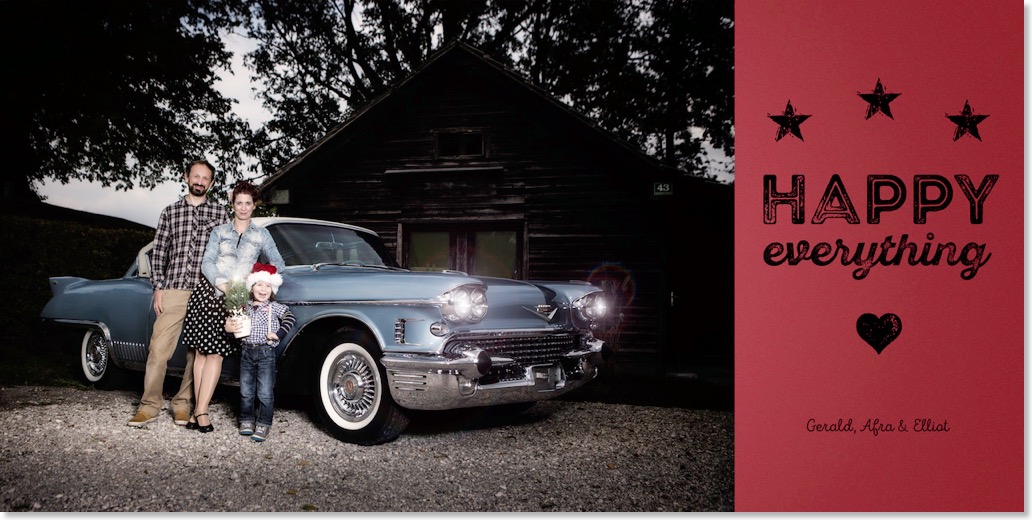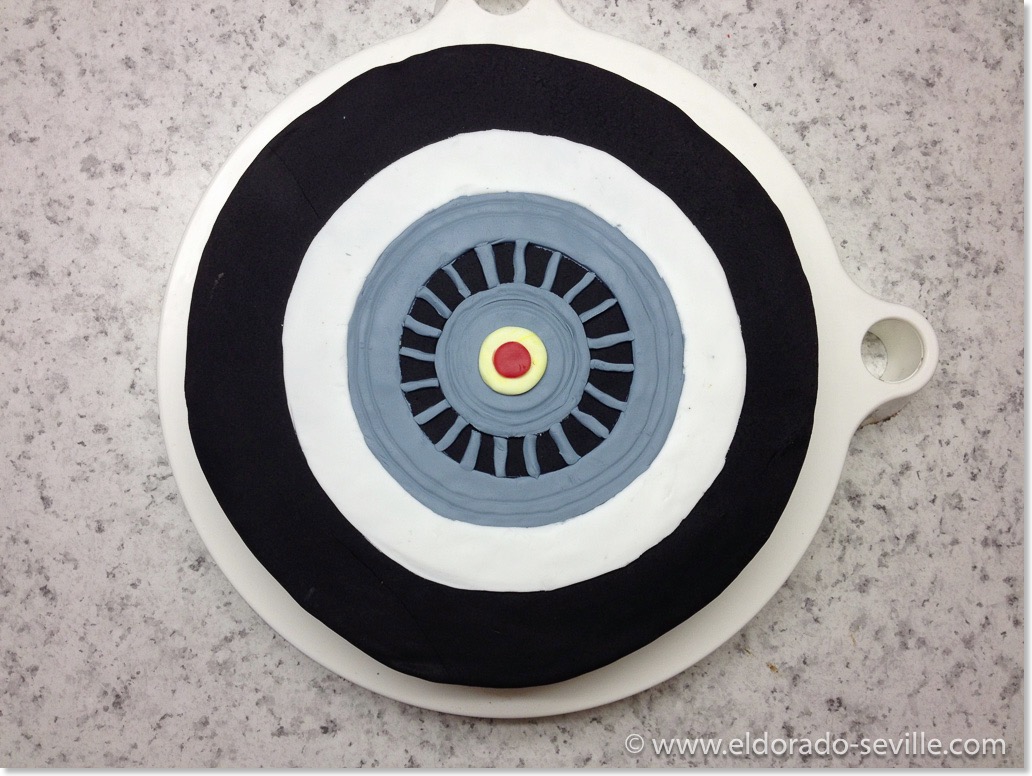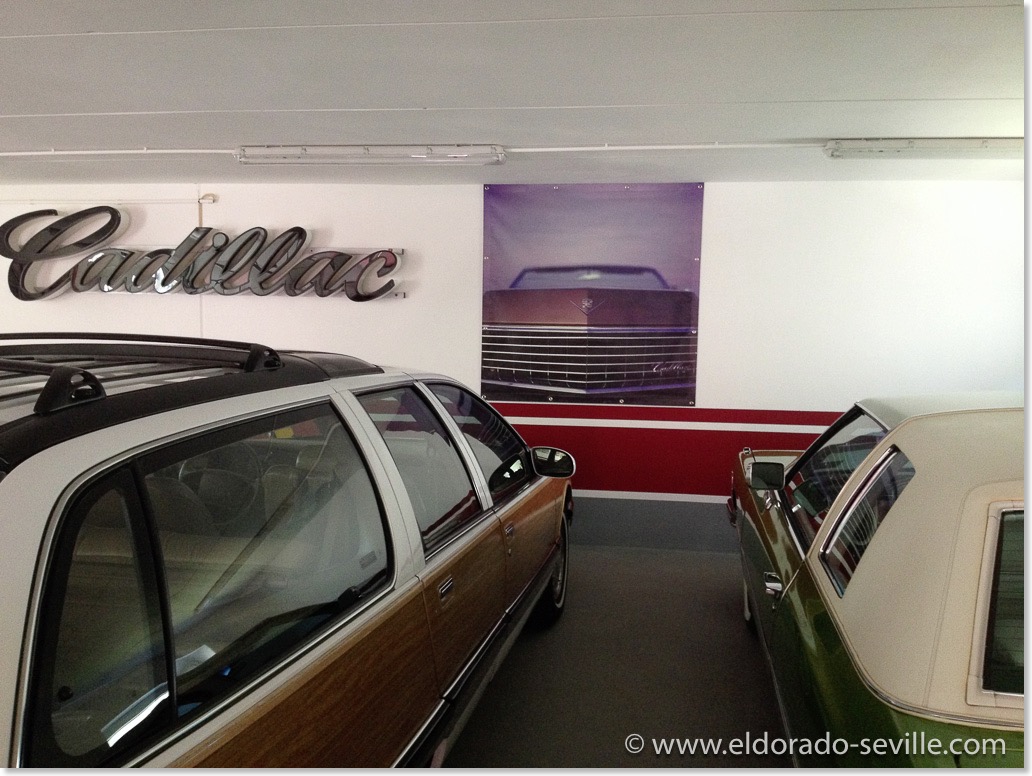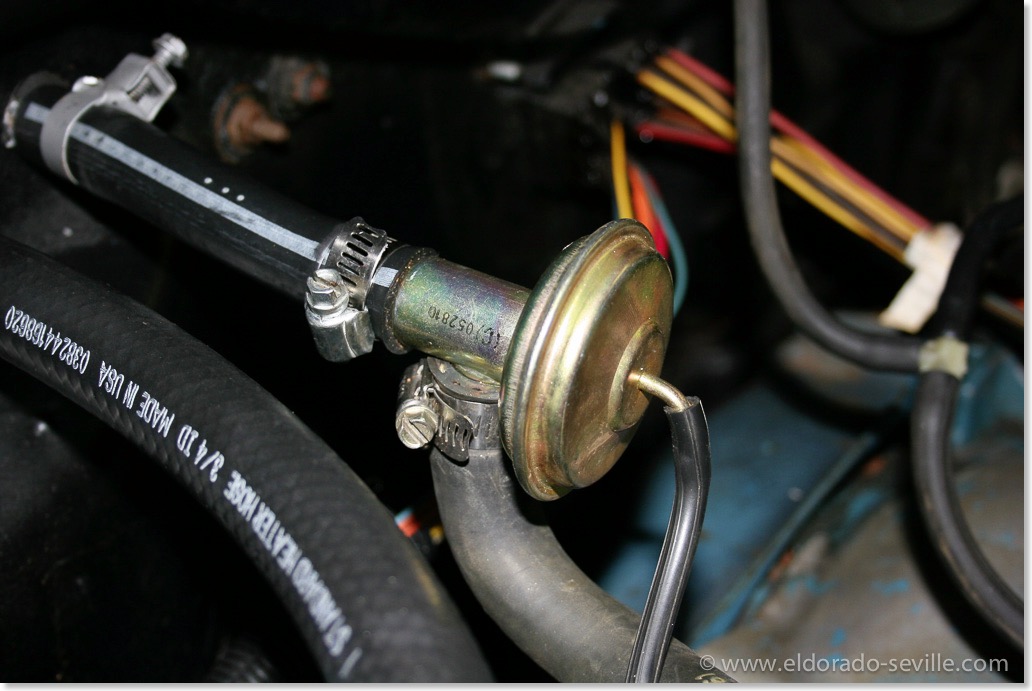SEASON´S GREETINGS
THE 1974 UNDERCARRIAGE RESTORATION PROJECT - I HAVE TO START ALL OVER AGAIN
As I had put so much effort in totally de-rusting the underbody of this low mileage car, I decided to let a professional body shop re-paint the bare metal frame, suspension parts and floor pans this time. My goal was to have the ultimate quality paint job in the factory correct colors underneath the car. I´m not very good in painting and my attempts often result in runnings, which I have to sand out and other imperfections I wanted to avoid.
So I handed the de-rusted car over to the paint shop.
BACK FROM THE PAINT SHOP
When I got the car back, everything looked o.k. as you can see on the pictures below. I was not too impressed by the work they did, as there were quite a few imperfections and some sloppy paint work visible, if you looked very closely. At this point I was already worried that they maybe did some shortcuts before painting, when they should have properly cleaned the bare metal, before they sprayed the primer.
They used some high quality epoxy primer and 2k paint for the job though.
THE MESSED UP ENGINE BAY - OVERSPRAY HELL
There was a terrible mishap at the shop, as they did not mask off the engine bay properly, so all the paint dust and overspray collected inside of the engine bay, and the entire engine bay looked like somebody emptied a spray can into the engine compartment from about 5 feet away. Everything was covered with paint overspray.
I was so shocked when I opened the hood that I almost passed out. The once perfectly clean, all original engine bay was a total mess. It looked so terrible that I could not even snap a picture. Last year I had spent weeks to clean it to my standards…
I had no idea how I could remove the overspray without damaging the original finish of the engine, rubber hoses, cables, wires, accessories and engine parts. This was a terrible situation for me.
REMOVING OVERSPRAY WITH CLAY
I then remembered that detailing clay can be used to remove overspray from paint, but I was not sure if it would work with this heavy amount of overspray. The paint shop gave me a special clay towel to clean up the engine bay, which works like detailing clay, but can be cleaned more often and is easier to use and more aggressive. This thing really works well, but I had to do so much scrubbing on some parts, that some painted areas, like the wheel wells or the air filter housing, turned a little dull after this tiring work. To get them shiny again, I had to hand polish each and every part after claying it. It took me about 25 hours to remove all the accessible overspray from inside the engine bay. I had to thoroughly scrub each and every part, wires and hoses with the clay towel and all purpose cleaner as a lubricant. The areas which I could not clean good enough by hand will be cleaned with dry ice soon. I´m 100% confident that it will look as good again as it did before this happened - I have already achieved 90%, the rest will get perfect again with some dry ice cleaning…
TIME FOR UNDERCOATING
My plan is to protect the undercarriage with a transparent undercoating, which is as good as invisible if properly applied. It will provide a perfect protective shield against road debris, stones and is rust prohibitive. This high-tech material is far superior than the original tar based undercoating which is normally used, and as an additional bonus you can always see what is going on underneath the undercoating. I decided to use a product from a german company called "Timemax USB Clear". Timemax is one of the leading specialists for rust protection, and their products have won some independent tests, done by classic car magazines.
THE PAINT DOES NOT STICK!
Before spraying on the undercoating, I had to mask off the areas like the frame, drive shaft, axle, suspension parts, fuel tank, brake lines, hoses and brakes. After a day of masking off all the areas, I discovered a small paint chip on the frame. When I inspected it with my fingernail, a bigger chunk of paint flaked off the frame. I then used a scraper to scrape the paint, to see if it was just a small area where the paint would not stick properly. The area where the paint came off got bigger and bigger, and soon it became clear that the paint does not stick properly anywhere…
Of course this was another big shock for me, as this meant that 3 months of work were completely destroyed… When I inspected the areas underneath the removed paint, it quickly became clear that the paint shop did not treat and clean the bare metal before painting, as they should have done. They just did a quick wipe with silicone remover.
Of course the bare metal underneath a 41 year old car is full of oil and grease and needs a lot of cleaning with strong chemicals before paint will adhere to it. Unfortunately they skipped this most important step. Although I brushed away all the rust and everything looked shiny, the oil and grease is in all the pores of the metal.
I HAVE TO START ALL OVER AGAIN - REMOVING THE FRESH PAINT AGAIN
This now means that ALL the paint they sprayed on has to come off once again. Also the brown paint on the floor pans has to be stripped again as well.
I asked a dry ice cleaner to try if it can be removed with his method, and it soon became clear that it is possible, but will take at least one full working day, and this will cost a small fortune.
There will probably be some areas left which I will have to rework by hand.
As you can imagine, this is a huge step back for me. I worked so hard and so many hours, often till late into the night, to finish this project for nothing …
The paint shop knows that they did a lousy job and is very supportive to resolve this issue.
This video shows how badly the paint sticks to some of the frame parts. It can be blown off with the pressurized air on some areas…
WHAT´S NEXT?
Before dry ice blasting the undercarriage once again, we will try to get the paint off with a powerful high pressure washer. Once the paint is gone again, we will clean the bare metal multiple times with acetone, marine clean, a special metal cleaner and metal prep. We will also sand everything with some coarse sandpaper to get a little rougher surface to make sure that the paint adheres much better next time.
I also want to go for a black with less gloss, as it was too glossy and did not look correct.
I hope that the weather will be good enough in January 2016, so that I can start all over again. At the moment I do not have the motivation to do anything on the car, and I do not even want to look at it, as it hurts too much. I still have to recover from the things that have happened. This is so frustrating. I hope that it will look like it should after the second attempt.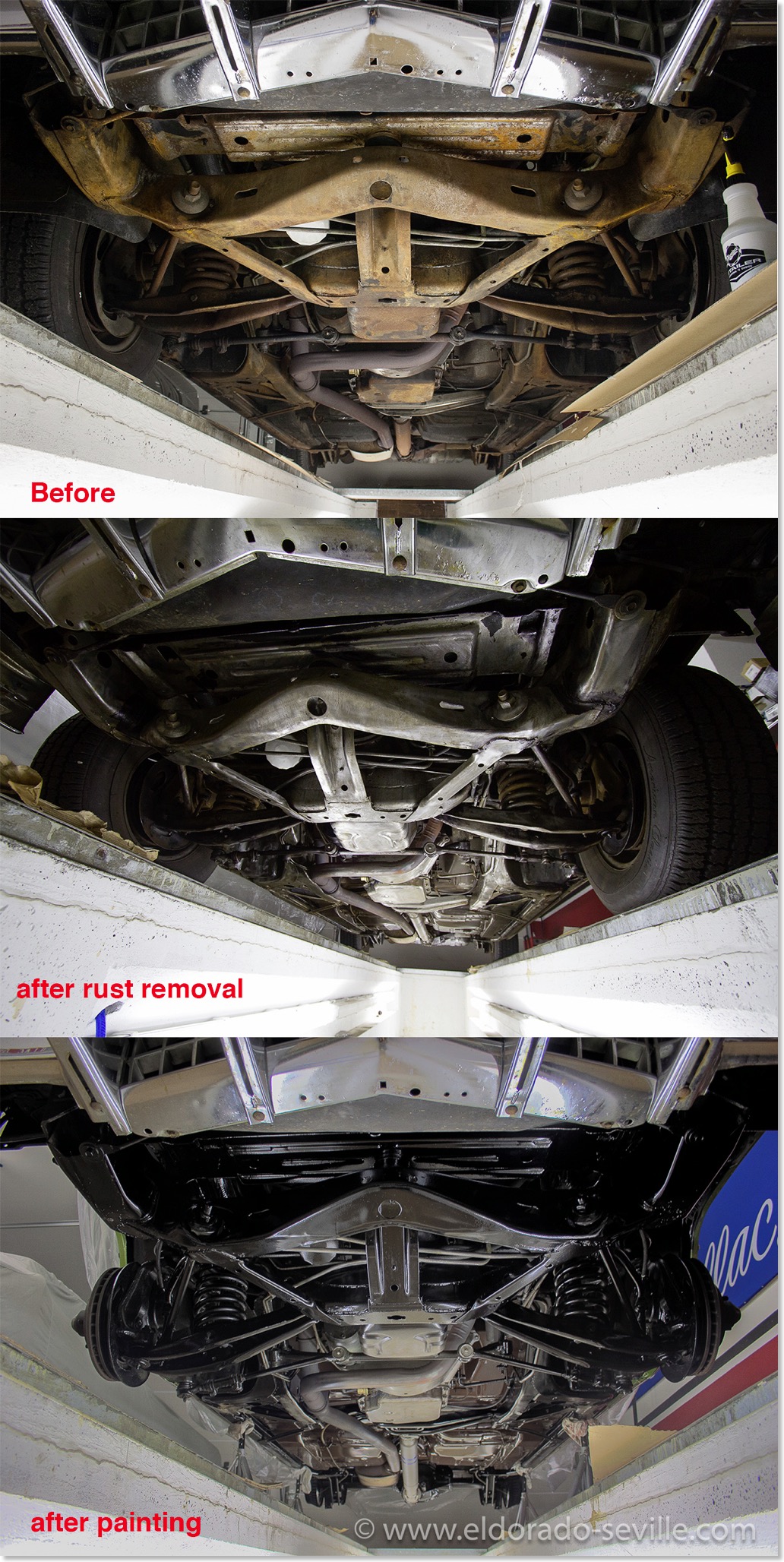
The 3 stages of the project so far.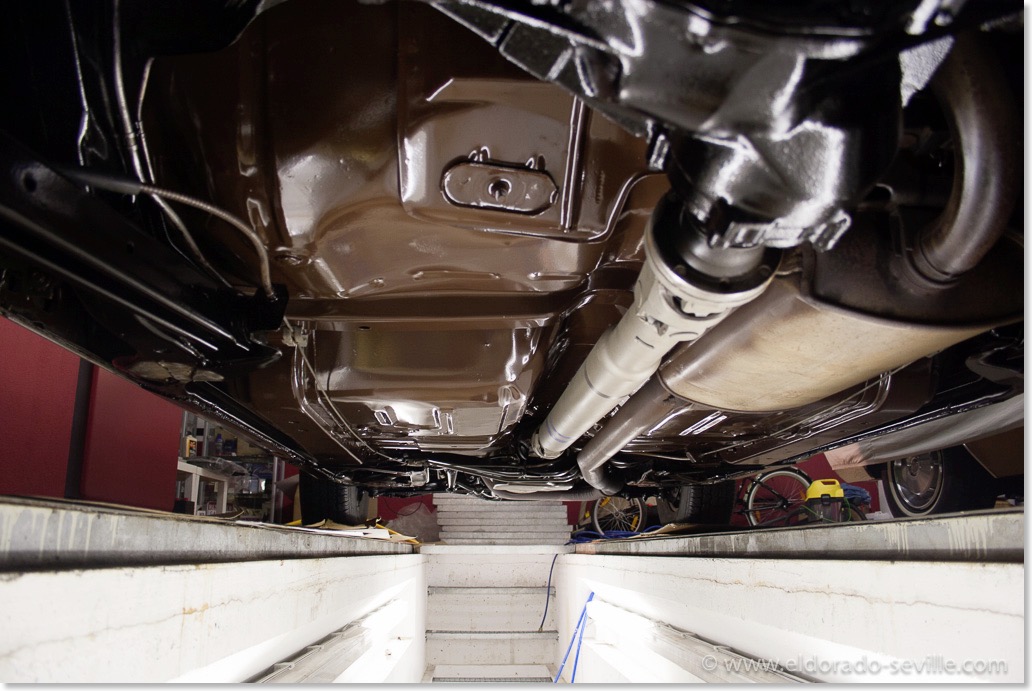
Everything looked o.k. after painting, but the paint does not stick to the metal due to poor cleaning by the paint shop.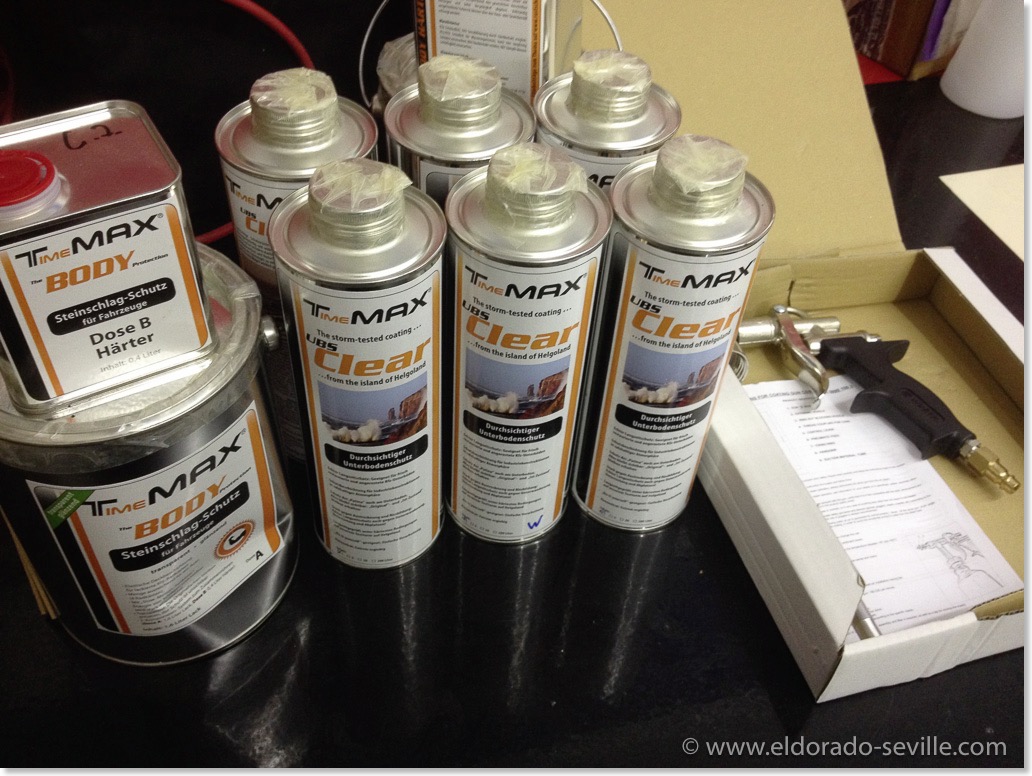
This is the transparent undercoating I wanted to apply when I found out that the entire paint on the undercarriage does not stick…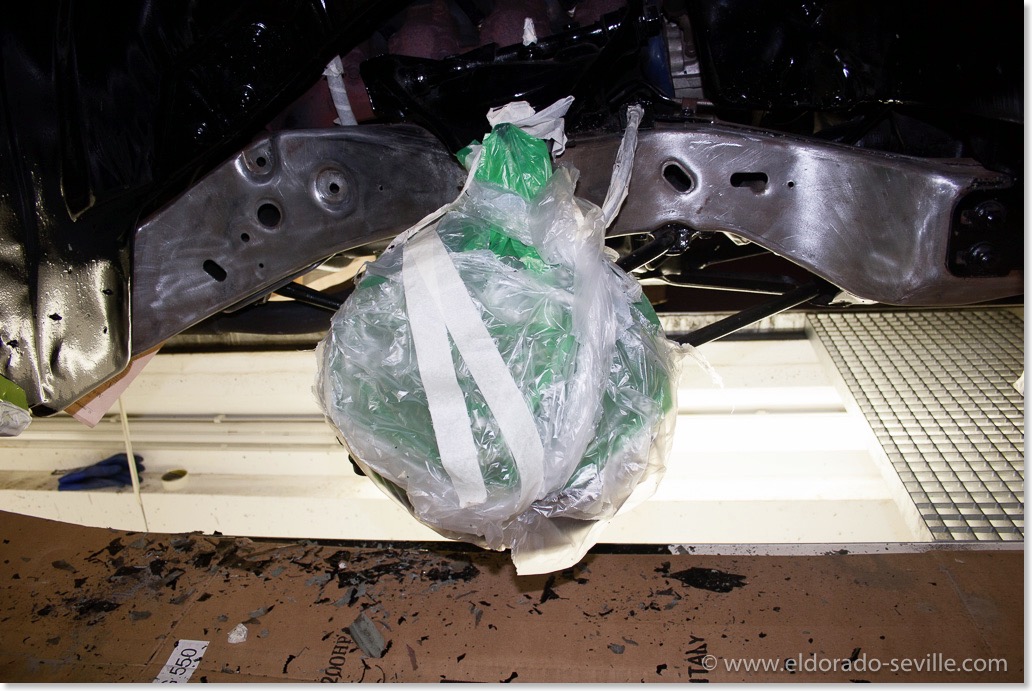
Unfortunately the paint does not stick to the bare metal… I could scrape it of with a simple scraper. You can see all the flaking paint on the floor…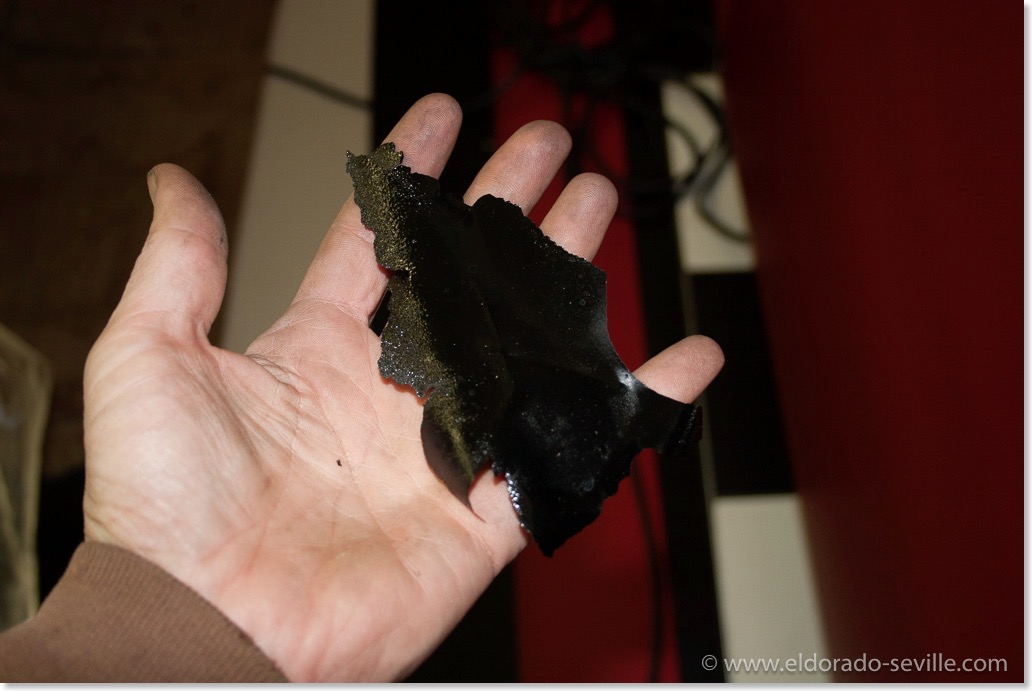
The paint is peeling off in big chunks…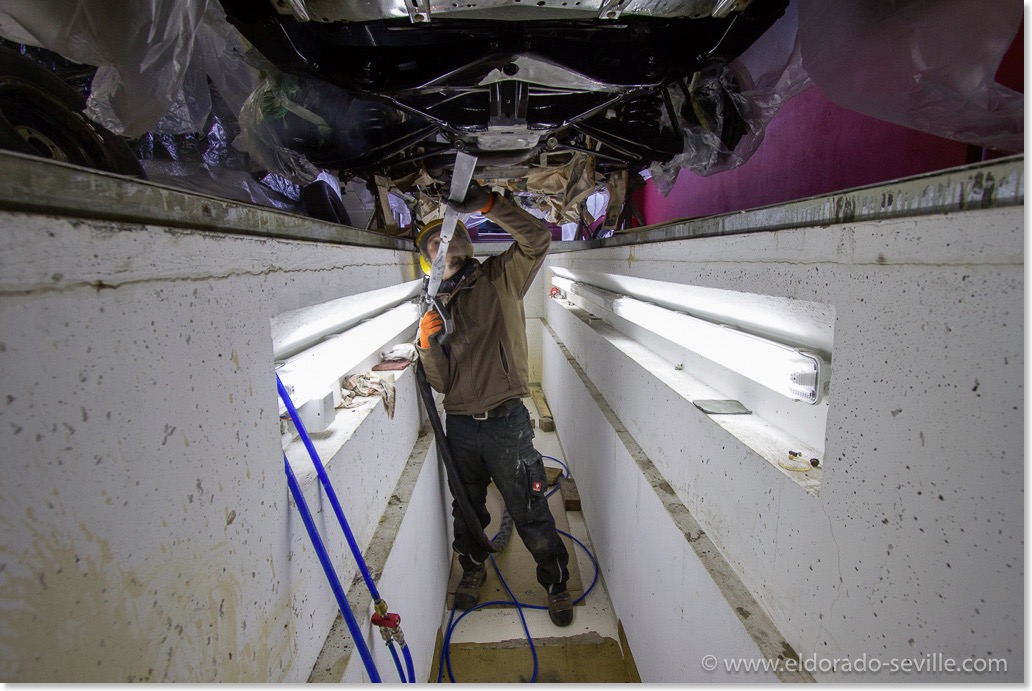
So ALL the new paint has to come off again. Here the dry ice blaster is trying if it can be removed with dry ice cleaning.
BE CAREFUL WITH ZINC PLATED PARTS AND RUST REMOVAL SOLUTIONS
Due to all the problems I had, I completely forgot about some fasteners from the rubber splash guards, which I had soaked in the rust remover solution for more than a week. This long time in the liquid removed all the surface rust, but the acid also ate away the zinc plating. So whenever you try to remove the rust from anodized fasteners and screws, make sure not to soak them for too long.
As I can´t get the fasteners and screws very easily here in Austria, I had to brush away the remnants of the zinc coating with a wire brush, and then painted everything with Eastwoods Silver Cad paint. This does not look 100% correct of course, but will have to do until I find some original replacement hardware. Besides a few washers, these fasteners won´t be visible anyway.
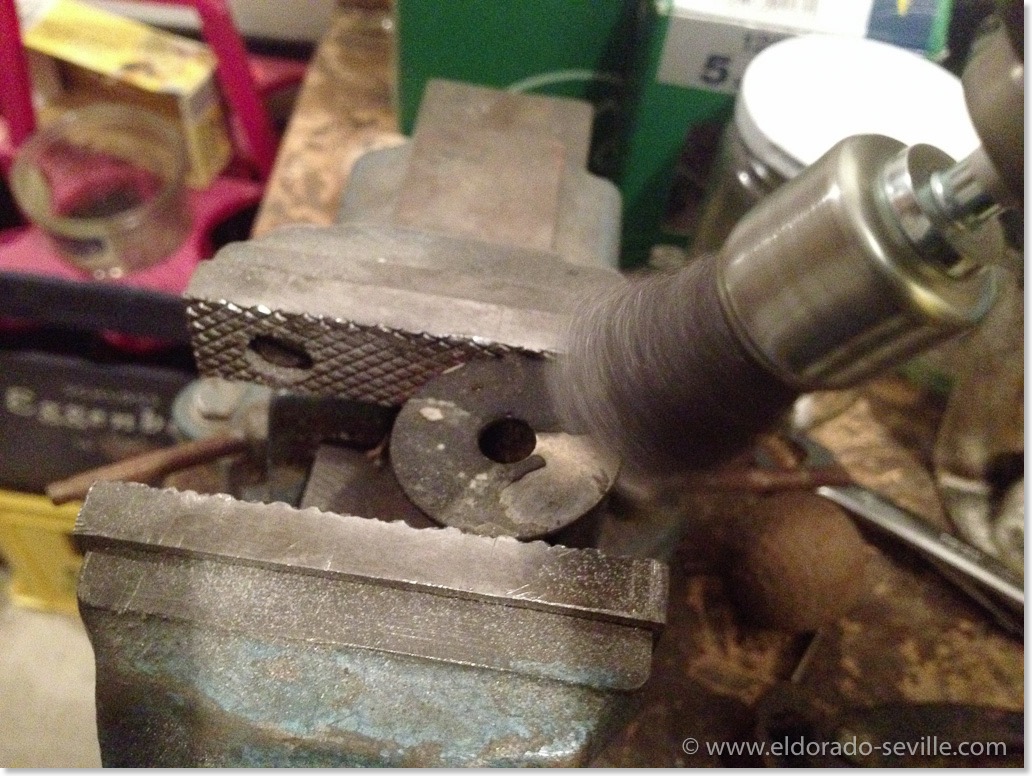
I forgot some of the fasteners for the rubber splash guards in the rust dissolver solution. It ate away the zinc plating. So I had to remove the remains of the zinc plating with a wire brush.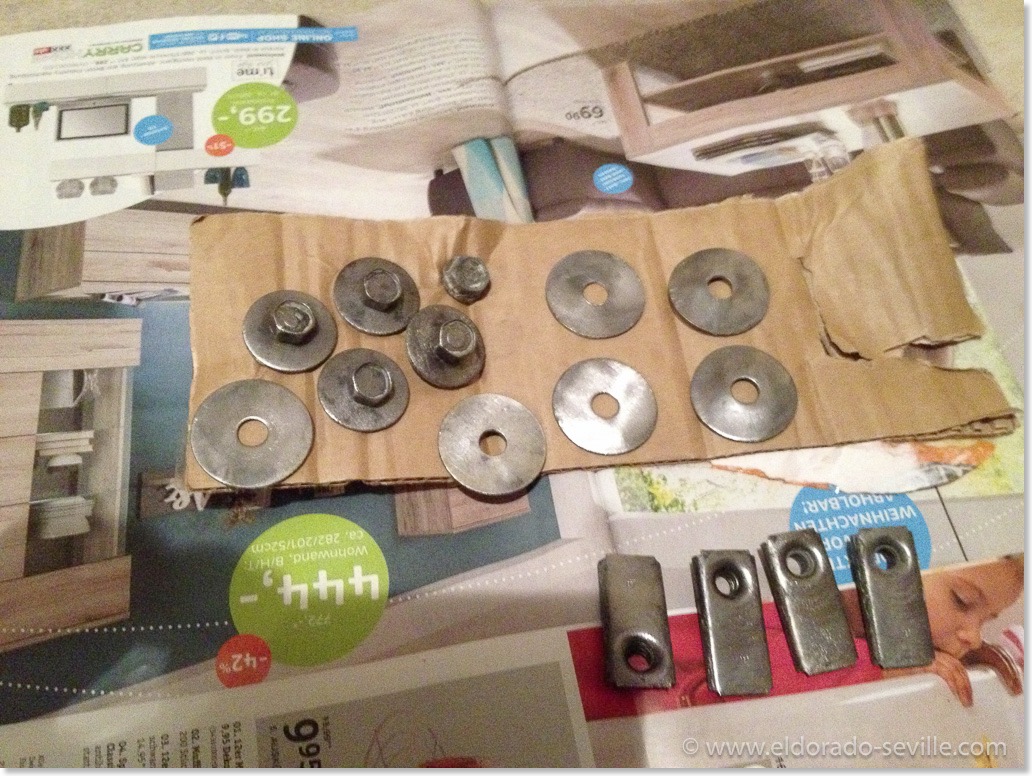
The cleaned fasteners. I spray painted them afterwards with Eastwood zinc paint.
THE 1974 ´S UNDERCARRIAGE GETS REPAINTED
Now that I had removed ALL the rust over the last few weeks the underbody needed a fresh coat of paint.
After dry ice cleaning some light surface rust also showed up under the rear quarter panel ends, the fender skirt area and the lower front fender. All these areas were attacked by water, road debris and other stuff coming from the wheels. These areas suffer the most. Also moisture got trapped underneath the body moldings in this area.
When we removed the moldings fortunately nothing really serious showed up, but only some small spots needed a little attention, more as a preventive and cosmetic measure to make sure that rust can´t spread underneath and show up when its too late to fix it.
The downside of this repair is that I had to sacrifice a small percentage (maybe 5%) of the original paint on the rear quarter panel up to the belt line molding. I do not like this fact very much, as I prefer original paint over repaints, but the other option would only have been to wait for rust damage to happen eventually, but therefore have 100% original paint on the car… As I intend to drive the car I wanted to have everything fixed as good as possible.
A friend of mine is a professional body man, and I asked him to take over from me and do the painting and body work, as I do not have the expertise and skills to do this myself.
The floor pans are now repainted in the correct shade of satin brown, which he had to custom mix, based on "Chocolate Brown" which is a little too bright and contains too much red.
Then the floor had to get taped off again to paint the frame and suspension parts in satin black.
We will even go so far to replicate the factory flaws like green overspray in the rear wheel housings for the authentic look and to remember how these cars were built in 1974…
Next up was the repaint of the repaired areas of the sheet metal in “Persian Lime“. He found the formula for this special green in his computer database and he sprayed a test sheet which was an almost perfect match. He then had to find the perfect match by himself. He succeeded and found the perfect color and the repairs are now invisible. It was my biggest concern that he would have trouble to get the color right and gave me some sleepless nights…
Once the car will be back home, I will re-paint the brake parts in a bare metal look and rebuild the brakes while everything is apart. I also already have new shocks waiting for installation, I will put in new brake hoses, repair the radio and heater core and do a good general tune up and change all fluids. So next spring I should have a car which looks and drives like new :-) You can find all the pictures of this project in a gallery here.
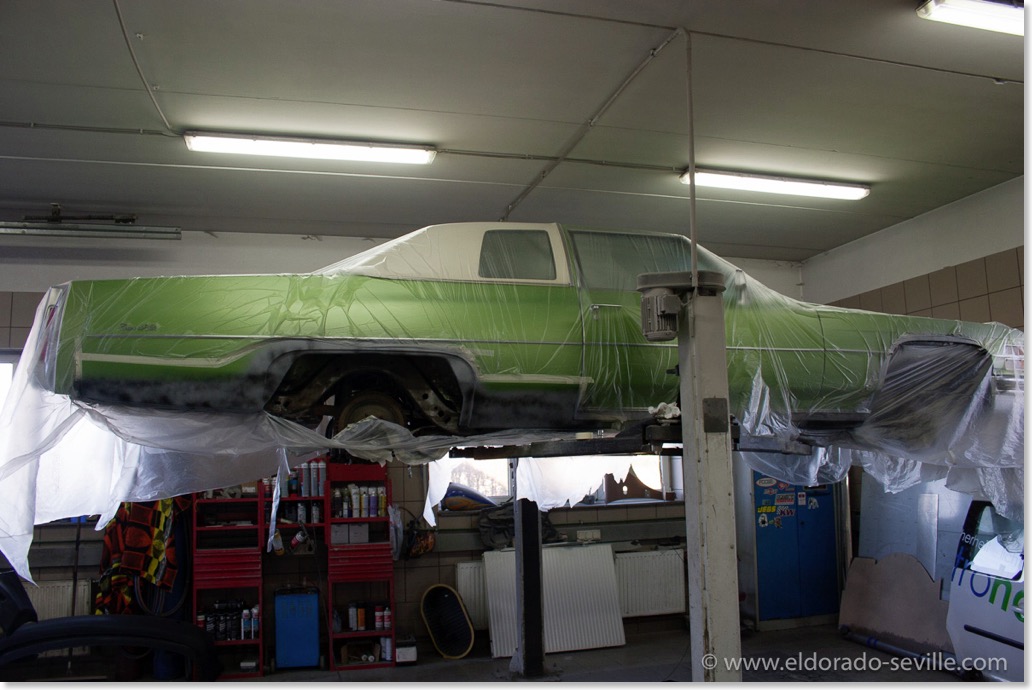 The Cadillac in the paint shop.
The Cadillac in the paint shop.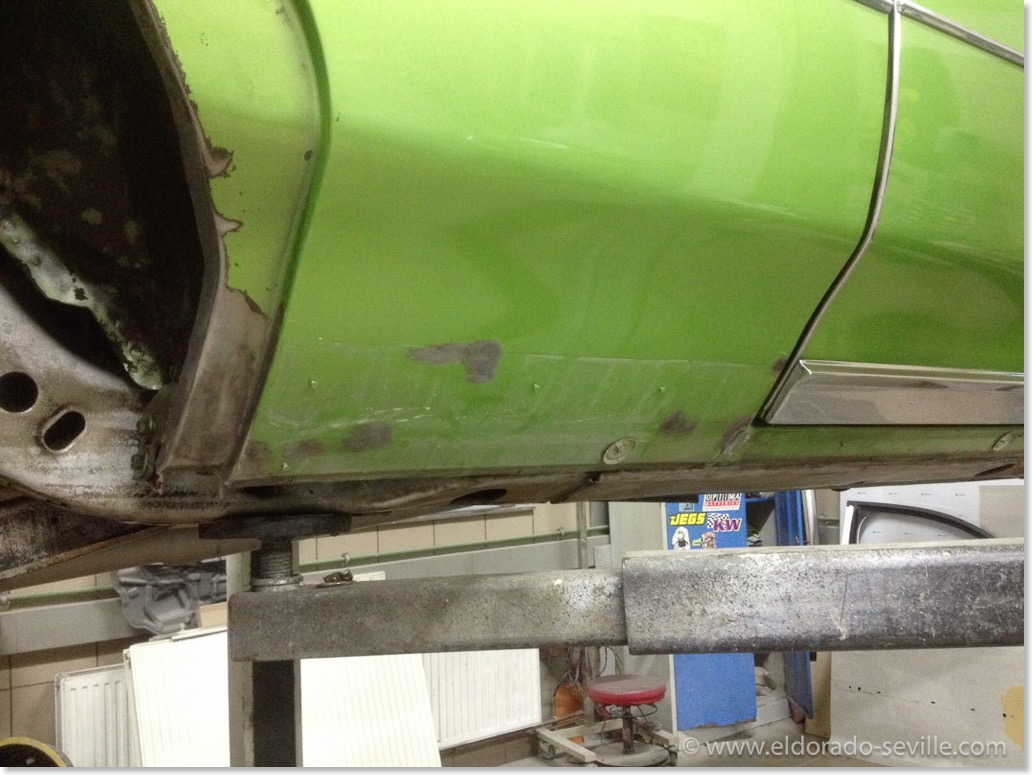
This are the areas on the sheet metal that needed some attention. Nothing serious - but better to fix it now before a problem arises eventually in the future. Here the lower trim is removed to see what is going on.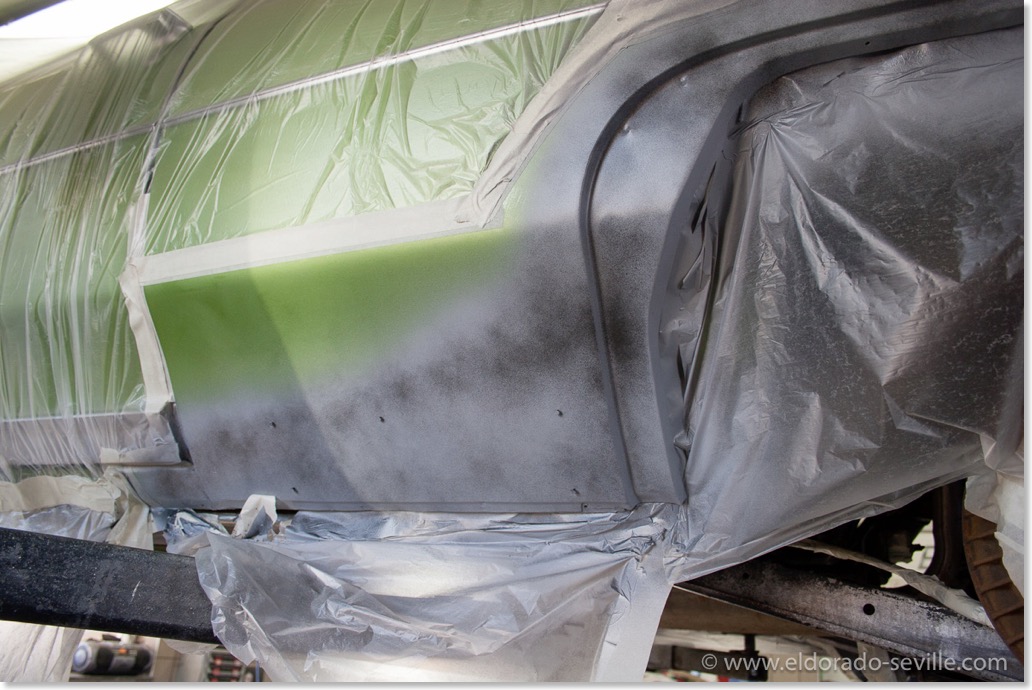
The lower edge behind the rear wheels had suffered a bit over the last 41 years... I decided to have it fixed properly and sacrifice a little of the original paint for this. Also the area around the fender skirts needed a little attention to look like new again. No real severe rust issue, but more of a preventive and cosmetic measure... Fender skirts will be repainted as well... On this picture you can see the primer and a very small amount of filler for a perfect surface.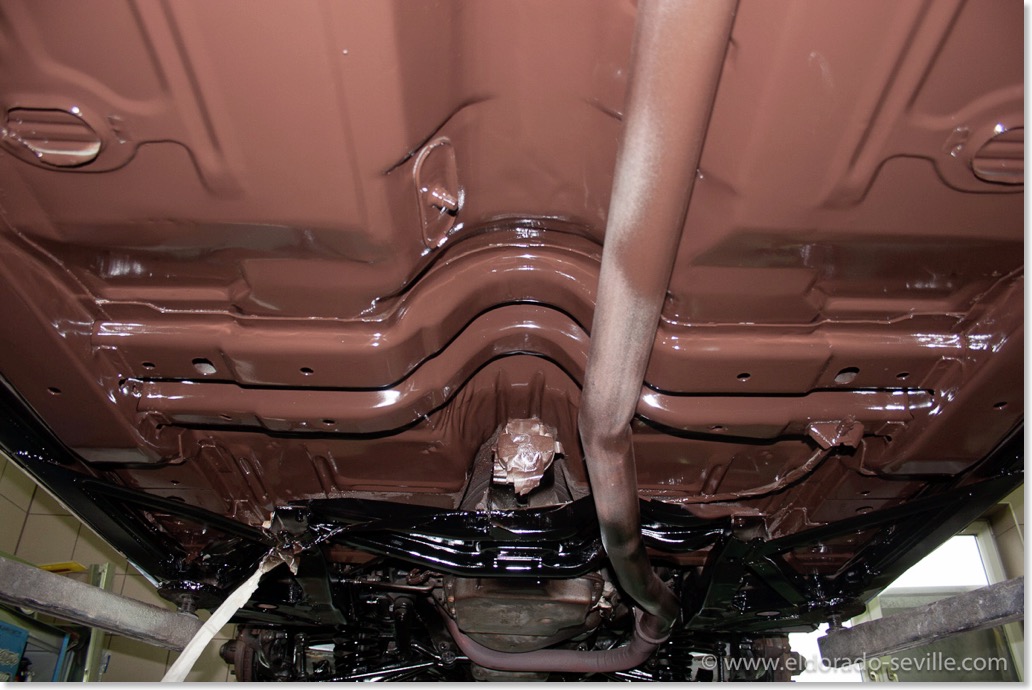
The floor pans are now repainted in the correct shade of brown. It will get a little less glossy once the 3 coats of transparent undercoating are applied.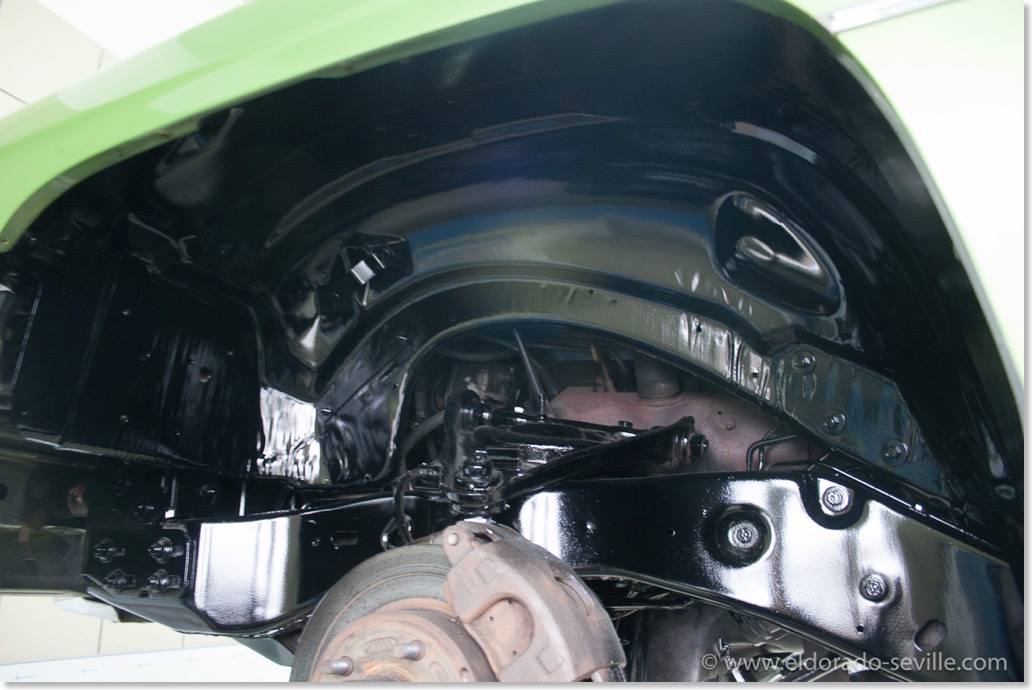
The wheel housing after the first coat of satin black.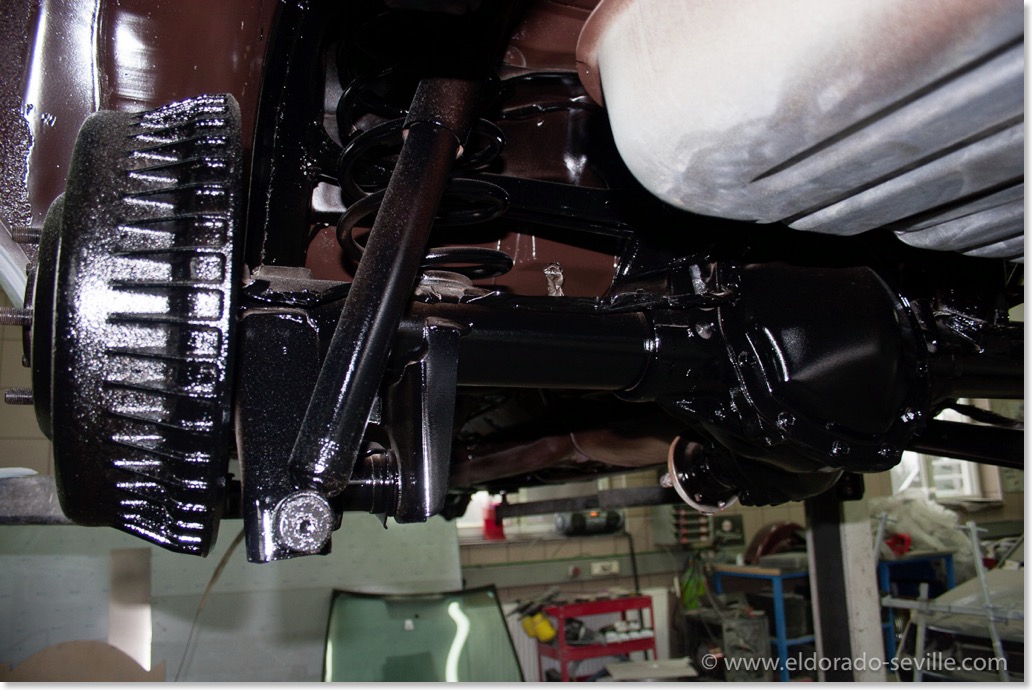
The rear axle is back in black. I will paint the rear brake drums in a bare metal look later once the car is back home.
I will also install new shocks and paint the tank with Eastwood Tank Tone paint.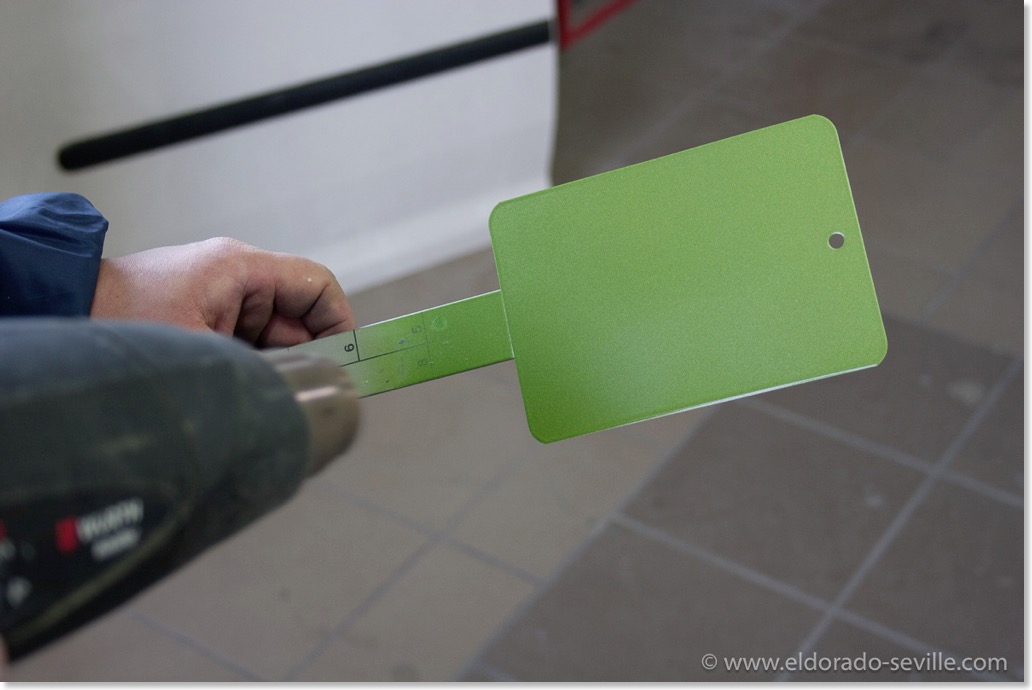
Finding the right shade of Persian Lime for a perfect match. The computer had the color in the system and it already was a very good match.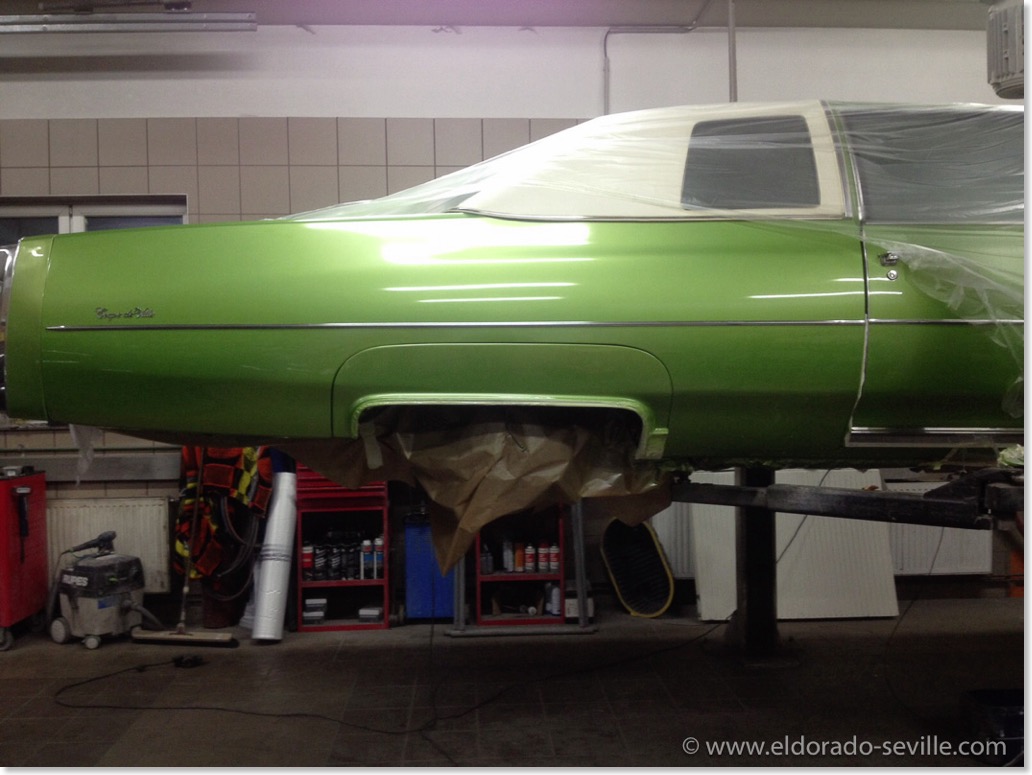
The paint shop found a perfect match for the Persian Lime paint. Great job Jürgen!
You can find all the pictures of this project in a gallery here.
DETAILING THE 1974 CADILLAC DRIVESHAFT
When the car was built, Cadillac and all other car companies did not bother to protect the bare metal driveshafts in any way, so they already had surface rust on them when they were delivered new…
My initial plan was to use a wire brush to knock of the rust and just paint it black like most people would do.
But I then decided that I wanted to go the extra mile, do it properly and put it back into the condition it was when it was built.
I wanted to remove the rust chemically in a rust dissolving fluid that is normally used for de-rusting fuel tanks, but I had no idea how I could soak such a long piece in this fluid.
I came up with the idea to just use a big tarp and put some wood to the sides, put the driveshaft in it and fill it with rust removing liquid. This worked out really well.
It took about 48 hours until all the rust was gone.
After a little of the rust was gone I discovered the remains of the 3 factory markings on the drive shaft. There were three rings painted onto the shaft - two in blue and one in black. I found some small traces of the paint during rust removal. I wanted to re-apply them once the shaft was finished.
When the shaft was fully de-rusted I found out that flash rust would come back literally after only a few minutes. Thats why I decided to paint the shaft to replicate the factory appearance.
I used Eastwood Detail Gray to mimic the original look of bare metal. Before applying the paint, I used self etching primer on the bare metal.
When all the paint was dry, I added the finishing touches with the three color rings.
I´m very happy how it turned out - it looks great. You can see more pictures of this project here.
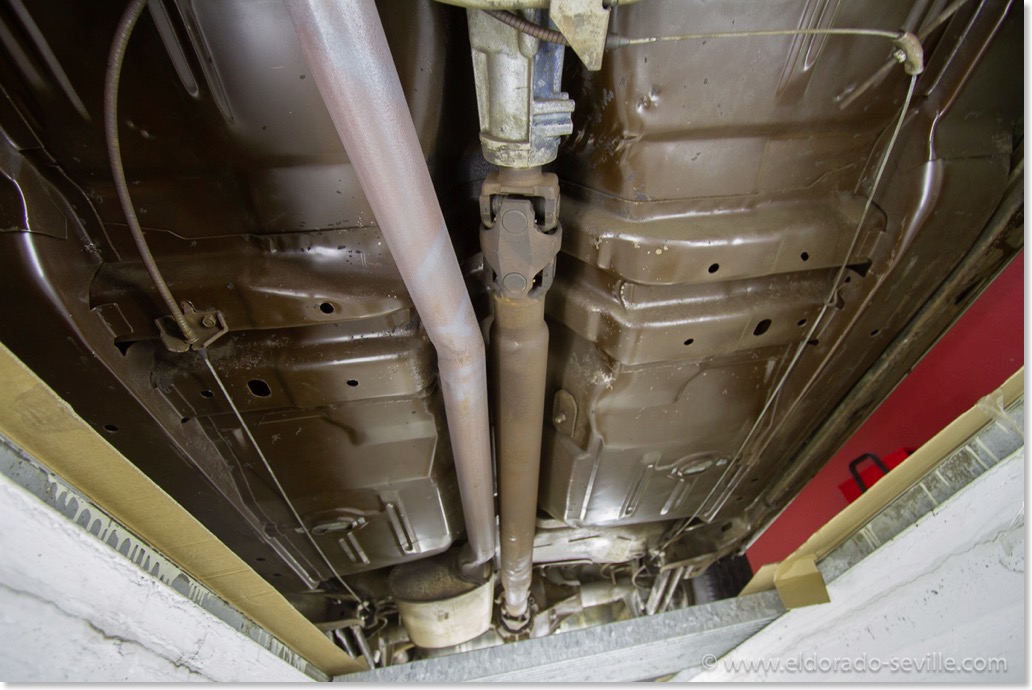
The driveshaft before…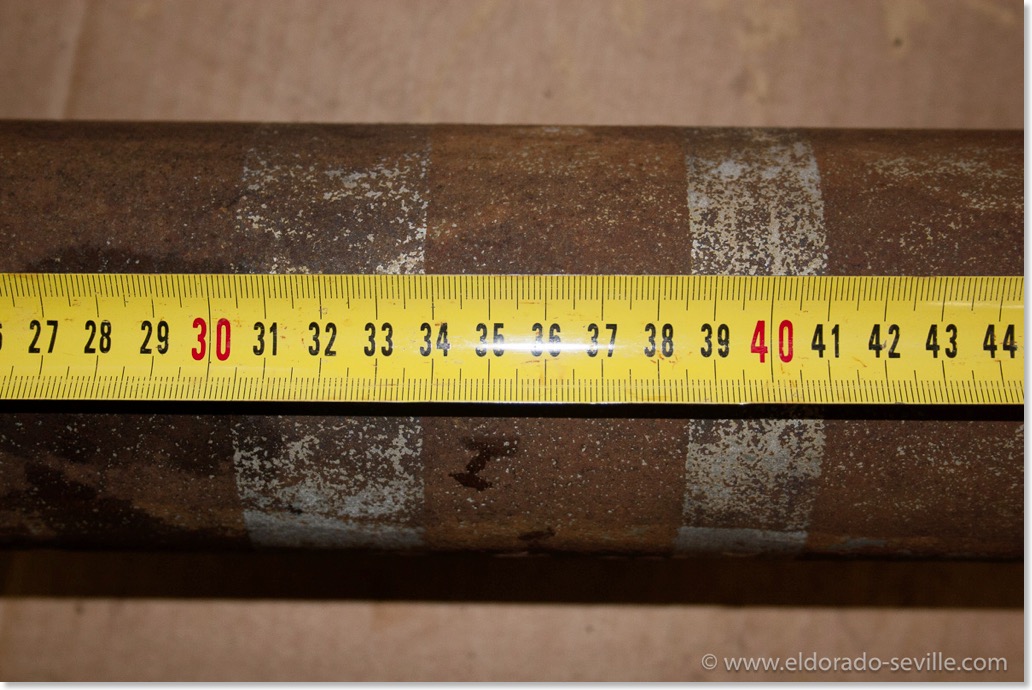
The location of the first two factory markings. I measured them to make sure that I could replicate them when I painted the driveshaft. The first two markings were (light) blue. 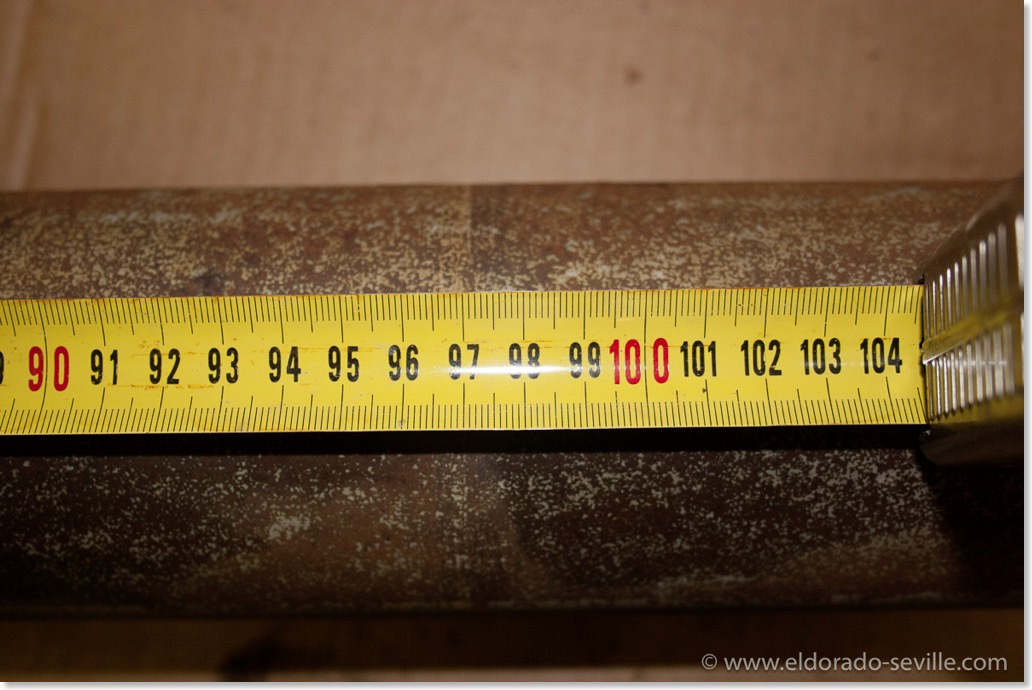
The location of the third factory marking. I measured it to make sure that I could replicate it once I painted the driveshaft. This marking seemed to be black once.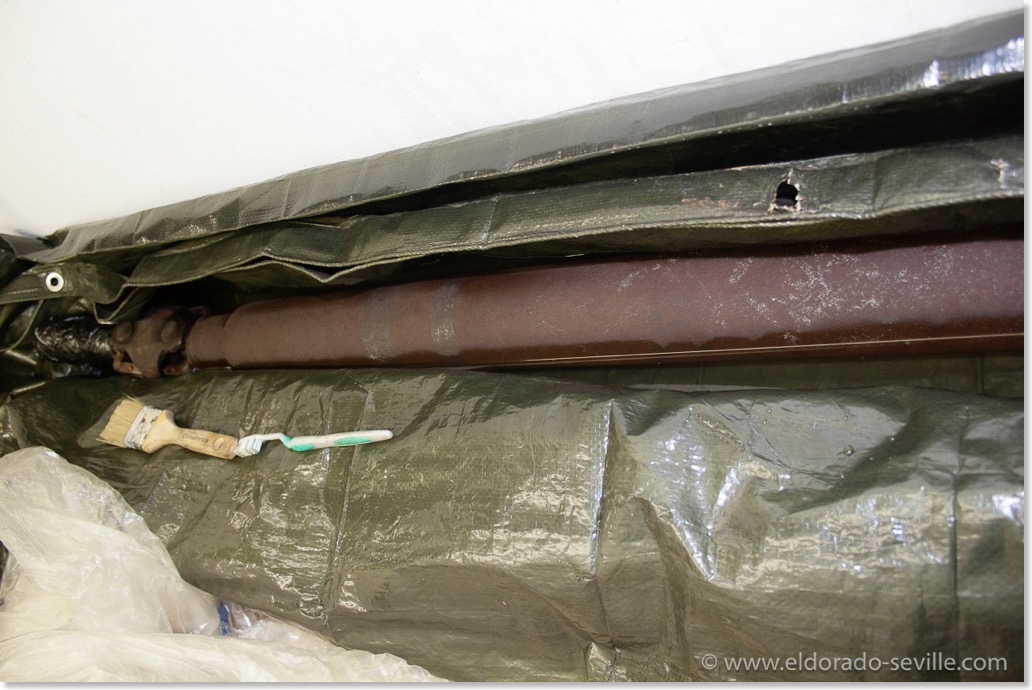
I soaked the driveshaft for 48 hours in rust removing liquid and used these two brushes to agitate it into the rust.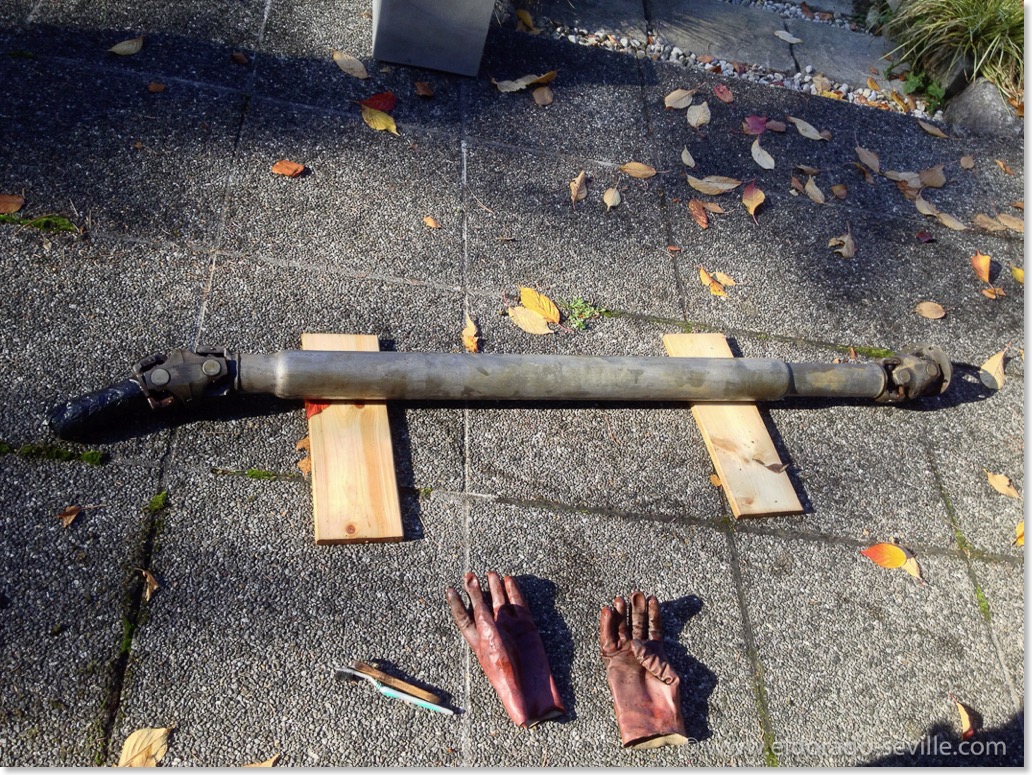
This is how it looked after soaking for 48 hours. All the rust was completely gone and only bare metal was left.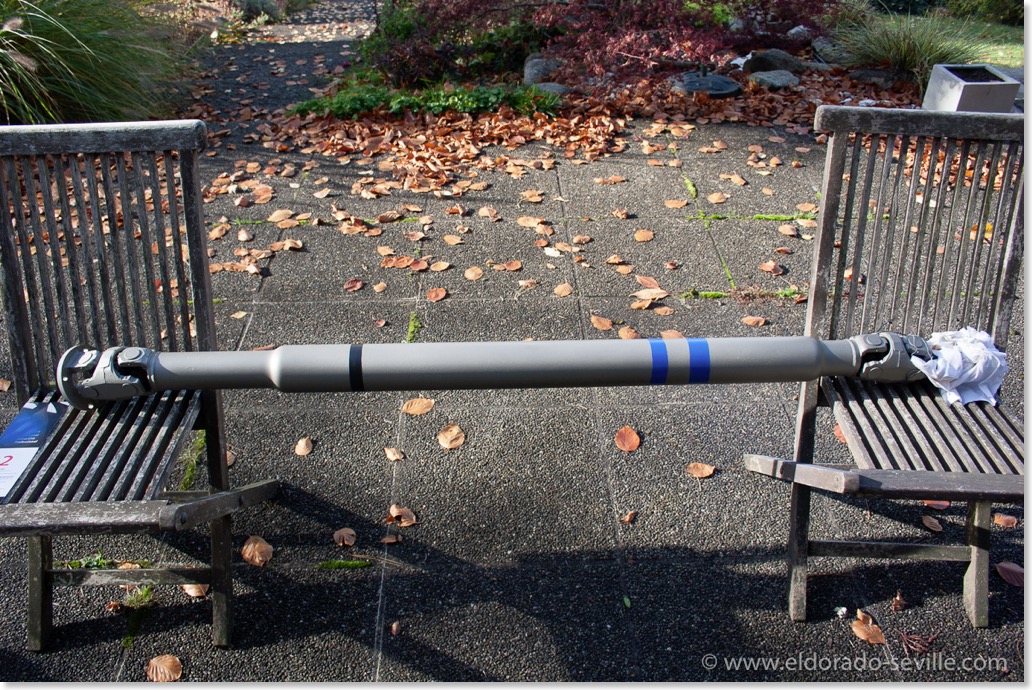
The finished drive shaft.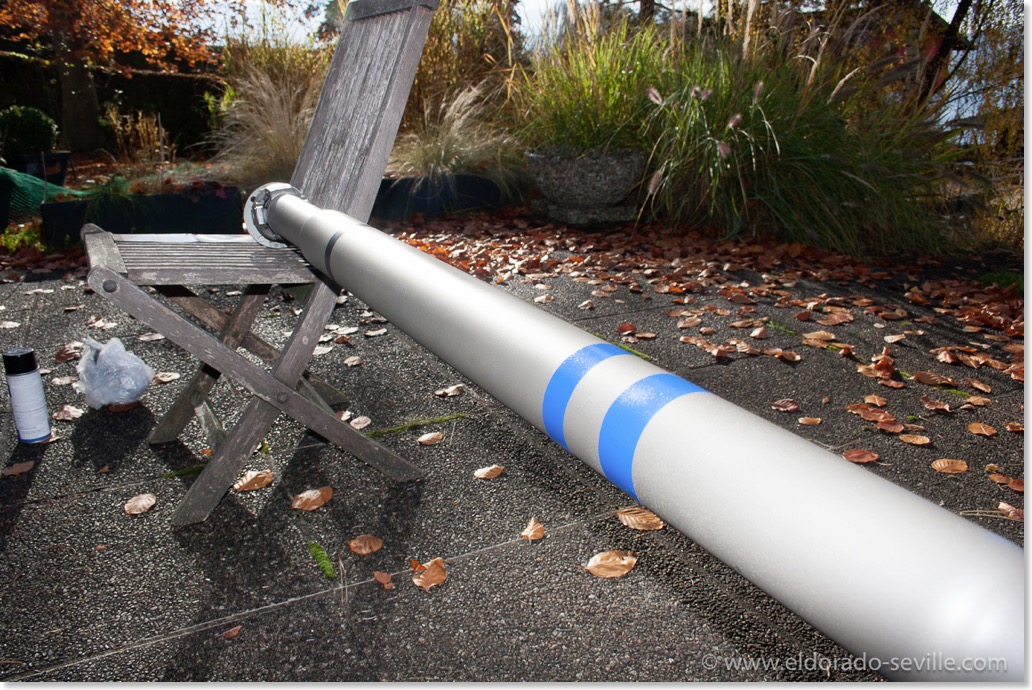
The replicated factory markings on the drive shaft. The correct shade of blue color was only a good guess - I think it comes pretty close to the traces of paint I had found.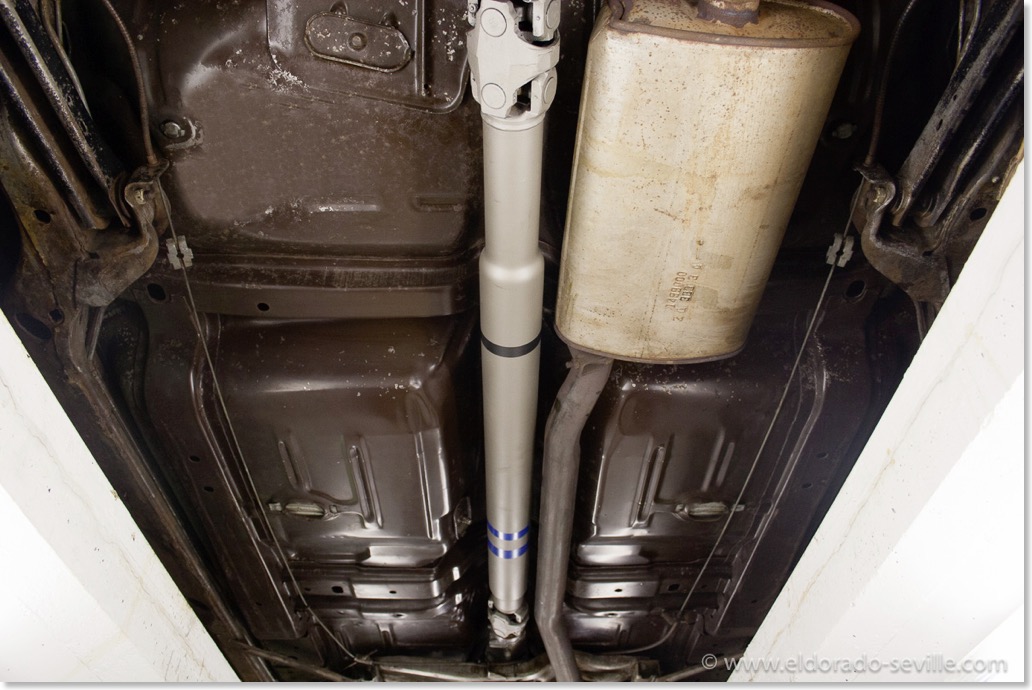
Back in the car to be able to move it around.
DRY ICE BLASTING THE UNDERCARRIAGE OF THE 1974 CADILLAC
As I want to do it as perfectly as possible, I wanted to remove all the undercoating which was applied when the car was new.
I do not like rubberized undercoating, as you cannot see whats going on underneath. It can trap moisture and once it flakes off due to corrosion, there is already some major damage in the metal underneath.
There are different methods for removing the undercoating and most of the methods are a pain in the a**.
This stuff can be removed with a scraper and chemicals, or with heat and a scraper. Both methods will damage the metal underneath and scratch the paint on the underbody, and it takes forever…
As I did not want to use any of the methods mentioned above, I decided that I wanted to try dry ice blasting.
Dry ice-blasting is a form of carbon dioxide cleaning, where dry ice, the solid form of carbon dioxide, is accelerated in a pressurized air stream and directed at a surface in order to clean it. An alternative media for non-abrasive blasting is water-ice, known as ice blasting.
The method is similar to other forms of abrasive blasting such as sand blasting, plastic bead blasting, or soda blasting but substitutes dry ice as the blasting medium. Dry-ice blasting leaves no chemical residue as dry ice sublimates at room temperature.
Dry-ice blasting involves propelling pellets at extremely high speeds. The actual dry-ice pellets are quite soft, and much less dense than other media used in blast-cleaning (i.e. sand or plastic pellets). Upon impact, the pellet sublimates almost immediately, transferring minimal kinetic energy to the surface on impact and producing minimal abrasion. The sublimation process absorbs a large volume of heat from the surface, producing shear stresses due to thermal shock. This is assumed to improve cleaning as the top layer of dirt or contaminant is expected to transfer more heat than the underlying substrate and flake off more easily. The efficiency and effectiveness of this process depends on the thermal conductivity of the substrate and contaminant. The rapid change in state from solid to gas also causes microscopic shock waves, which are also thought to assist in removing the contaminant.
Unlike abrasive media blasting you cannot remove rust with dry ice blasting.
I found a company through the website of a classic car club, which is only a little over an hour away. I wanted to have it done before the first snow and as soon as possible, so that I could continue working on my car during the winter. The owner of the company did a great job. He is a very friendly and competent gentleman and it was a pleasure working with him.
Here is a short video how it was done: (make sure to watch in HD for proper image quality)
You can find all the pictures I took today in my restoration album.
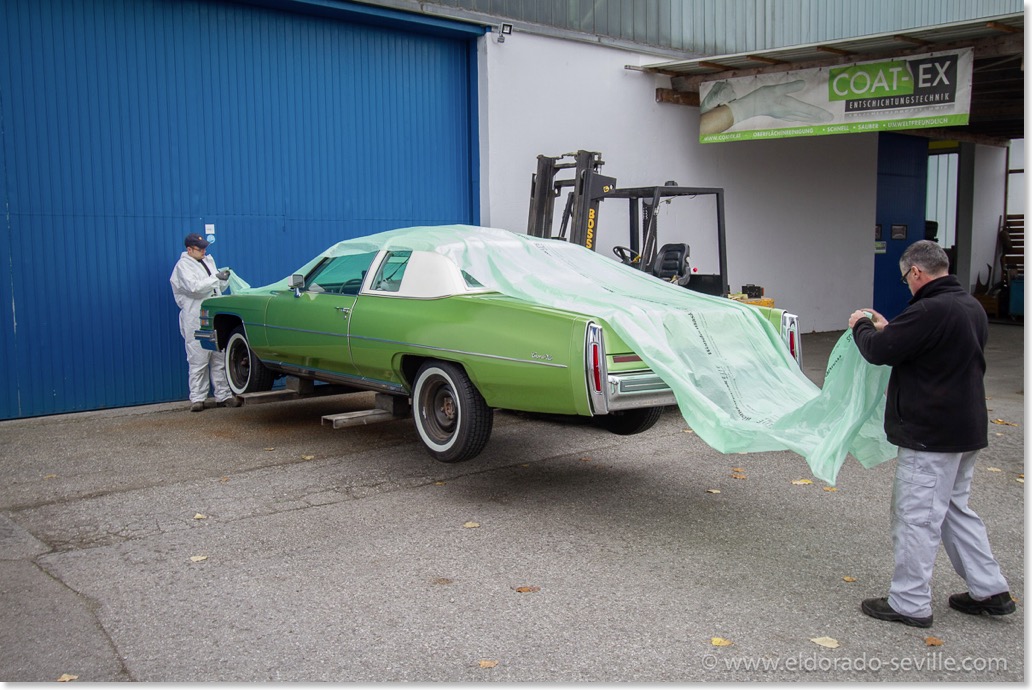
The car was lifted with a forklift and then covered in plastic.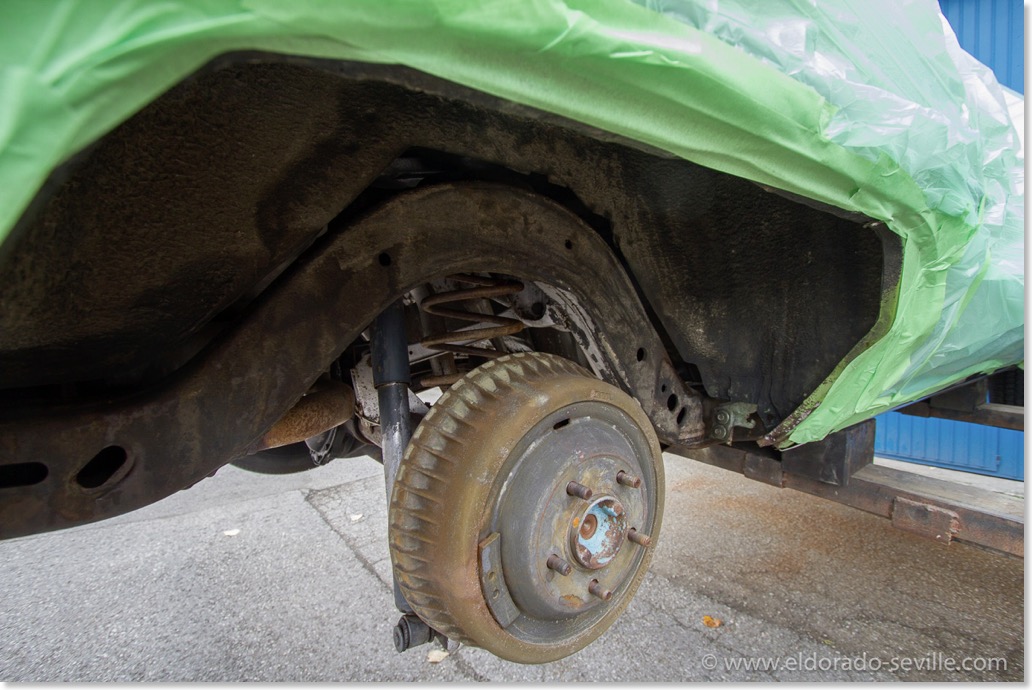
One of the rear wheel-housings before blasting - you can see the undercoating everywhere. 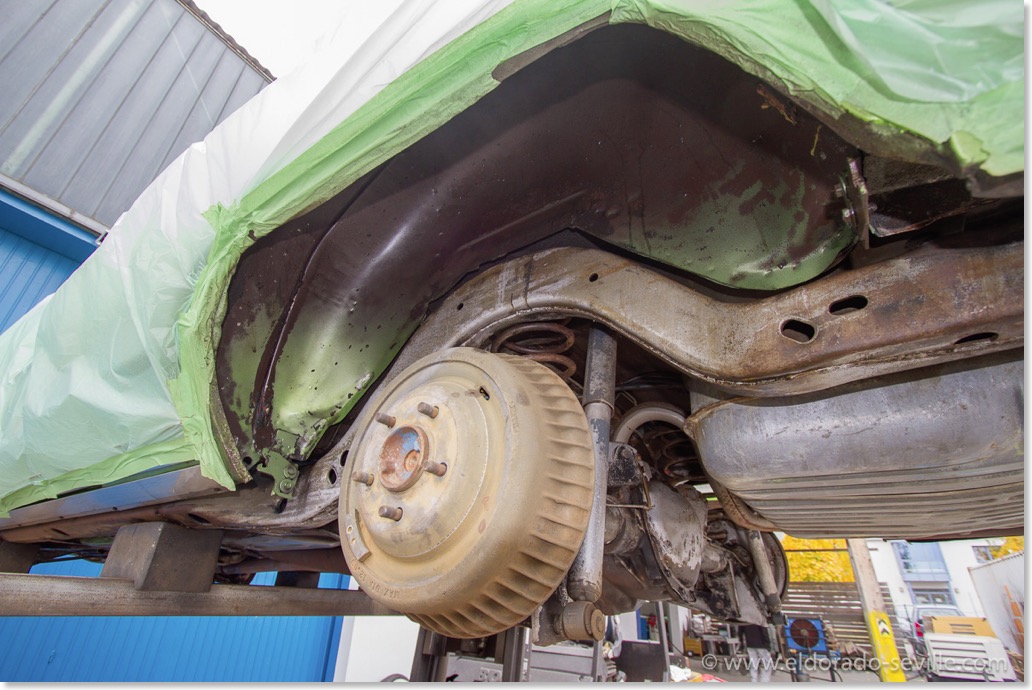
The same wheel housing after blasting - all the original paint was still very well preserved under the undercoating. As you can see originally the wheel housing was brown. During painting a lot of overspray from the body landed in the wheel housing. Then Cadillac added rubberized undercoating to protect the metal from stone chips and to keep the car more quiet. Luckily there is no rust to be found anywhere.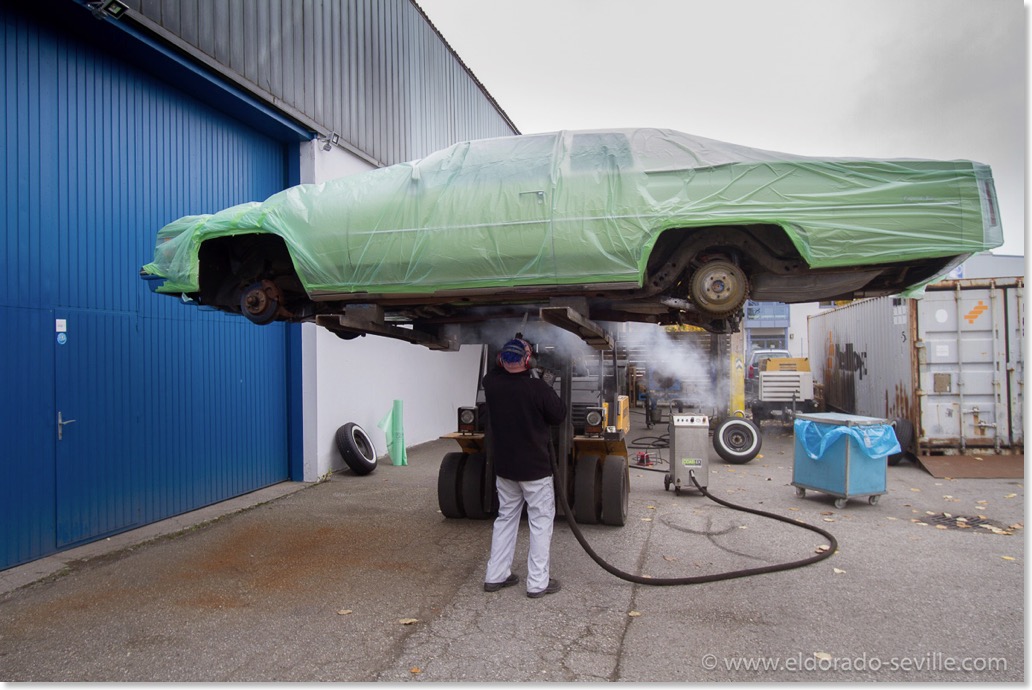
During blasting.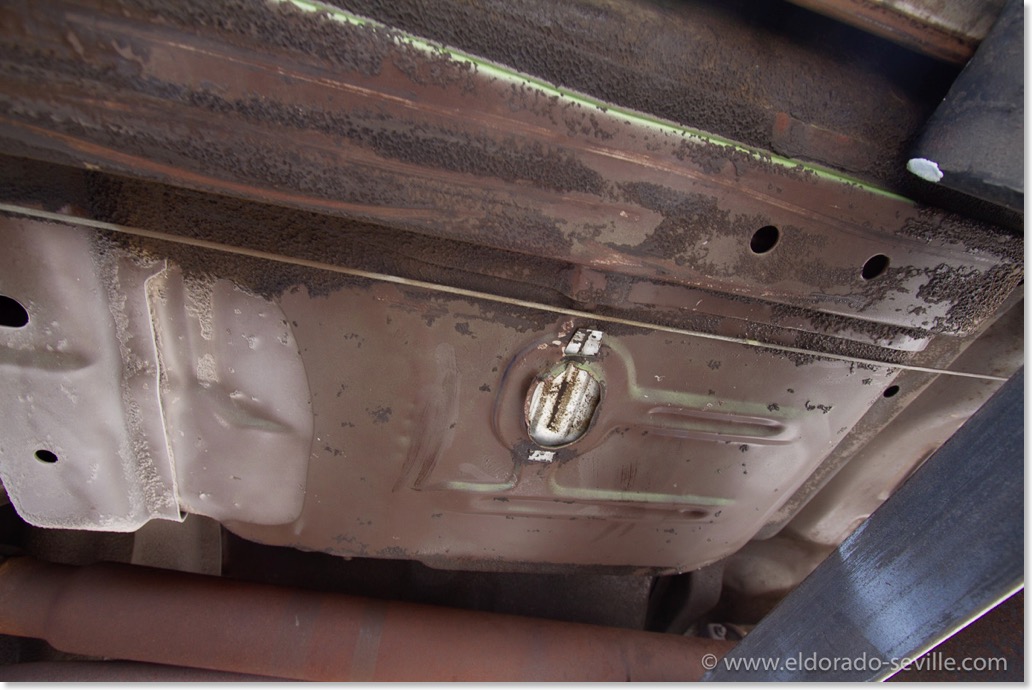
The original brown paint showed up underneath the undercoating. The paint is still in perfect condition. 
The original paint showed up underneath the undercoating in the wheel housings as well.
After cleaning - it came out really nice! I will touch up some areas and conserve the others with a special transparent coating.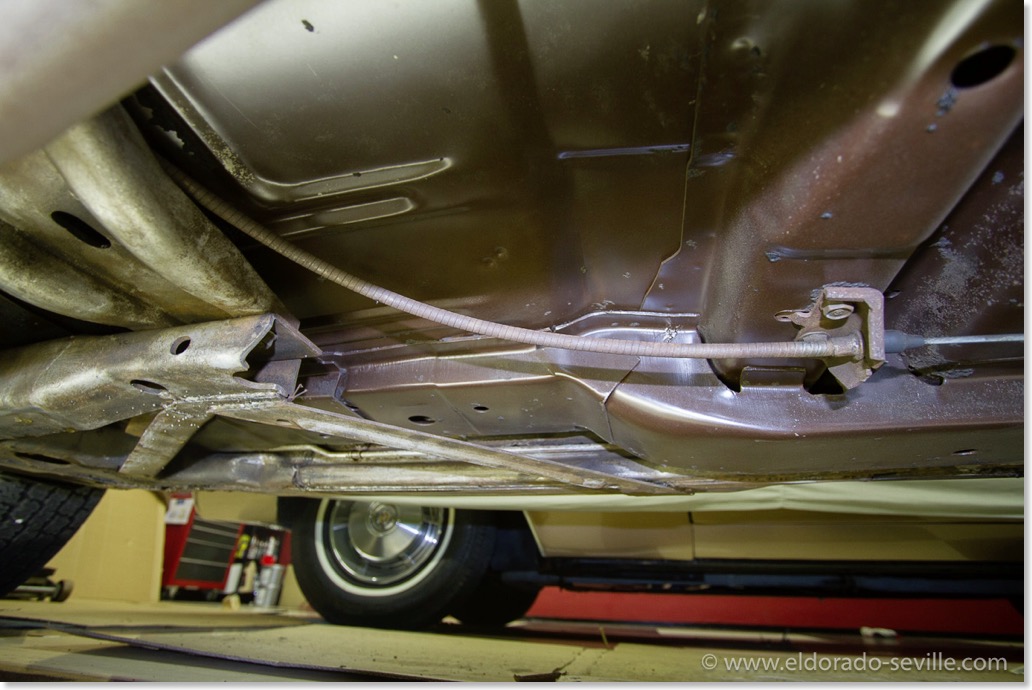
I´m very happy with the result of the cleaning and will now have to protect everything and paint some areas.
REMOVING RUST FROM THE UNDERCARRIAGE WITH RUST REMOVING LIQUID
I´m using a german product called "Rostio" - it's a concentrate used for de-rusting fuel tanks. You have to mix it with hot water. I have also heard great things about Evapo Rust.
I let my system run for days until all the surface rust was gone. The advantage is that the liquid can now get everywhere and should remove the last little piece of rust.
You will be surprised how well this works. This area now looks like a new car. There is not the slightest trace of rust to be found after 12 hours of spraying the car.
After spraying it with the rust remover you then have to flush it with water thoroughly and then dry it properly to avoid flash rust.
I also used various wire brushes and other abrasive materials to remove rust and strip bad paint.
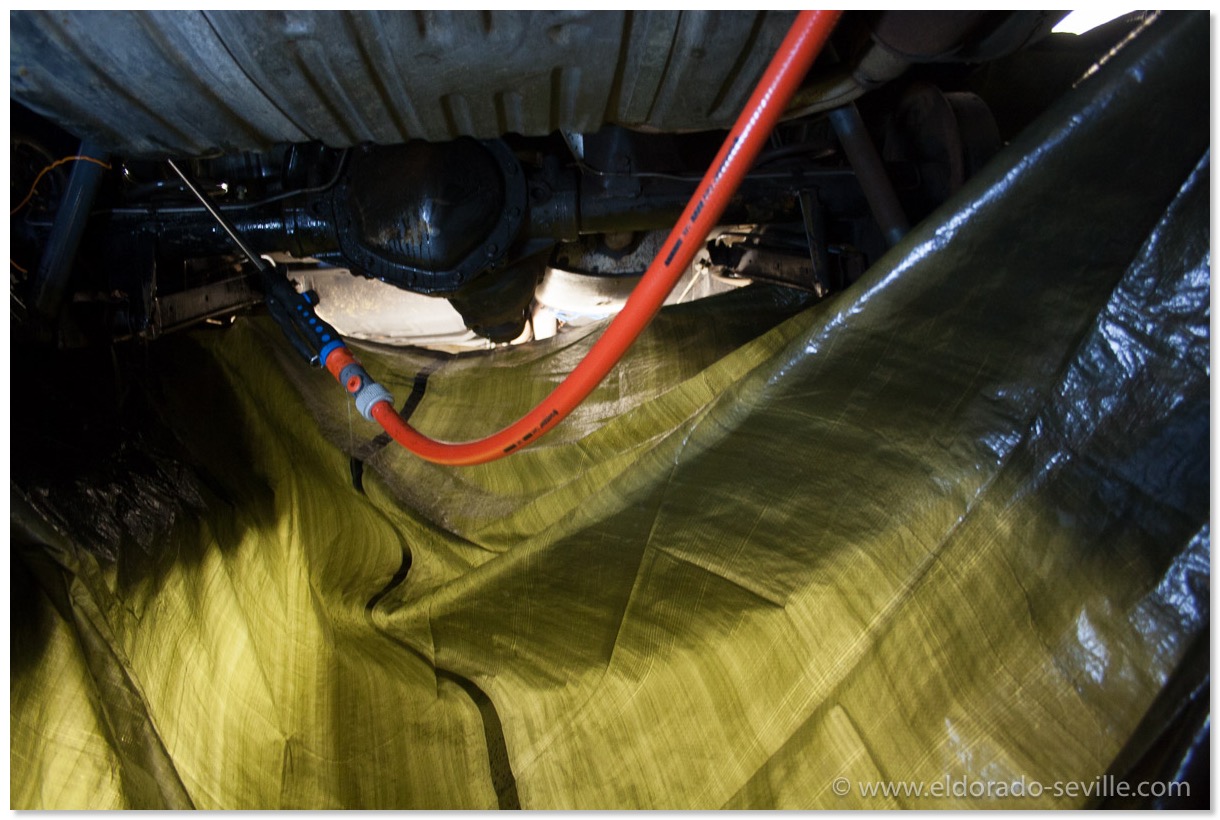
I simply used a garden hose and shower to spray the rust remover on.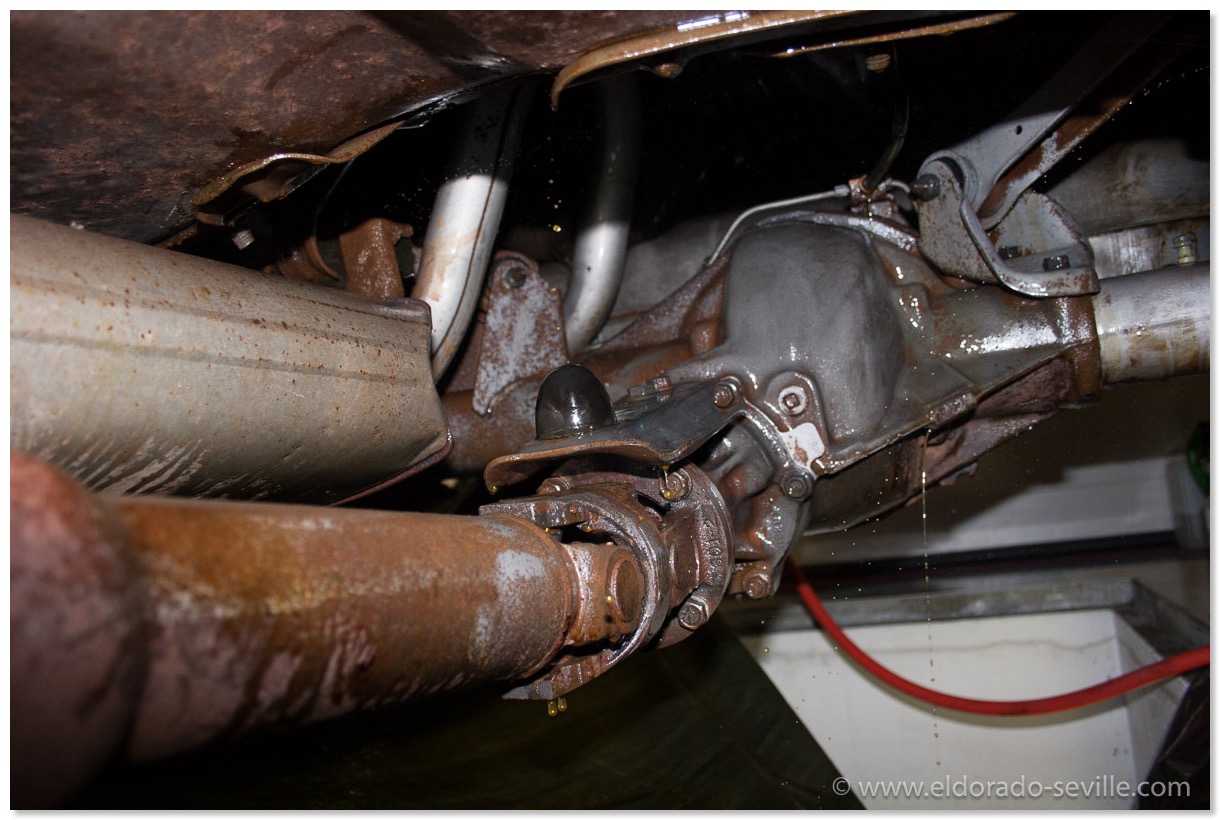
As you can see it only leaves rust free metal behind - I always let it run for 2 - 12 hours - depending on the amount of rust that had to be removed.
The liquid is collecting in the big bucket where I put the pump in to recirculate it.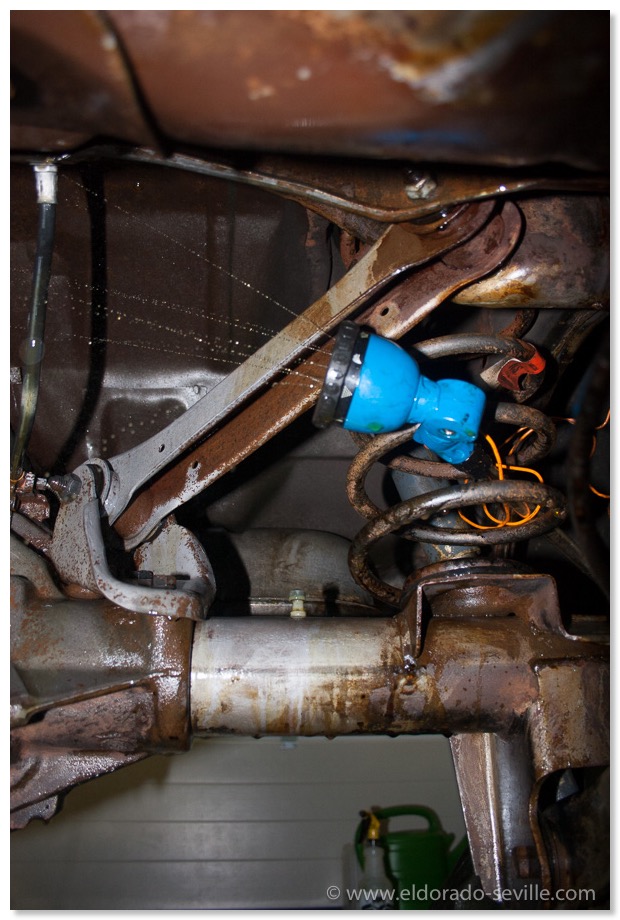
You can spray the liquid everywhere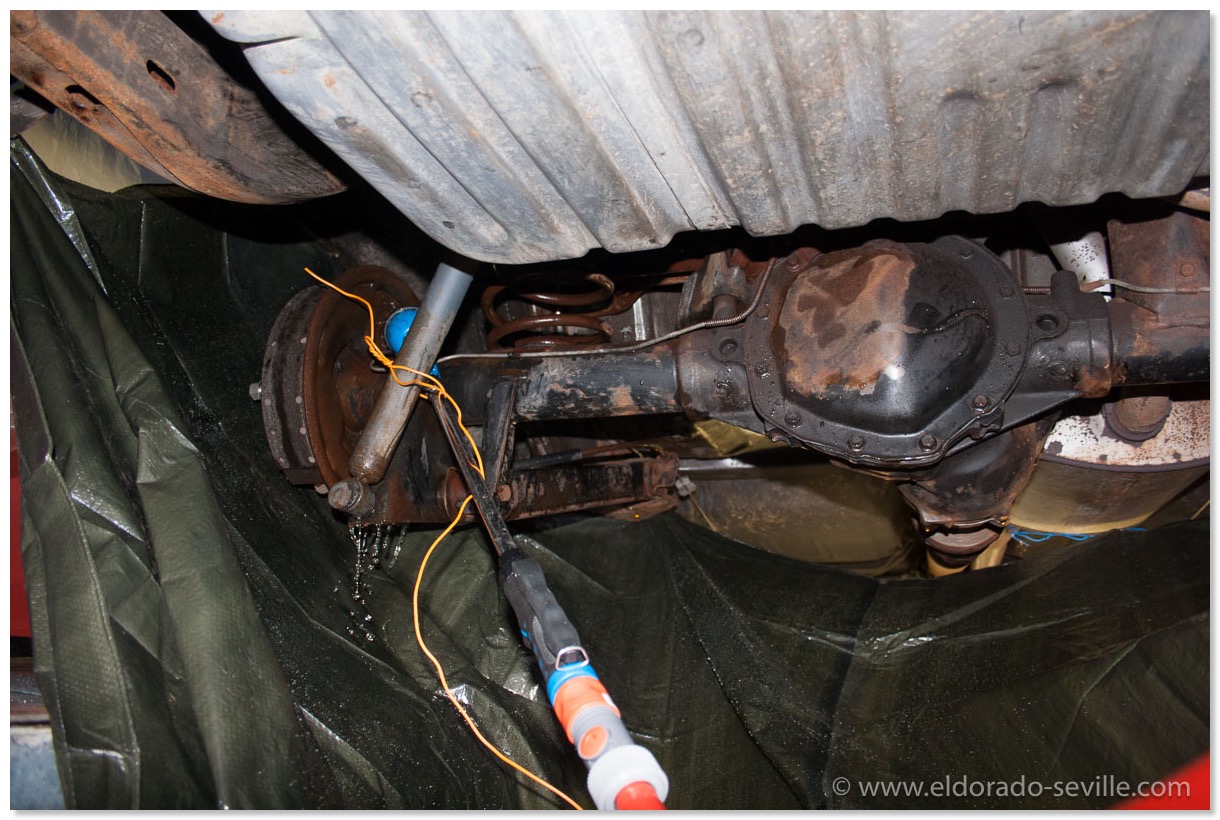
A "before" picture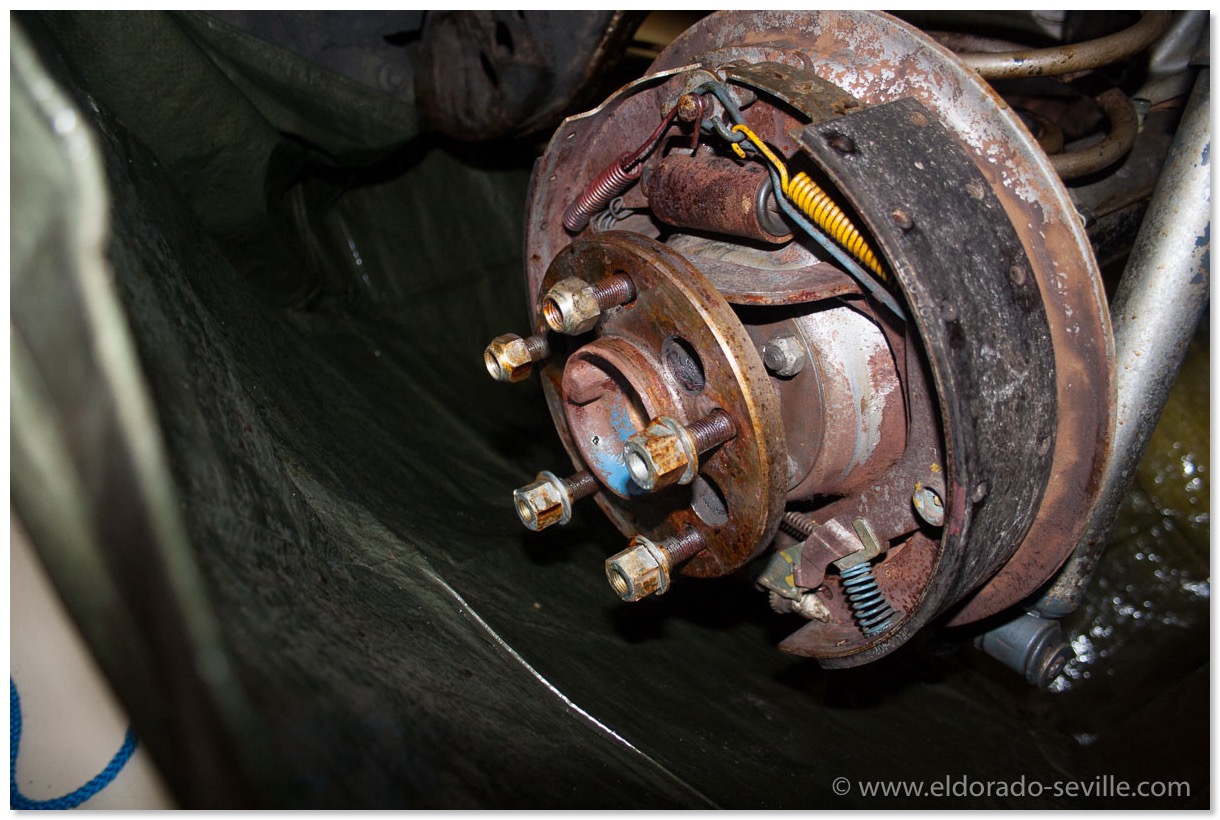
You can also remove the rust from the brakes without disassembling them. A before picture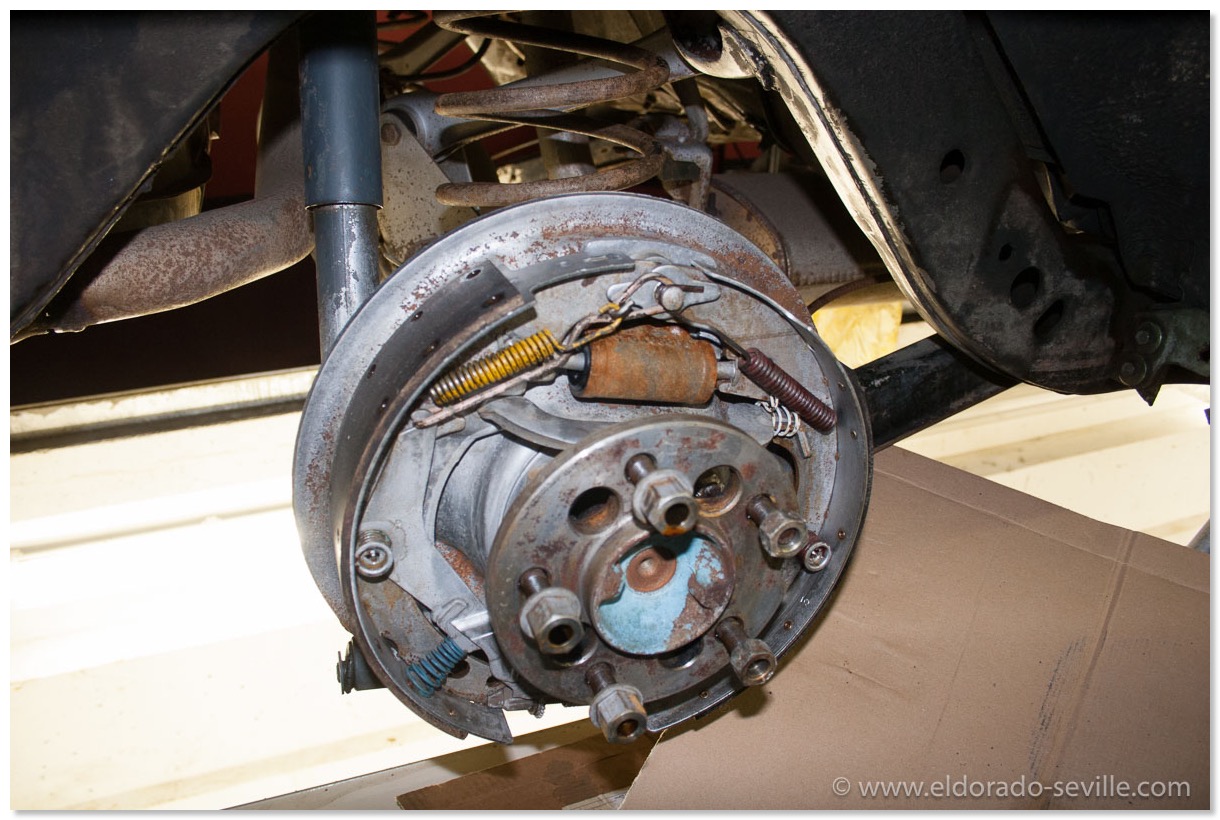
After cleaning - the brake cylinder developed flash rust immediately again.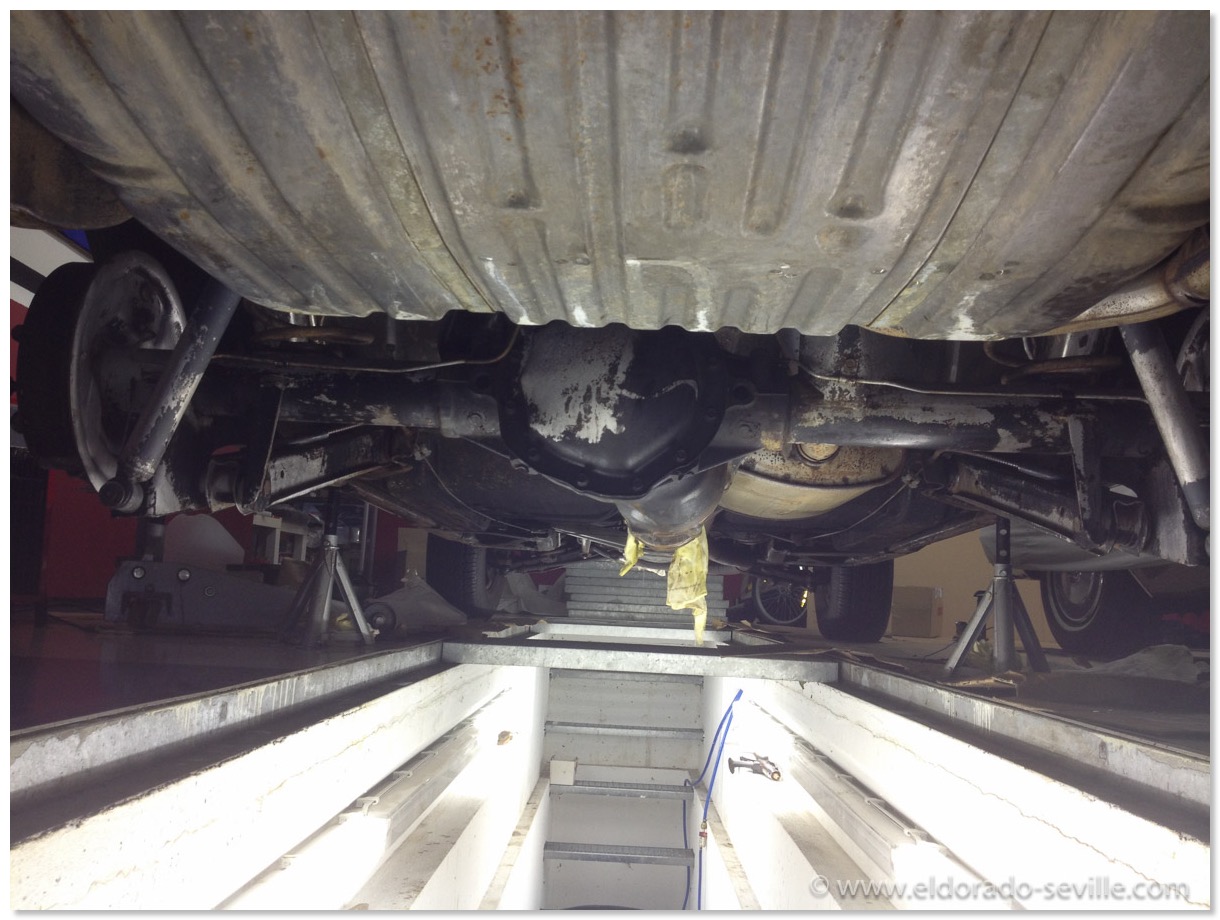
As you can see - the rust is gone
The liquid also works great on brake drums - the original factory markings were still there.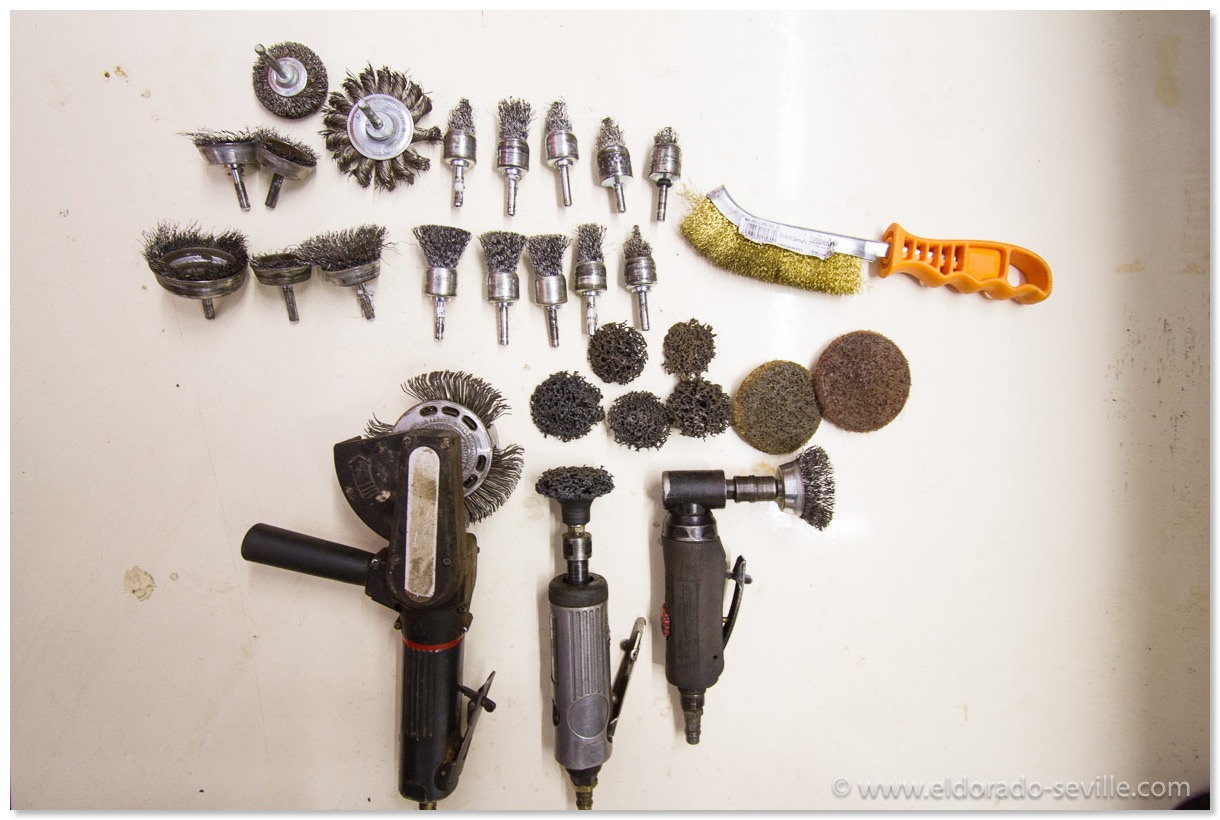
Cleaned the fuel tank with the wire brush and painted it afterwards with tank paint from Eastwood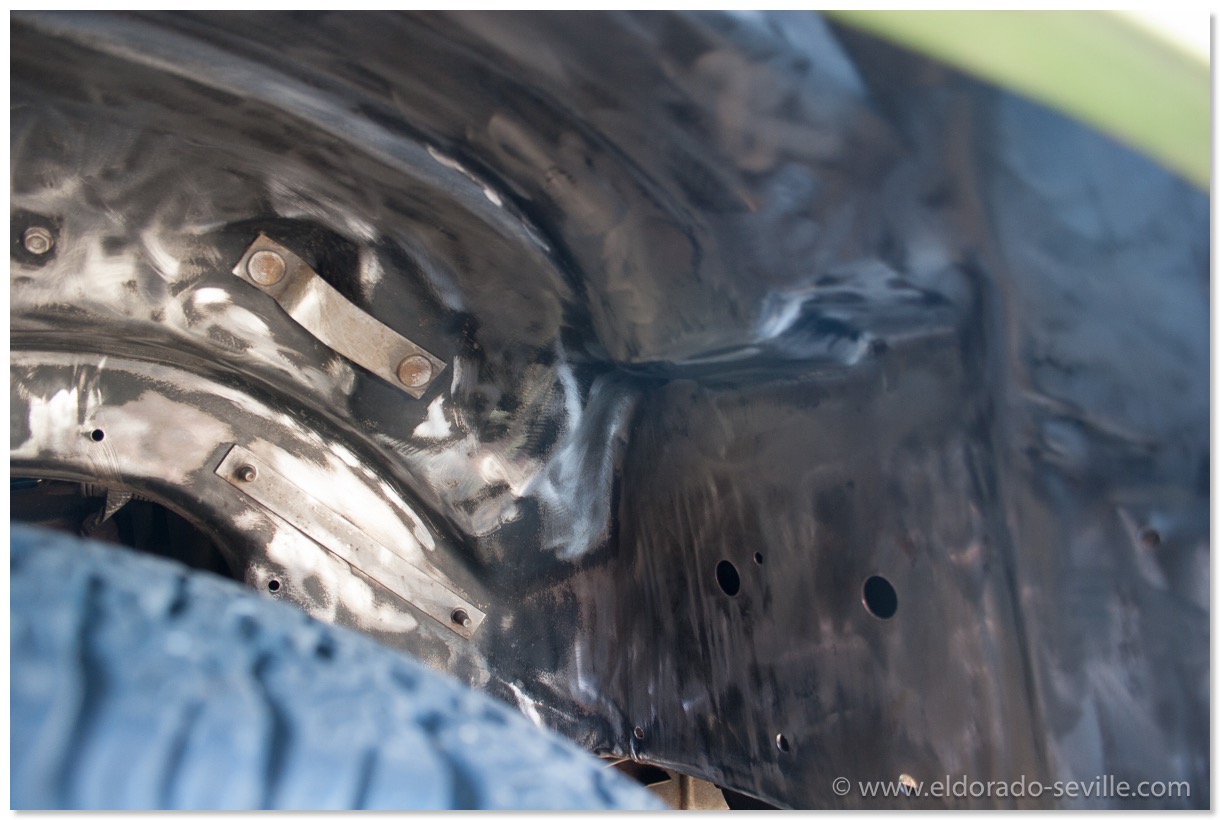
Cleaned the wheelhousings as well - stripped all the paint in there as well.
≈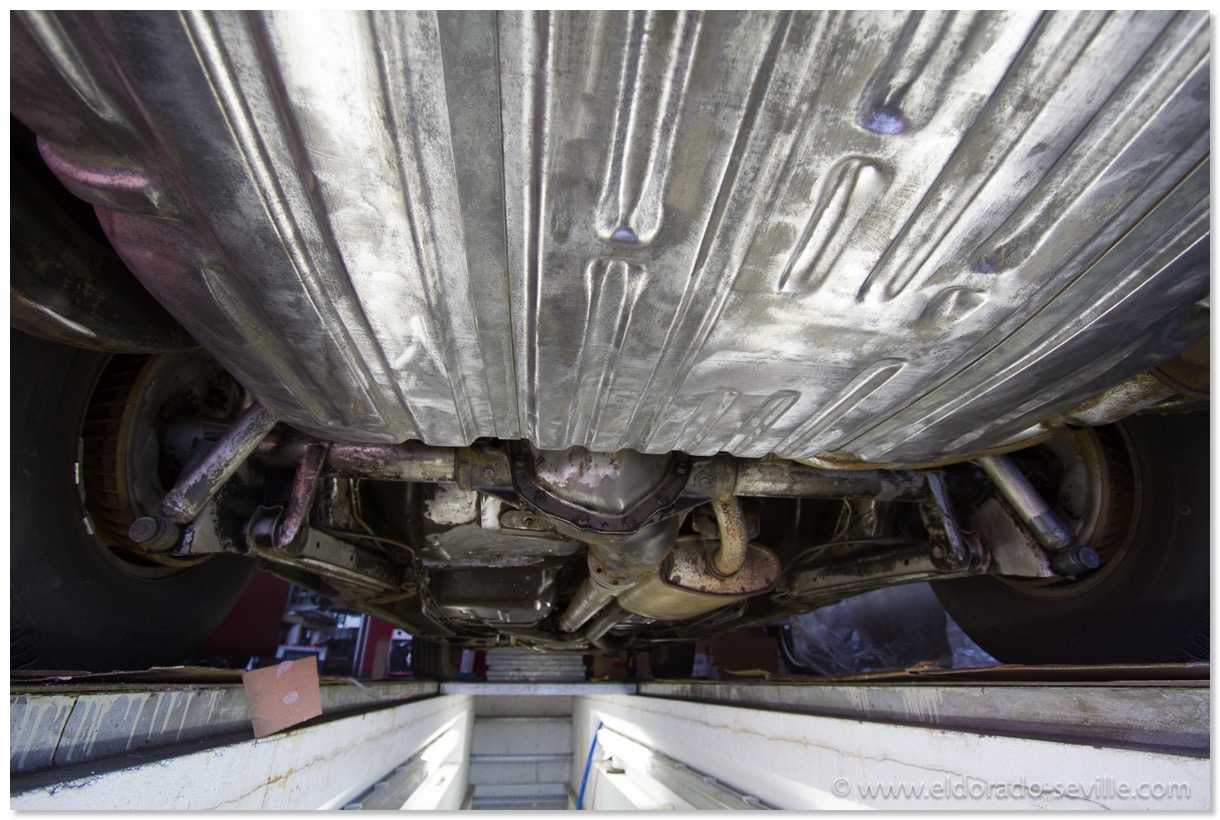
Cleaned the fuel tank with the wire brush and painted it afterwards with tank paint from Eastwood
MY WINTER PROJECT FOR 2015/16 - I WILL FRESHEN UP THE 74s UNDERCARRIAGE!
Some other smaller things could happen as well…
The plan is to make the car to look and drive like new until next season. It's such a great car!
I think there are many different approaches for removing the rust from the bottom side of a car.
My personal method and plan so far, was to scrape any loose rust off with a wire brush.
I then steam cleaned the undercarriage.
Next step was to apply a rust removing gel, which I let on over night. Then I steam cleaned the car again to get rid of the gel. The gel is a quite a bit of pain to remove if it's getting dry, especially as I had to do the steam cleaning with the car on jack stands and limited access to the undercarriage. (I can't do this inside the garage over the pit)
So a lot of manual cleaning is necessary after the pressure wash to get rid of the gel on areas I cannot hit during the pressure wash... I then applied the gel once again and did the same routine all over again.
I will now mechanically remove the more stubborn rust with some pneumatic tools and wire brushes of various sizes I borrowed from my dear friend Richard.
Once the rust is completely removed, I will use the gel for a last time.
I will then use fine sandpaper to achieve a smooth surface of all metal parts.
If afterwards there is still some minor corrosion left I´m planning to use a rust converter and rust encapsulator to paint everything.
The oil pan and transmission oil pan will be painted in Bill Hirsch Cadillac blue again. I will completely clean up the fuel and brake lines as well.
The frame and chassis parts will most probably get painted with Eastwood Extreme Chassis Paint in satin black. As a last step I will cover everything in a transparent undercoating wax. This project will keep me busy until next spring as I want to do it very thoroughly and as perfectly as possible. The most common approach most people would do, is to knock off any loose rust, and then paint it with rust converter and rust encapsulator. Thats perfectly fine as well - but I want the underside of my car better than new and in perfect show quality like the rest of the car
You can find all the pictures of the “Restoration“ here.
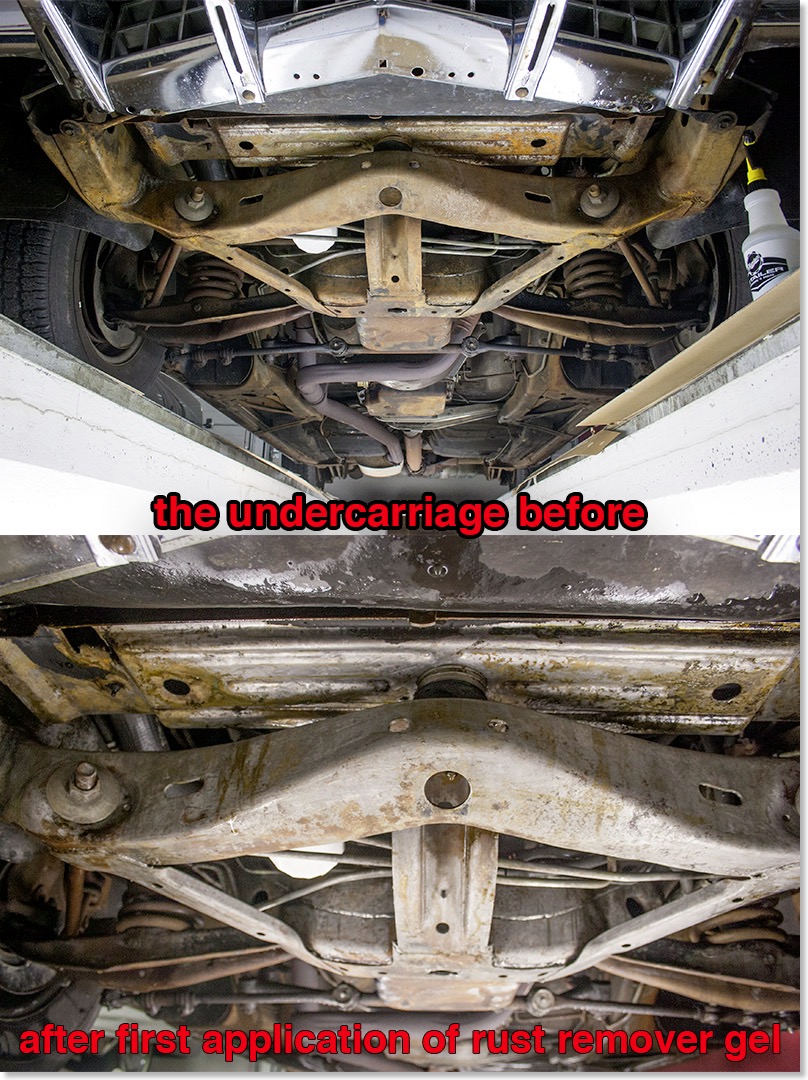
The 74 has some light surface rust on the undercarriage as most areas were left bare metal at the factory. The original owner did not have the car undercoated. Its nothing major - it is more a cosmetic thing than anything else. I want the car to look as good on the underside as it looks from the in and outside. I will remove as much rust as possible with a wire brush and then use rust removal gel to get rid of all the rust. It´s a messy job - but I want to do it as thoroughly as possible. After everything is clean I will paint the frame with rust preventive paint in semi gloss black paint.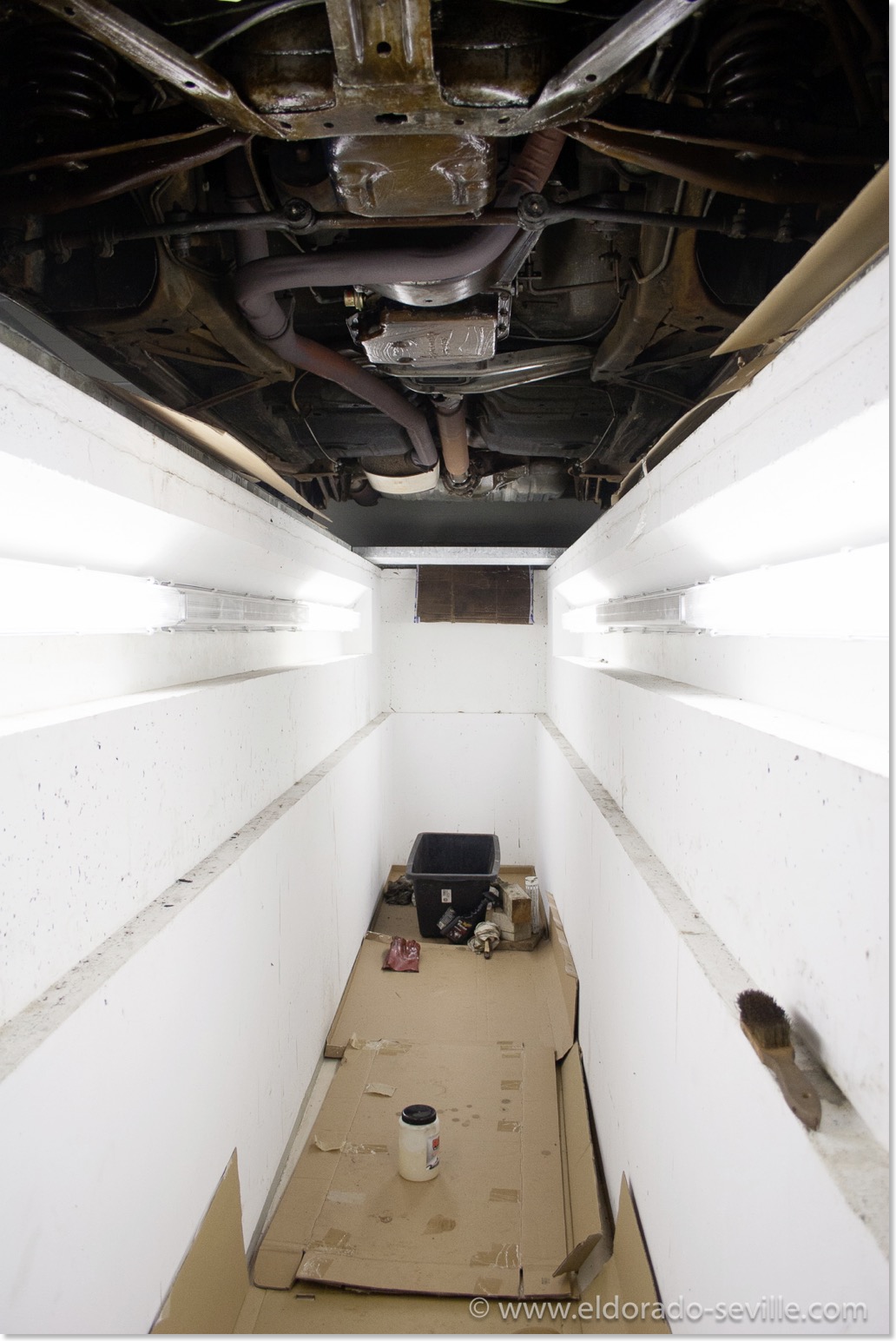
The pit in my garage - this is how I will see my car most of the time for the next months… You can see that I applied some rust removal gel to some areas already. I steam-cleaned the undercarriage before.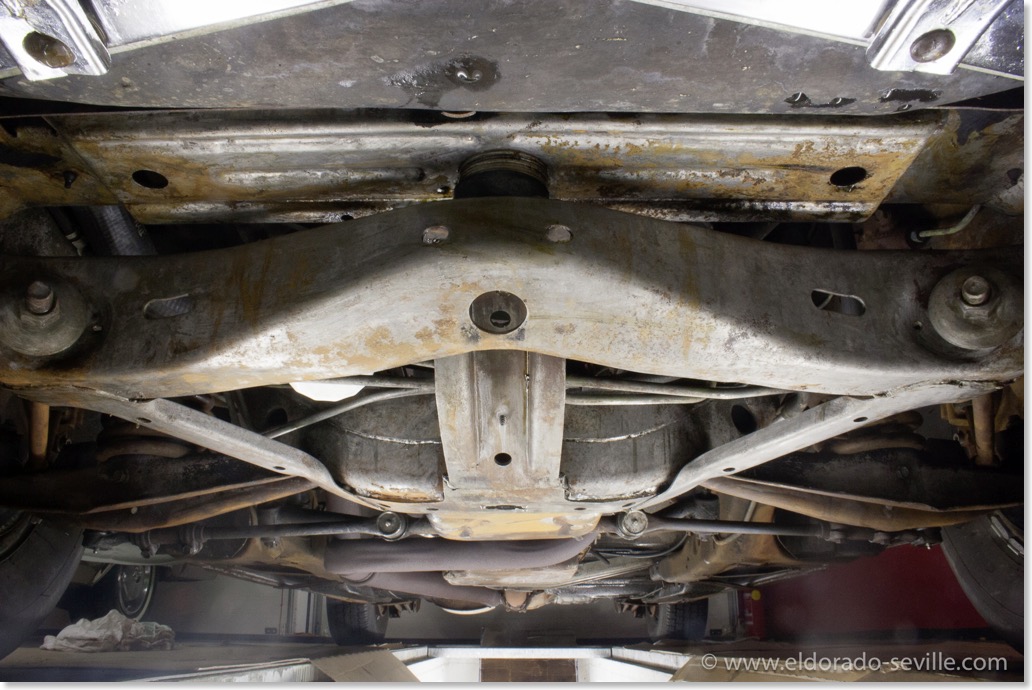
A small test spot after only one application of the gel - 2-3 more are recommended.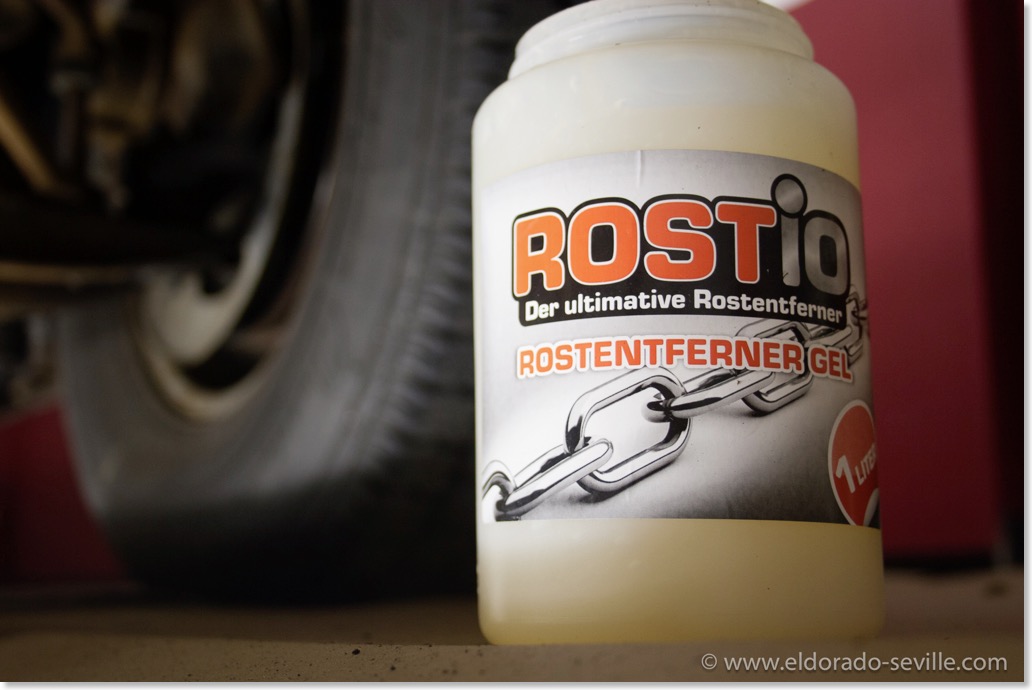
Thats the gel I´m using - it seems to be a great product. I got it through www.rostio.de . 
After the first coat of rust remover gel. It looks very promising.
PHOTOSHOOTING WITH THE FLEET
It took me quite a while to drive all the cars to the location and park them, as only 3 of them live in the big garage in the picture…
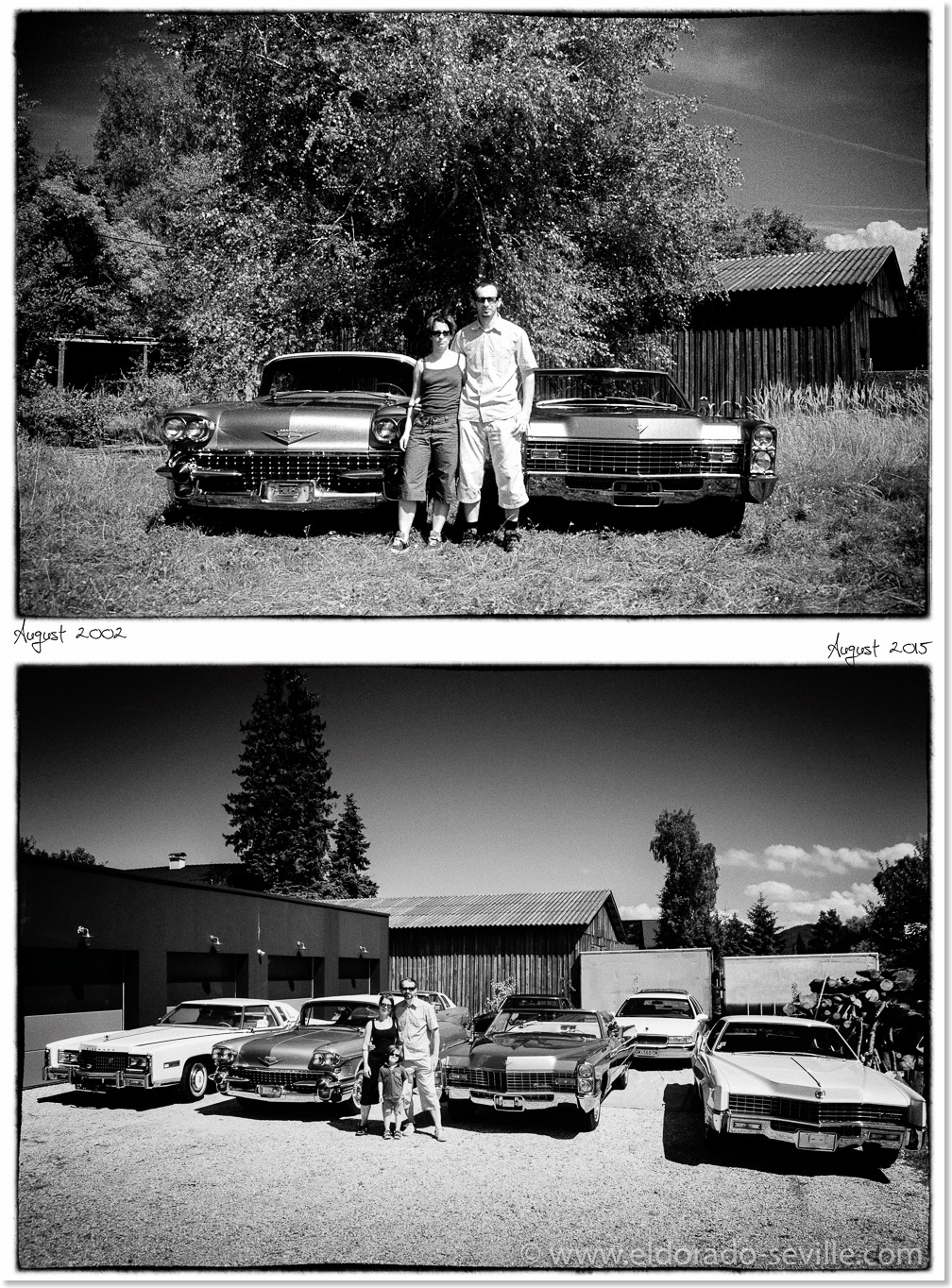
A lot of things have changed during the last 13 years.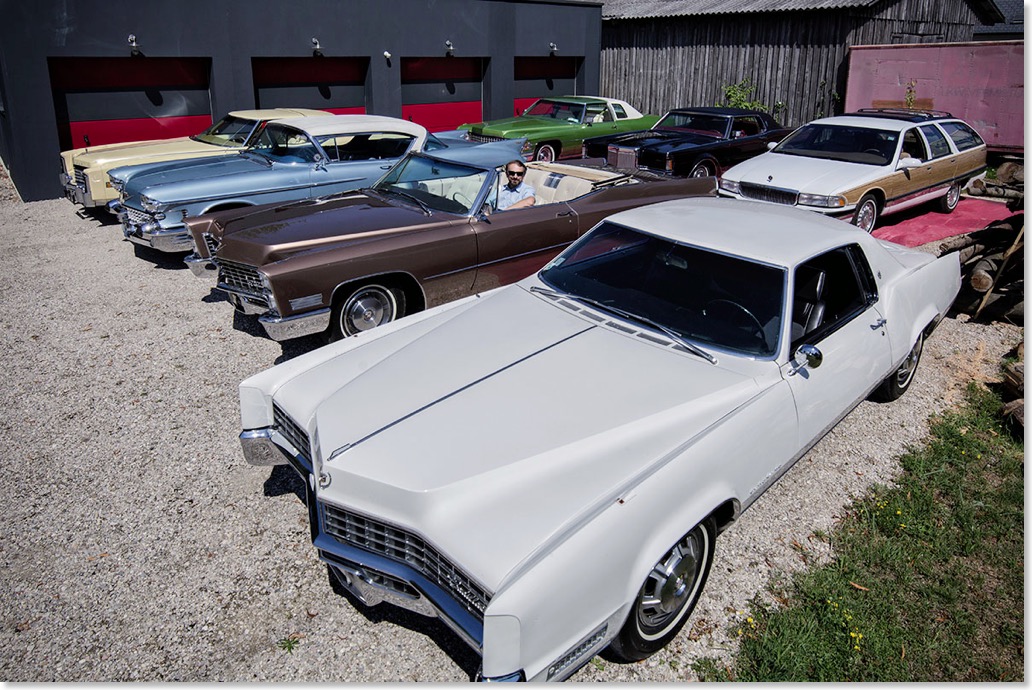
Our 1976 AMC Pacer is missing in this picture as it does not run at the moment.
REPAIRING THE 6 WAY POWER SEAT OF THE 1958 ELDORADO SEVILLE
First I suspected that the switch has a problem - so I took it apart. With a test light you can easily test its function. With a three way jumper wire you can simulate the switch as well at the switch connector. You can see the picture below from the shop manual and its described which terminals you have to connect together to get the desired movement. The shop manual is extremely helpful in diagnosing any seat related problem. Check it out below!
Everything was fine at the switch. So I checked the wires going to the solenoids. There is a plug underneath the switch and I checked the wires from there. Everything was ok there as well.
For some reason the mechanism still did not engage. The front actuator was repaired by the previous owner once, as there were some screws in there which originally were not used. I tightened them and suddenly it worked again when I almost wanted to give up and wanted to try to find a good used one from one of the Cadillac parts places.
I hope it will work now for a long time. The seat is fully adjustable again.
Below are some pictures from the shop manual which should be very helpful if you have power seat problems as well.
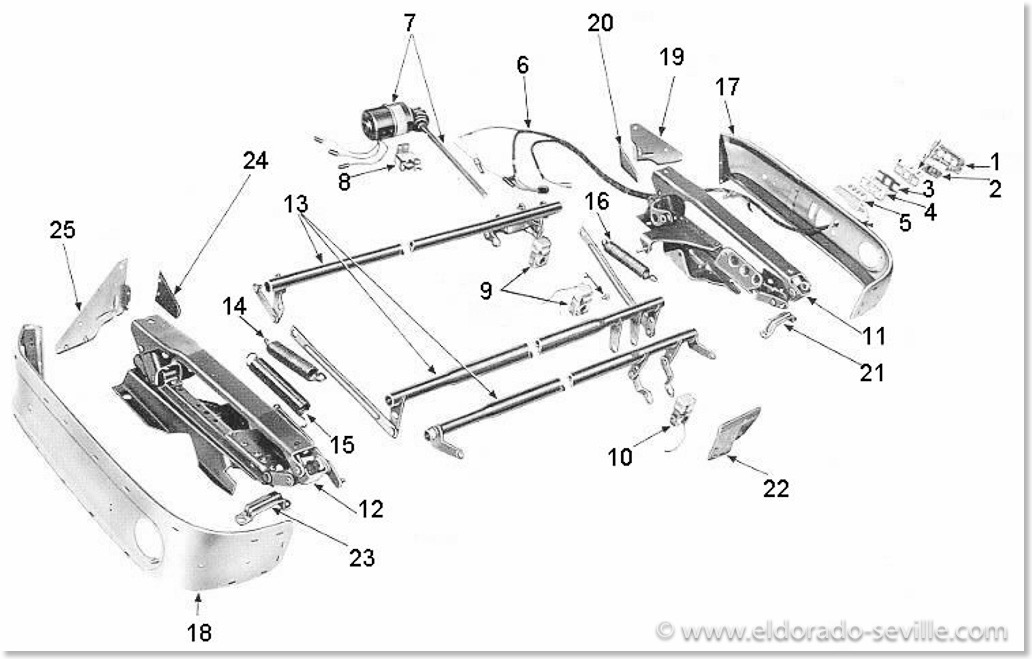
Six-way power seat diagram.
Thats the front actuator and solenoid which had a problem on my car. The mechanism did not engage for some unknown reason. Probably a bad internal contact or the mechanism was stuck somehow.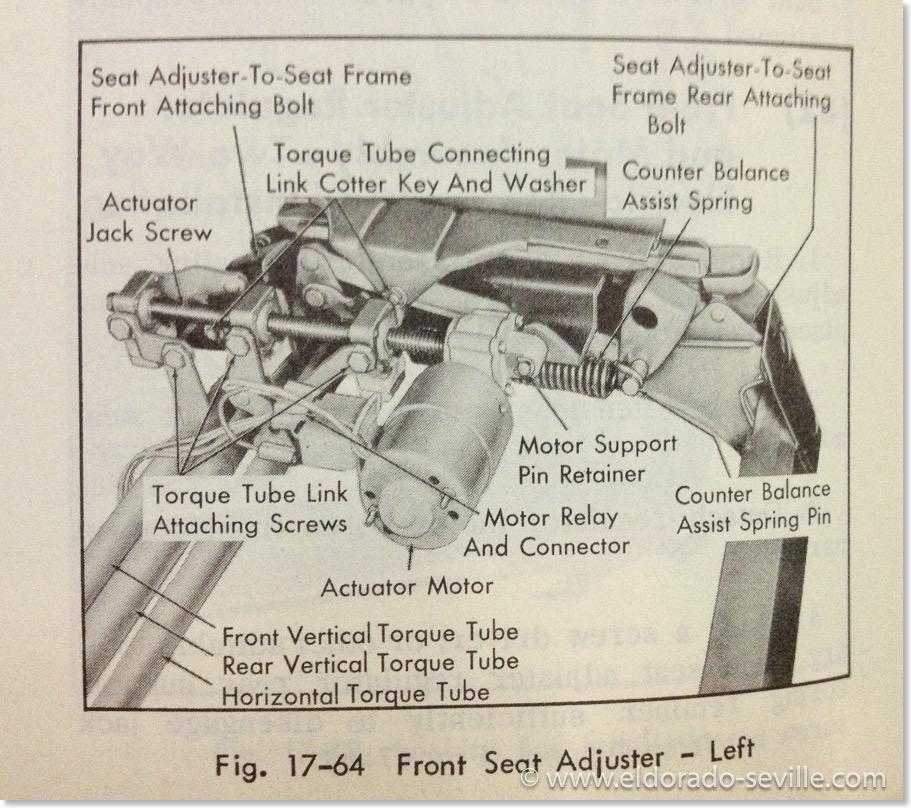
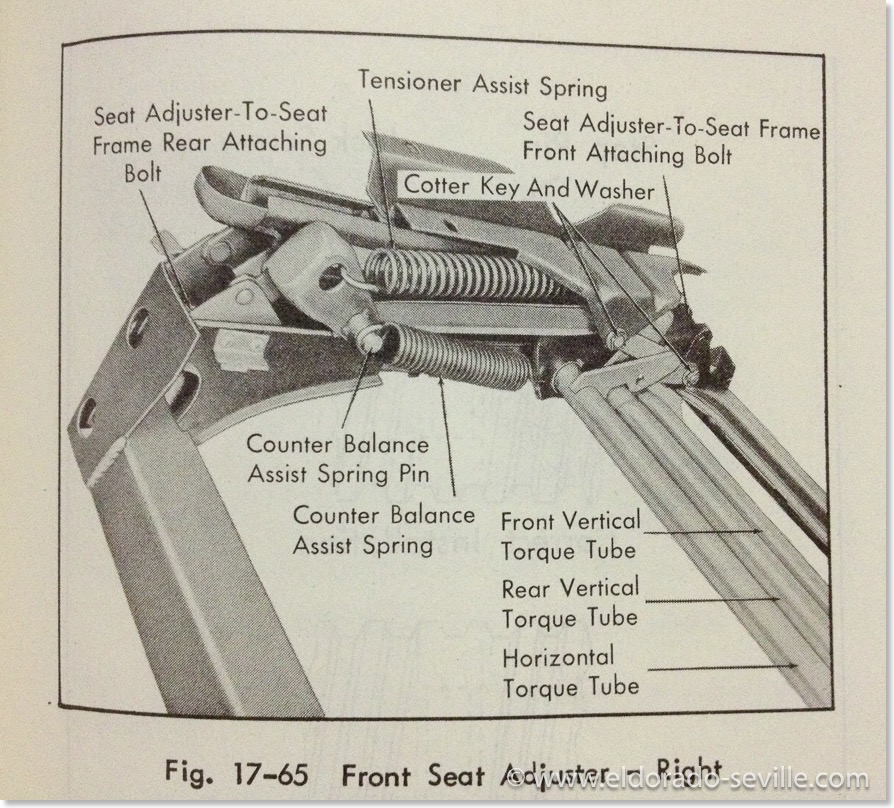
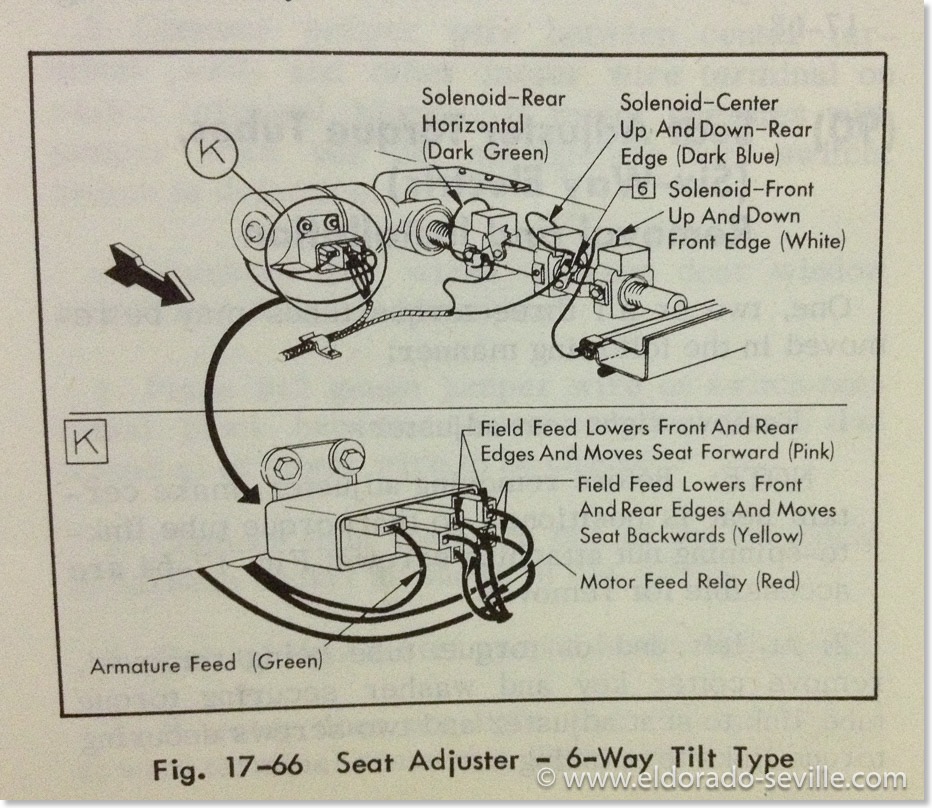
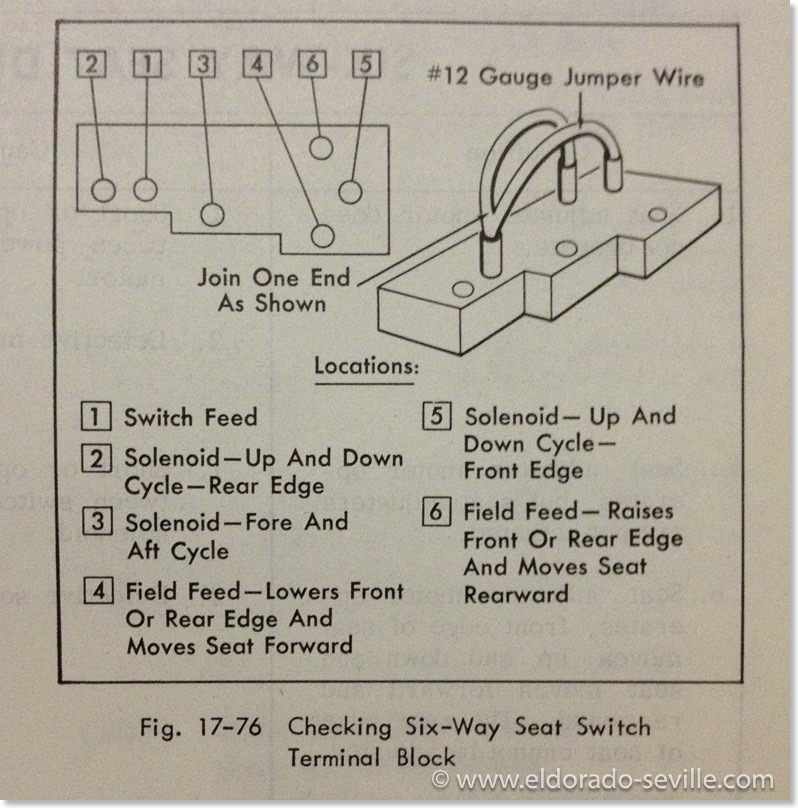
This 3 way jumper wire is very helpful to test the various functions and to rule out any problem with the switch.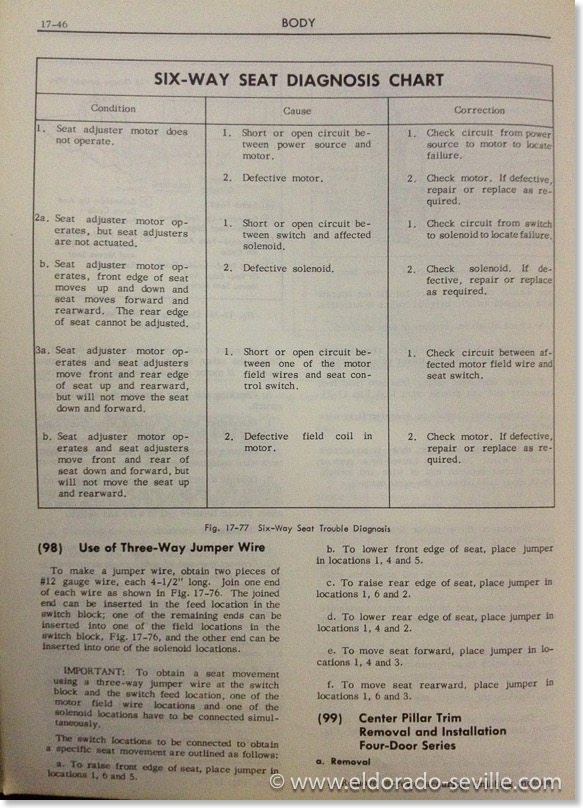
The procedure to test all the functions of the seat.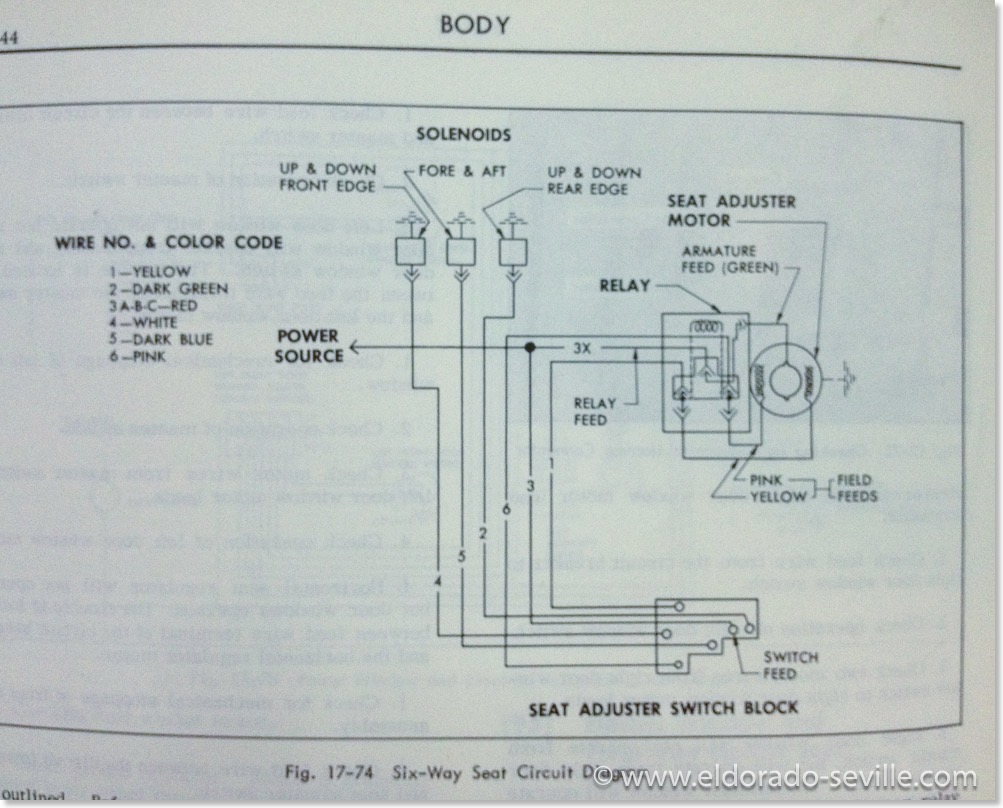
The 6 way power seat wiring diagram.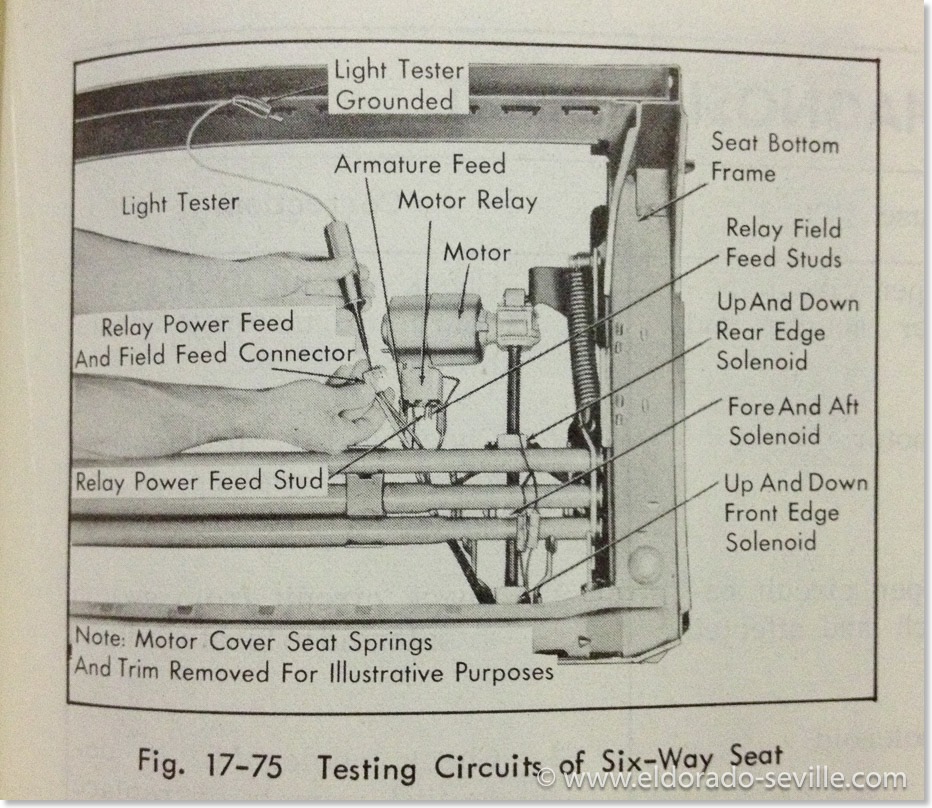
How to test the circuits.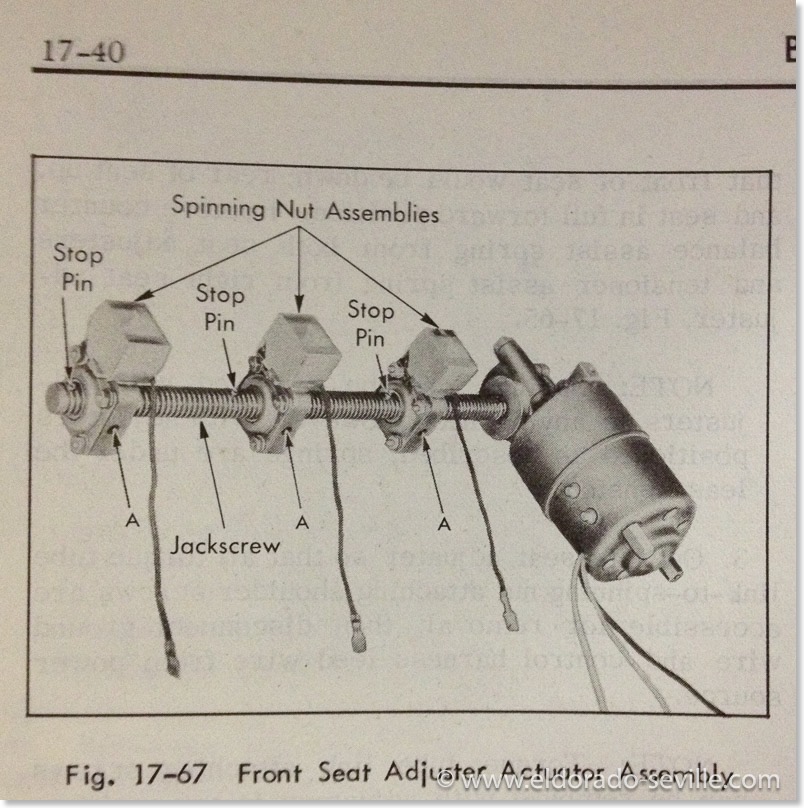
Front Seat Adjuster Actuator Assembly (1957 and 1958)
THE 1966 COUPE DEVILLE WENT TO A NEW HOME.
As I can´t keep all Cadillacs which are in my garage I had to let one Cadillac go to another care taker to free up some money. The new owner got a fantastic car and he drove it all the way to Berlin without a single problem on the hottest day of the year with a lot of traffic jams and a 13 hour drive.
This 1966 is a very special, very original and extremely well optioned car and there is no chance to find another one as good and original as this one. I know that I will regret selling it forever, but I´m glad that it found such a good home. There is a good chance that I will be able to see the car again at some Cadillac Meetings in Europe.
I really hope that I won´t be in the situation again to have to sell another car - I just love them way too much to let any of them go.
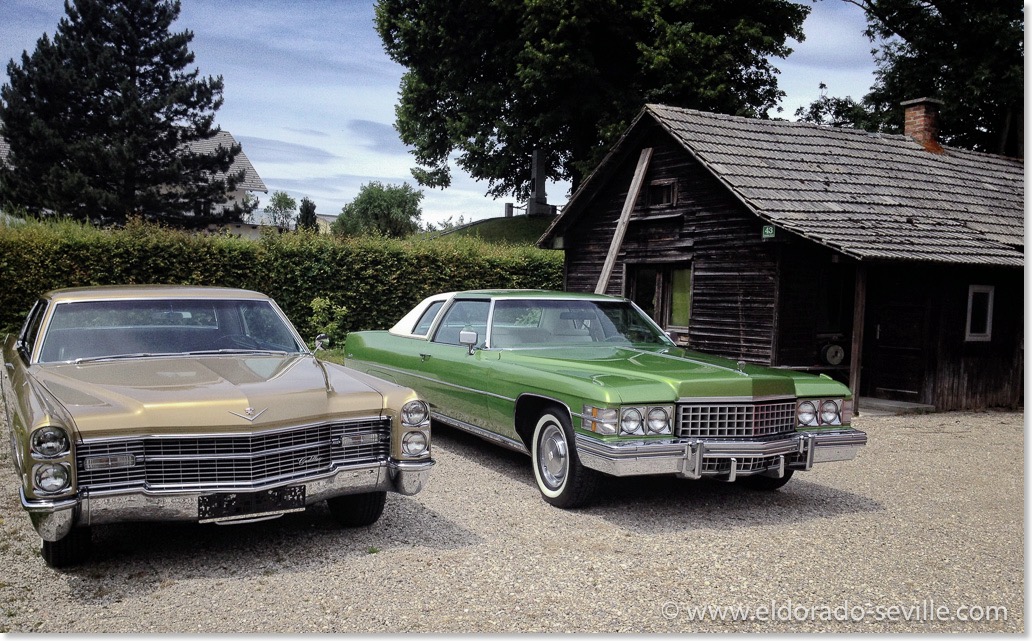
The last picture I took of the 66 together with the 74 before the new owner took over. This is an awesome 22k miles car which you have to experience, as words cant describe how special it is. Many happy miles to the new owner!
REPAIRING THE 1967 CADILLAC AC CONTROL HEAD
This time the 67 Eldorado had a new problem which I had to fix.
It suddenly only blew hot air out of the AC outlets. It did not change modes at all. That was a sign of a weak vacuum signal…
I started to inspect all the AC related vacuum lines of the car which checked out fine. Next I did the test I´m describing here in an older posting, as I suspected that the power servo had a problem.
I soon found out that still not enough vacuum was supplied through the transducer.
That meant that either the transducer could be faulty, the temperature sensor could be defective, or the dash control head would not work properly. I took out the temperature sensor of my 67 Deville to test it in the Eldorado but it did not change anything.
I then removed the control head and tested it with a spare one I once bought cheaply on ebay. It did miss some connectors and switches, it had some blemishes on the chrome and did not look good enough to install it into any of my cars. When I put it into the Eldorado anyway the AC suddenly worked perfectly again.
So I removed all the electrical parts from this working unit and transferred it to the perfectly looking but defective control head. After I had swapped all the usable parts I put the unit back into the car and I now have a perfectly working unit once again.
It looks like that there was a problem in the amplifier part which translates the signal coming from the rheostat into a current going to the transducer which regulates the vacuum going to the control head and the power servo.
Lets see what issue comes up next spring…
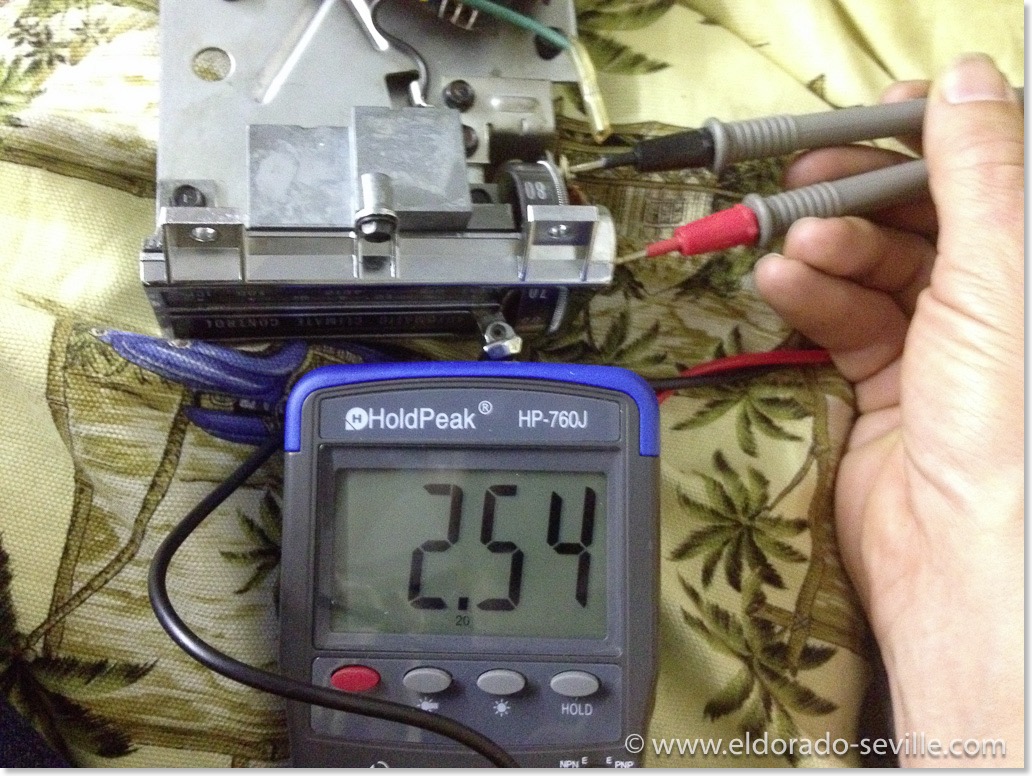
The Rheostat when set to the lowest temperature setting shows around 2,5 Ω You can check if it is working with an Ohmmeter.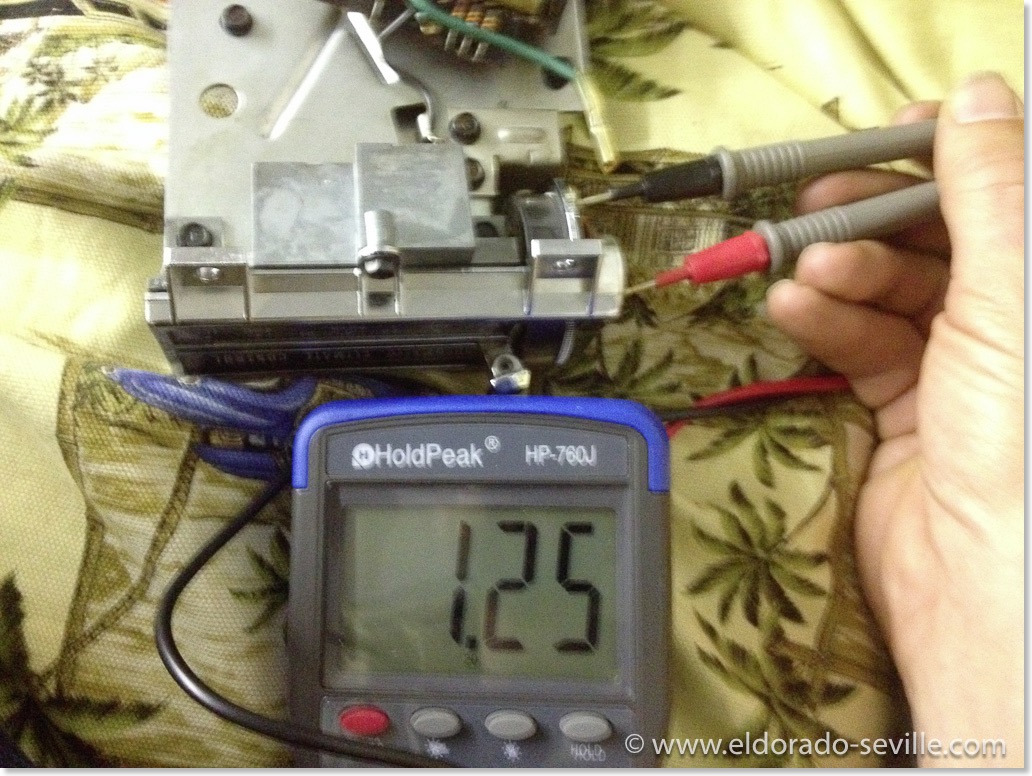
At the highest temperature setting the resistance is getting lower.
The Amplifier part of the control head is on the underside. Something in here must have gone bad on my control head. I will try to find out what went bad and repair it to have a spare part.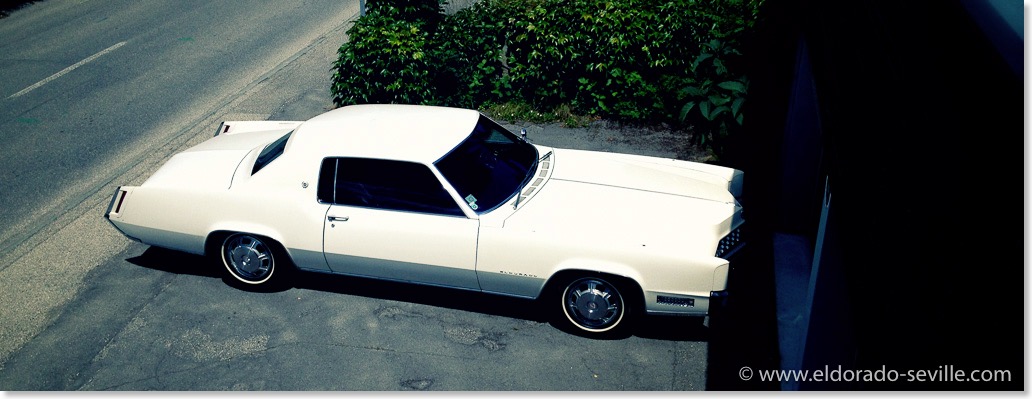
The 67 Eldorado is back on the road for the 2015 season.
MY GREAT CADILLAC BIRTHDAY CAKE
DECORATING THE BIG GARAGE
1967 CADILLAC BORG CLOCKS REPAIR AND A PROBLEM WITH A PRINTED CIRCUIT BOARD.
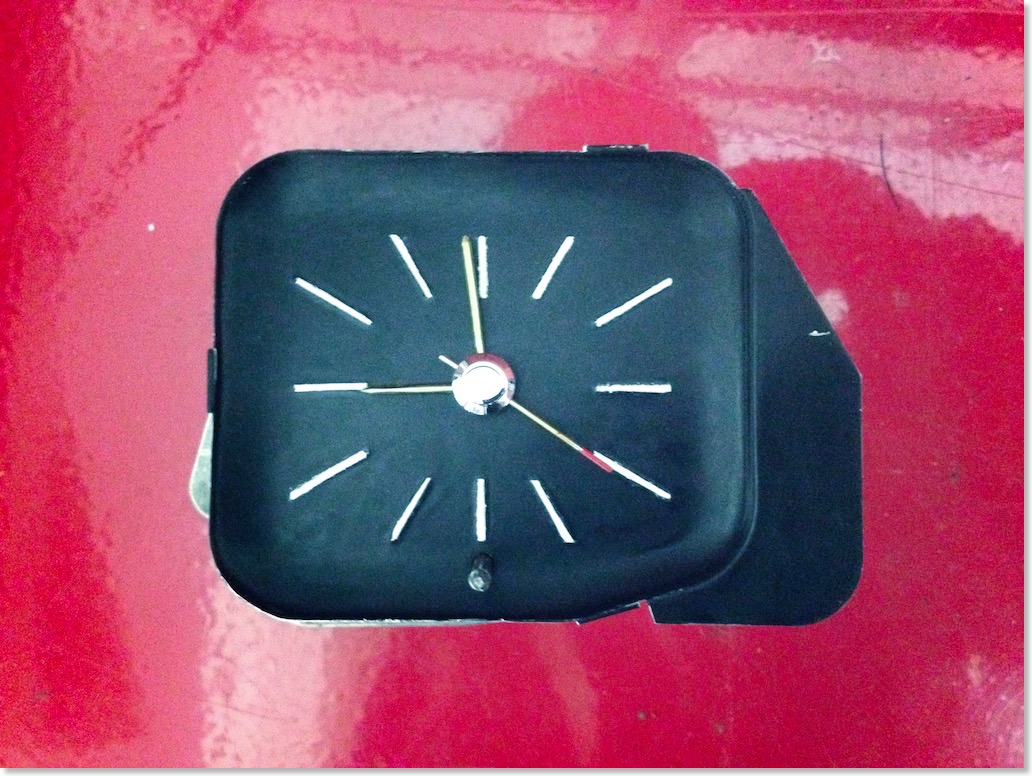
The 1967/1968 Cadillac Westclox clock out of my 67 Eldorado.
The last time I tried to repair the clock in my 67 Cadillac DeVille I totally failed. This was in 1998…
After I got the clocks in all the other Cadillacs moving again - I could no longer stand watching the dead clocks in my 67 Eldorado and DeVille.
So I decided to try to repair them as well.
The last repair attempt at my 67 Eldorado was very disappointing.
In 1998 I took the clock out of my 67 DeVille the last time, and after my repair attempt the hands started spinning in an extremely fast pace - like a ventilator. So I had to disconnect the power to the clock at the printed circuit at the back of the instrument cluster. When I did that I forgot to disconnect the battery and when the power feed touched some metal I had a short somewhere and some smoke came out of the dash… I could not locate where the smoke was coming from - all wires looked perfect. So I just insulated the clock coil power feed and gave up on the repair and forgot about what had happened.
As I found out now - some connection of the printed circuit board got burned back then…
After the failed repair of the 67 Eldorados clock last fall, I decided to try to find a good used clock. Once again Arizona Vintage Parts - my favorite source for parts - came to the rescue. He sold me two non working Borg clocks for a really good price. Unfortunately by now he has run out of stock for them.
So I tried to repair the clocks he sent me - appearance wise they were in very good condition, and I got one back to life for a short time by just cleaning it.
So I put it back into the car and then I made a stupid mistake and ruined it completely. I wanted to tighten the mounting screws and accidentally grabbed the connector for the coil - as you have to work inside the dash without being able to see what you are doing - and so I overtightened it… This stripped the threads of the coil… I had to cut the nut off then and somehow the oscillator wheel inside the mechanism did no longer work properly and when I tried to adjust the stepper it broke off :-(
BTW - Do not use WD40 for cleaning and lubricating a clock like I did… This will ruin the clock as I found out when it was already too late… There are special clock oils available to lubricate clocks.
The other clock I got had a defective oscillator wheel and I could not repair it as well…
So I contacted Arizona Vintage Parts once again for some new clocks but he had sold all his stock on clocks to Sweden…
I had to contact all the Cadillac Parts dealers I found in Hemmings Motor News for two Borg clocks, but I was unsuccessful or they were exorbitantly expensive. Some of the well known Cadillac Parts dealers either did not have them, did not react to my inquiries or asked up to $ 385.- for a used, rebuilt clock. Others asked up to $180.- for a non working clock.
Luckily I found a company called “The Clockworks" which was highly recommended on some Cadillac and other classic car forums for their good work in repairing clocks and also converting them to a quartz movement.
Everybody seems to recommend to convert your clock to a much more reliable and cheaper quartz movement. I thought about it for a while but I decided that I wanted to go for an original movement for authenticity reasons. If you convert to quartz the "tic-toc" movement will be gone and you can tell by just looking at the clock…
I ordered two rebuilt Borg clock movements for my clocks from "The Clockworks". Their service was excellent and they were a great help. Great customer service! I would buy from them again or have my clocks rebuilt by them anytime.
After I received the movements I installed them and put everything back together. You have the keep the adjustment stem and the housing from your old clocks if you replace the movement.
When I put the clock back into the 67 DeVille it did not work though. I soon found out that no power was coming to the coil through the printed circuit board.
I then remembered about my failed repair attempt 17 years ago and the smoke that came out of the dash… Somewhere the circuit board was burned. So I connected the orange cable going into the multiple terminal connector at #7 terminal to the clock directly and it worked again.
So I installed a cable directly to the clock. This is a temporary fix until I´ll have a new circuit board. Installing a new board requires to take the dash completely apart to replace it.
A printed circuit board is available new here: https://www.opgi.com/cadillac/CE11091/
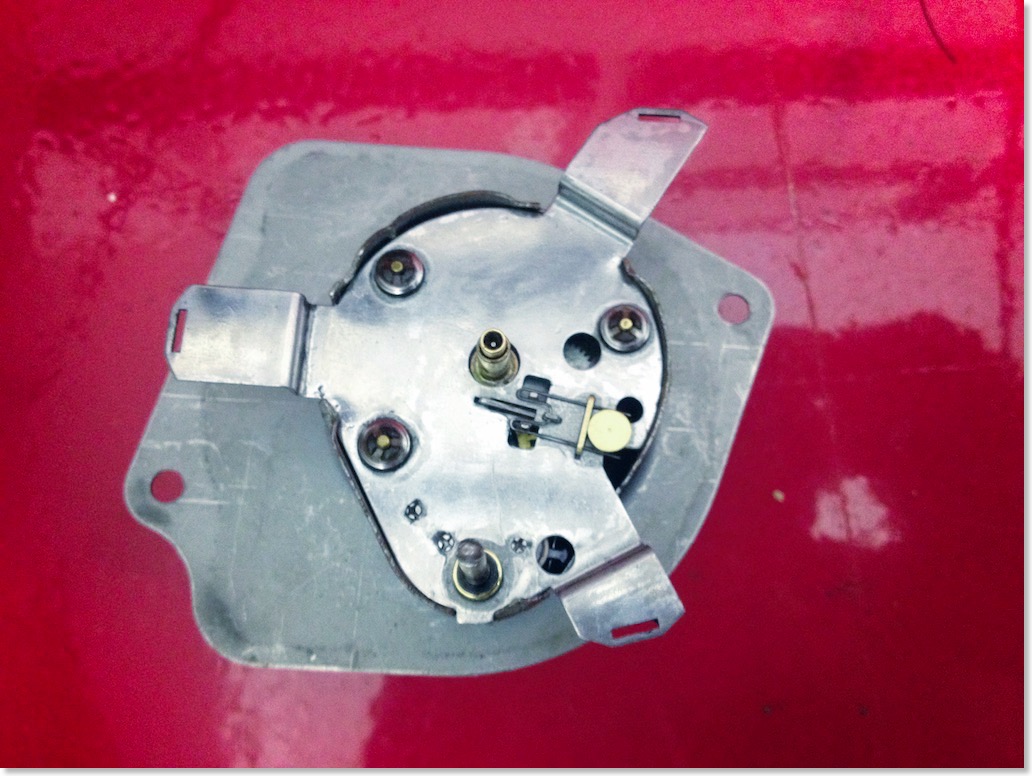
The 1967 Cadillac Westclox clock out of my 67 Eldorado. Seen from the top with the clock face removed. The clock face on the Westclox is mounted differently than on the Borg.
The 1967 Cadillac Borg clock. The housing cover in place - as you can see it looks completely different than the one on the Westclox.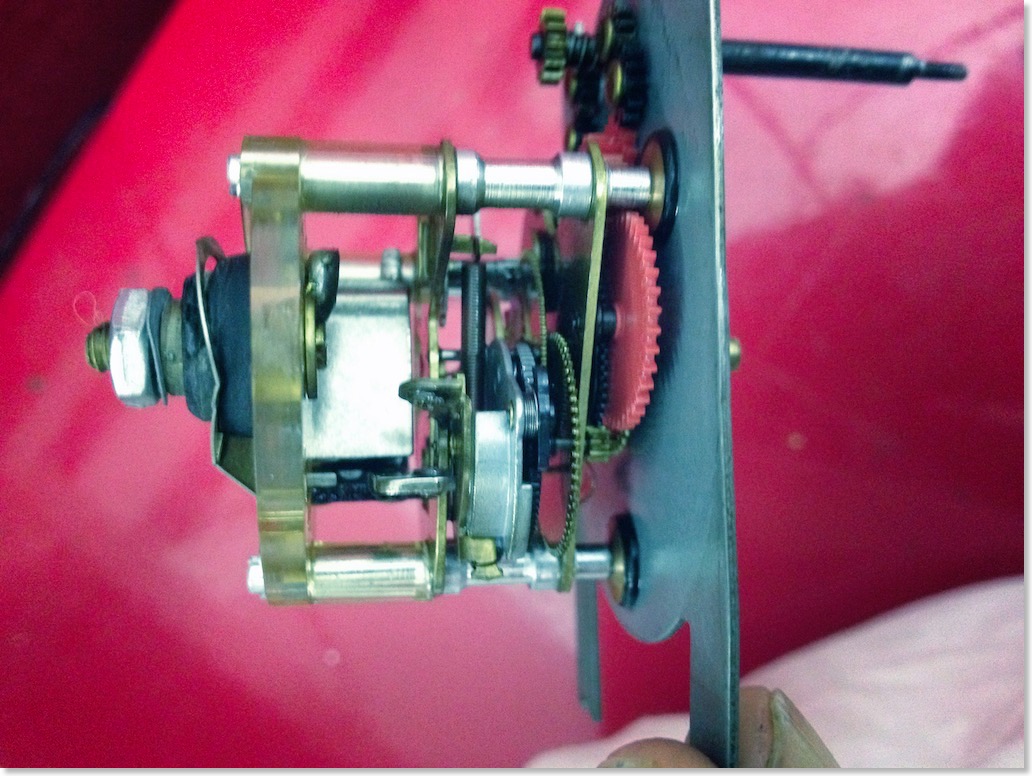
The 1967 Cadillac Borg clock out of my 67 DeVille.
The Borg replacement clock I got from Arizona Vintage Parts. 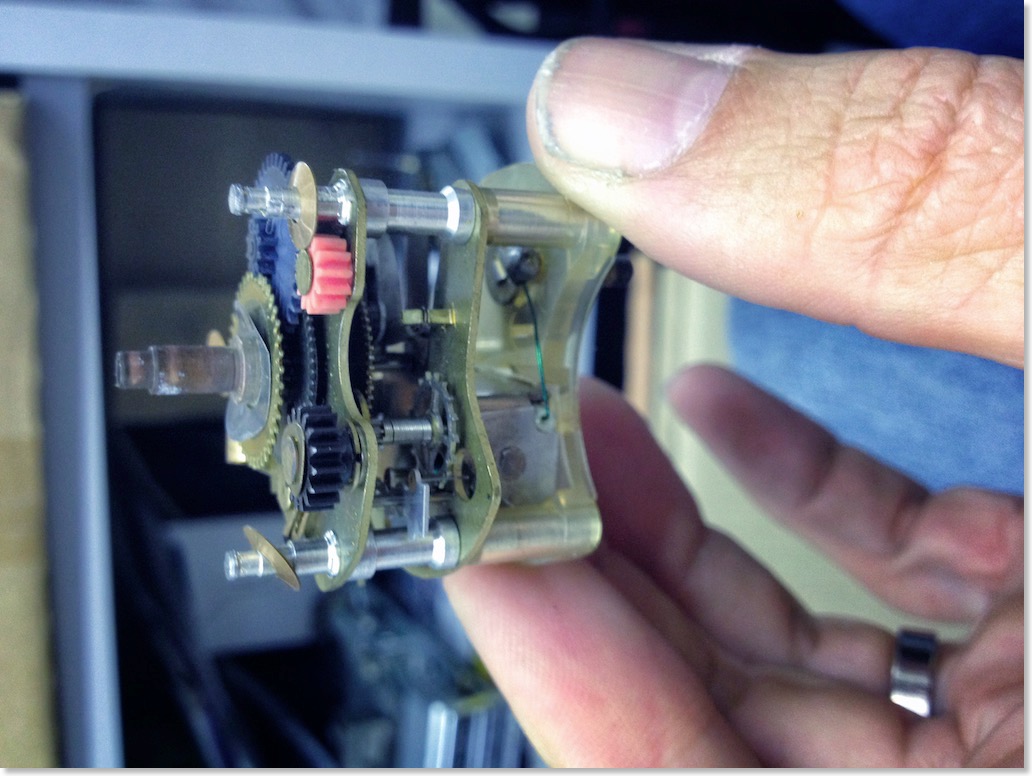
The Borg replacement clock I got from Arizona Vintage Parts - this is the original movement removed from the housing.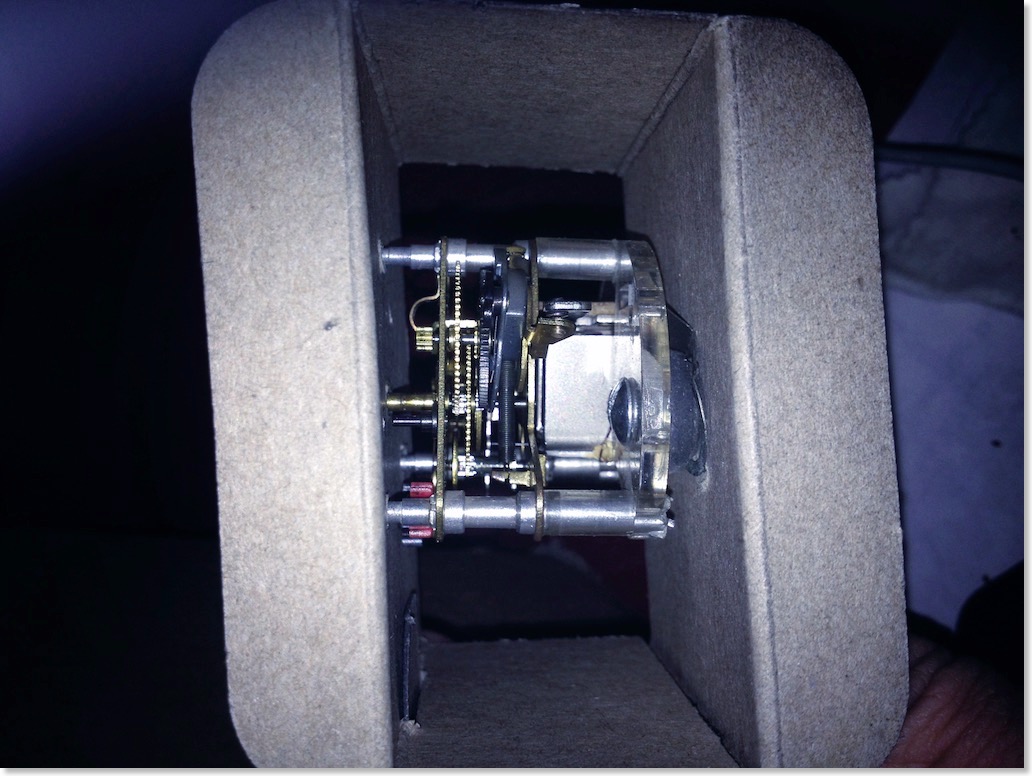
The rebuilt Borg movement I got from "The Clockworks"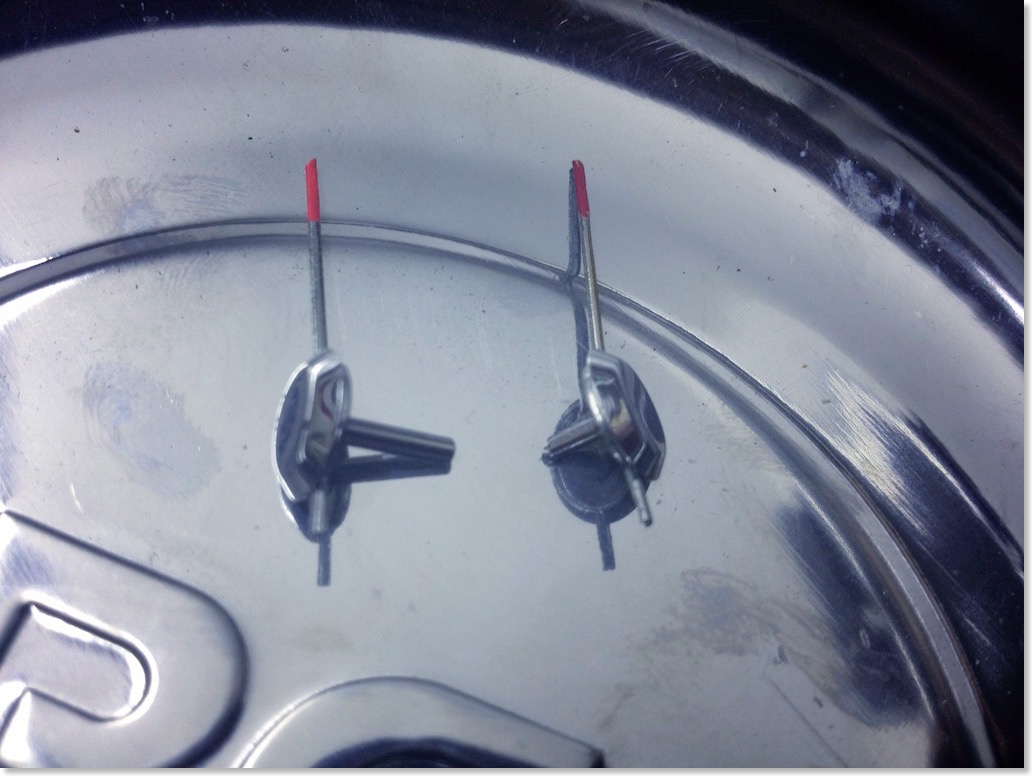
There is a difference in the second arms: On the left the one from a Borg Clock - on the right one from a Westclox. They are not interchangeable. Also the housing of the clocks is different. You cant interchange parts between these two clock types.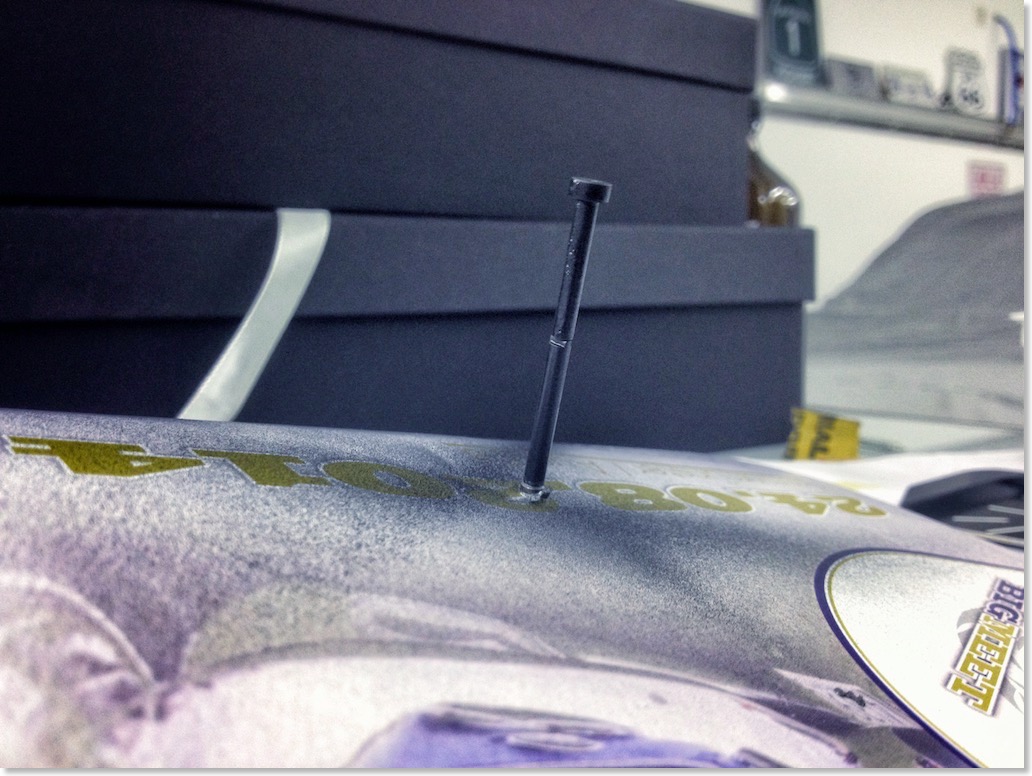
I repainted the setting stem in semi gloss black.
The 1967 Cadillac printed circuit. The one for the Eldorado is slightly different though.
FIXING THE LOW WASHER FLUID INDICATOR ON THE 1974 CADILLAC
On the 74 Coupe deVille the “Washer Fluid" light came on when I turned on the wipers.
When I checked the fluid level, the bottle was full.
I then discovered that the float unit seemed to be missing some parts like the magnet, which activates a reed switch, and the float itself.
Luckily I found all the parts sunken at the bottom of the washer fluid bottle.

The unit from the 1974 Coupe deVille
When the fluid level in the washer fluid bottle drops below 1/3 full, an amber tell tale light comes on labeled "WASHER FLUID".
Engaging the wipers allows a small amount of current to flow from the wiper motor terminal through a yellow wire to the washer bottle float unit. When the fluid level in the washer bottle is low, the float drops, allowing the circular magnet to separate from the cap assembly. This permits the contact points within the cap to close, bypassing the resistor that is in parallel with the contact points, and causing current to flow to the indicator light.
I had two problems:
- The float itself did no longer float in the washer fluid
- The reed switch in the cap did not deactivate - it was stuck and the contact points in the switch did not open with the magnet.
I got some valuable tips on the CLC forum about what kind of switch is used inside the cap, and how to make the float floating again.
TJ wrote about the switch:
"I don't remember what year it was that I fixed but I don't remember it being that difficult. There was some rivets or something that had to be drilled out or broken off. I think I used screws and nuts to put it back together. The working bit is what is called a reed switch. They are by today's standards old technology but since there is a fair amount of room in there you don't need to find the exact same one. If you do a search for reed switch you should find em. It's usually a greenish glass capsule with 2 leads coming off the ends. "
After I applied an additional, much stronger magnet to the switch, it suddenly came back to life! For whatever reason it is working again. It looks like the stronger magnet opened the stuck contact.
I still had the problem with the sinking float though and got another great tip from Jim:
“After inspecting the assembly and pulling up on the float, the warning light no longer displayed, so I knew the float was bad. I took the float off and dropped it into the reservoir. It sank like lead, so I knew it was a porous material. I knew I had to remove the moisture somehow, so I thought the safest solution was to slowly heat it up so the fluid would evaporate. I figured it was designed to tolerate extremely cold and extremely hot outside temperatures, so figured the lowest oven setting should work. I got lucky in that there was no distortion. I wouldn't recommend leaving it in longer than a few minutes, though. "
I tried the oven drying method mentioned in Jims posting above at the lowest setting. I left it in the oven like Jim recommended, and afterwards the float did not sink any longer, but it still could not hold the magnet up to the switch.
Then I put it into the oven again for an hour. Afterwards it got slightly better, but it was still to weak.
Once again I put it into the oven at a higher temperature (230 degrees Fahrenheit, or 110 degrees Celsius). Luckily the float does not warp or melt at this temperature. I switched the oven off after another hour, and I left it in there to cool down over night.
It indeed is a porous material. It seems like the higher temperature in the oven "fixed" the float for me. It also feels completely different after the cure - when I touch it now it feels much more porous than before, when it felt like a piece of plastic.
It's floating perfectly again - I hope it will stay like this for a long time. If the problem reoccurs it´ll go back into the oven…
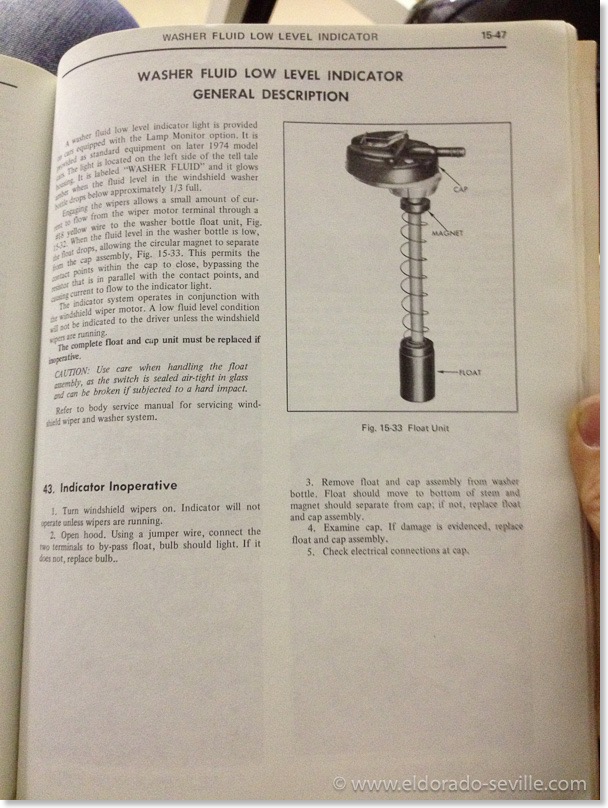
From the 1974 Factory Shop Manual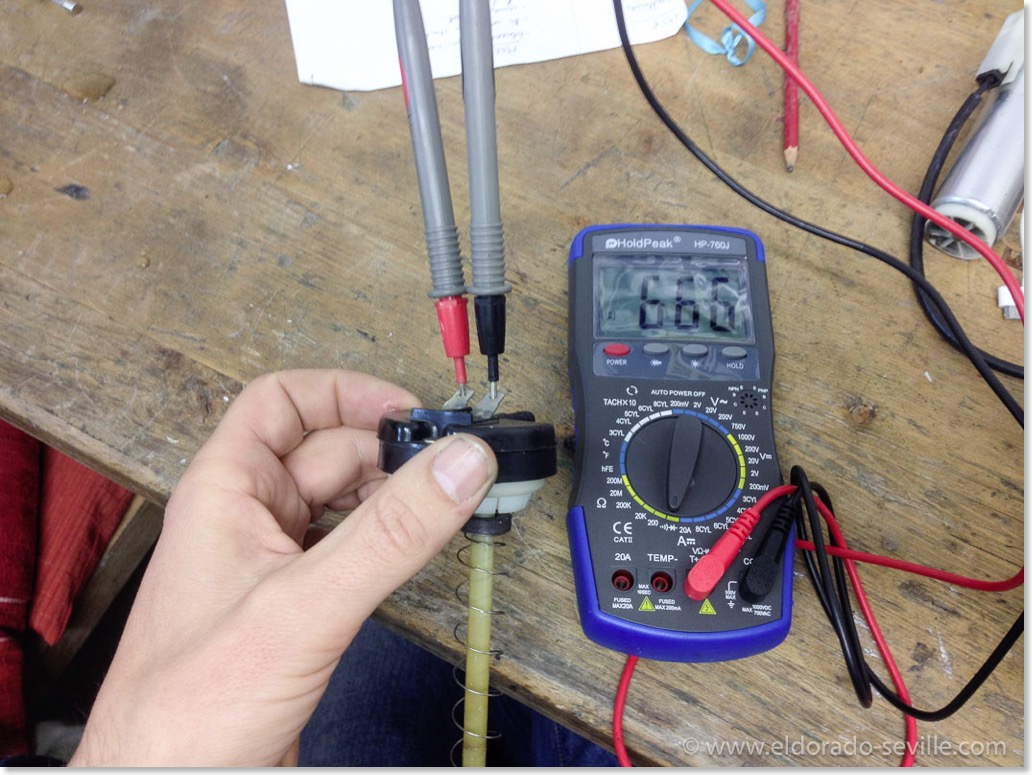
I checked the switch with a voltmeter.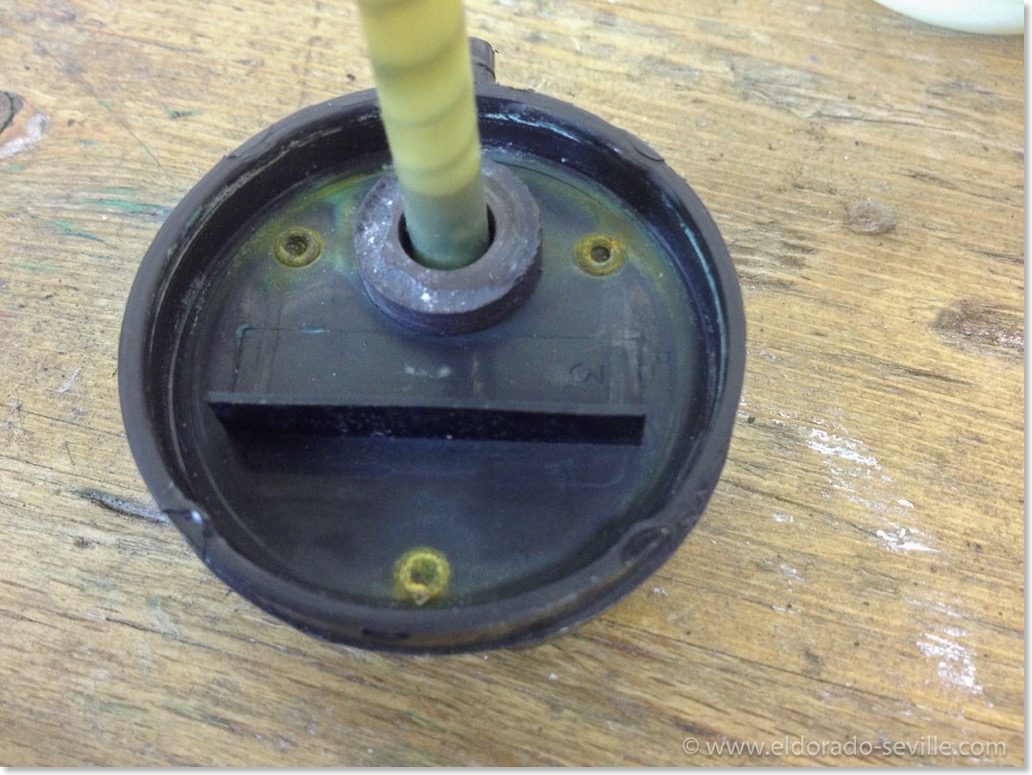
You have to get the rivets out if you want to access the switch.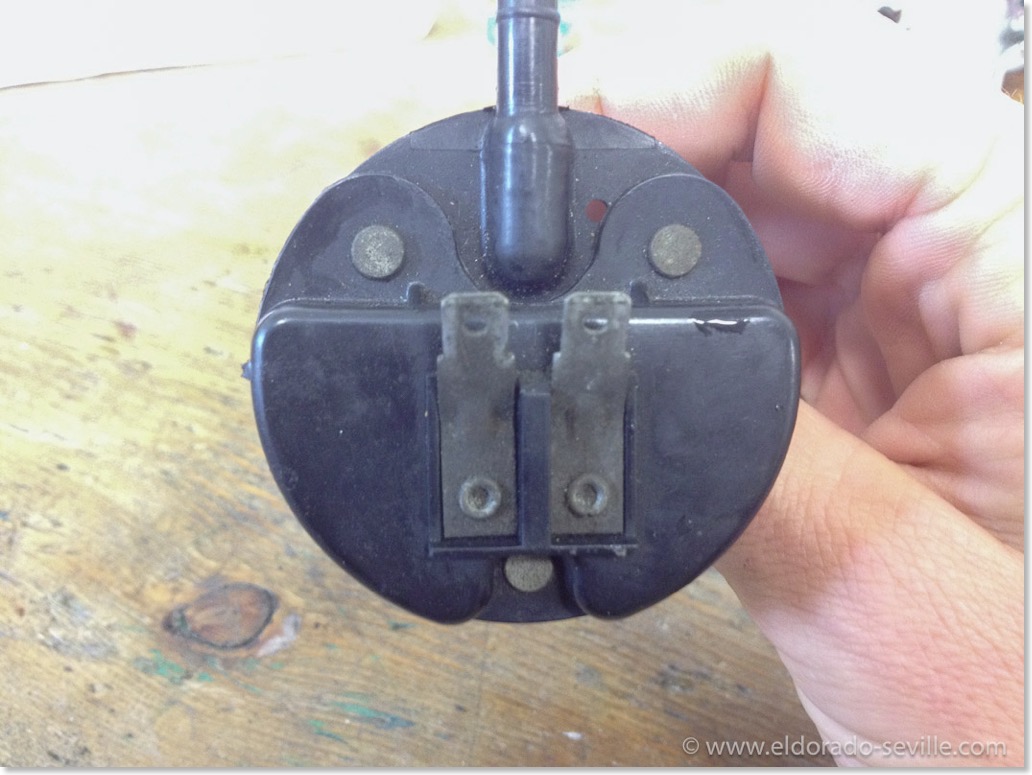
The reed switch is under this cap.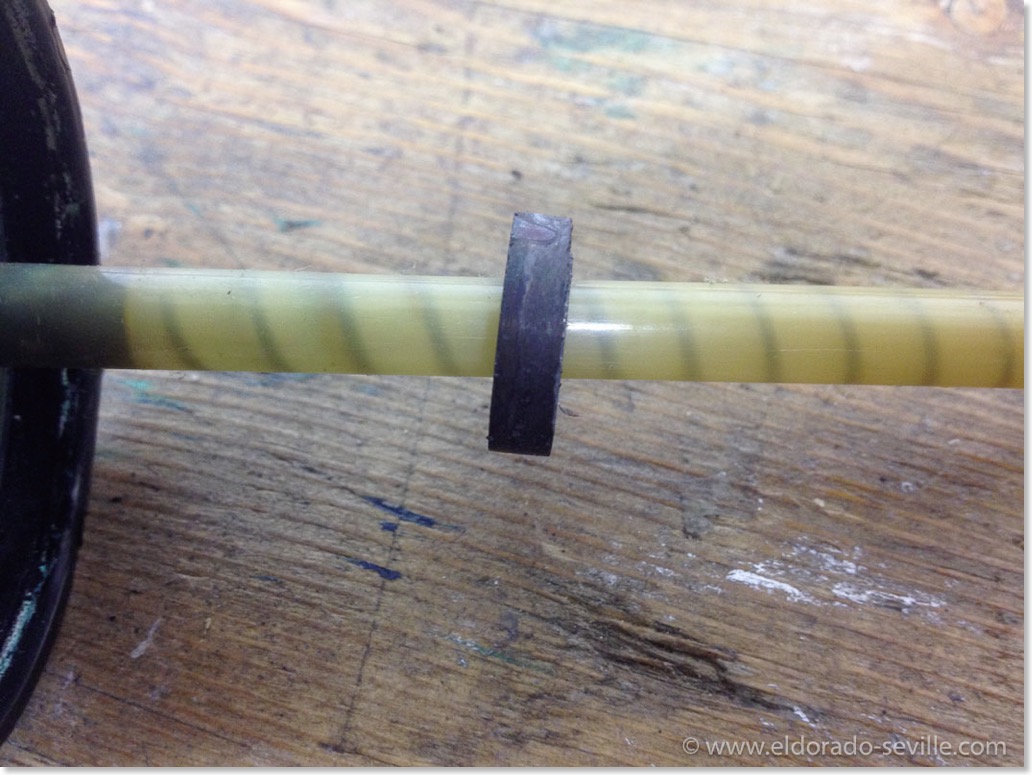
The magnet which is normally activating the reed switch.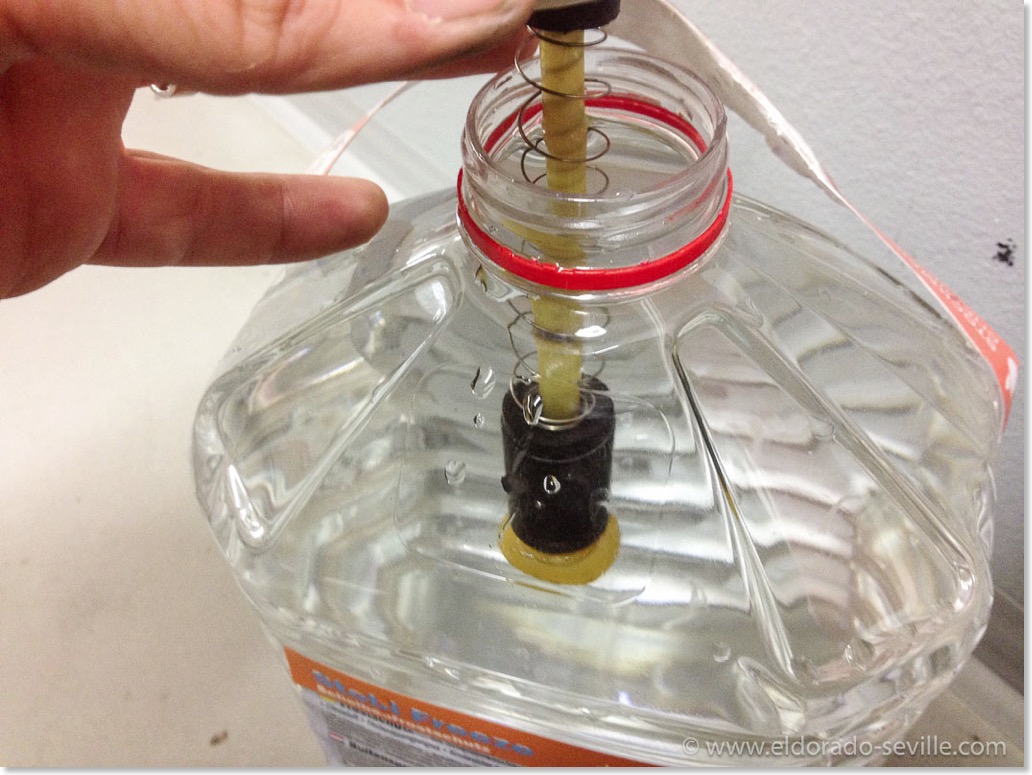
When I tested the float it sank…
REPAIRING THE 1978 ATC PROGRAMMER (AGAIN)
***This is an update to an older article as I had a very similar problem in the past already.***
I finally found the time to take the 1978 Eldorado out of winter storage. It started right up after many months of inactivity and I checked all accessories and options for operability.
Everything checked out fine but the air-condition… It only blew warm air out of the heater outlets and would not change modes, blower speed or temperature.
I immediately suspected a problem in the ATC programmer again. I already fixed it last year when the system would only work in full AC mode.
Last time I had a bad contact at the transducer which is the most important part in the programmer as it regulates the vacuum supply to the system.
The shop manual mentions that when the system is stuck in full heater mode, most probably an electrical problem is the main cause.
So I tried to push the transducer in again but the system did not come back to life like it did last time when I did this.
The MKII programmer which you can access through the glove box had to come out again for inspection.
This is how it looks with the cover removed:

The 1978 MKII programmer with the cover removed.
I decided to take the transducer/amplifier board out of the programmer this time to see where the problem could be. It can be removed very easily - it's only held in place by 4 screws. Be careful not to turn the gear wheel with the potentiometer though as you would have to recalibrate it again afterwards.
After the board came out, I quickly found out where the problem was. Below is a picture of the removed board:
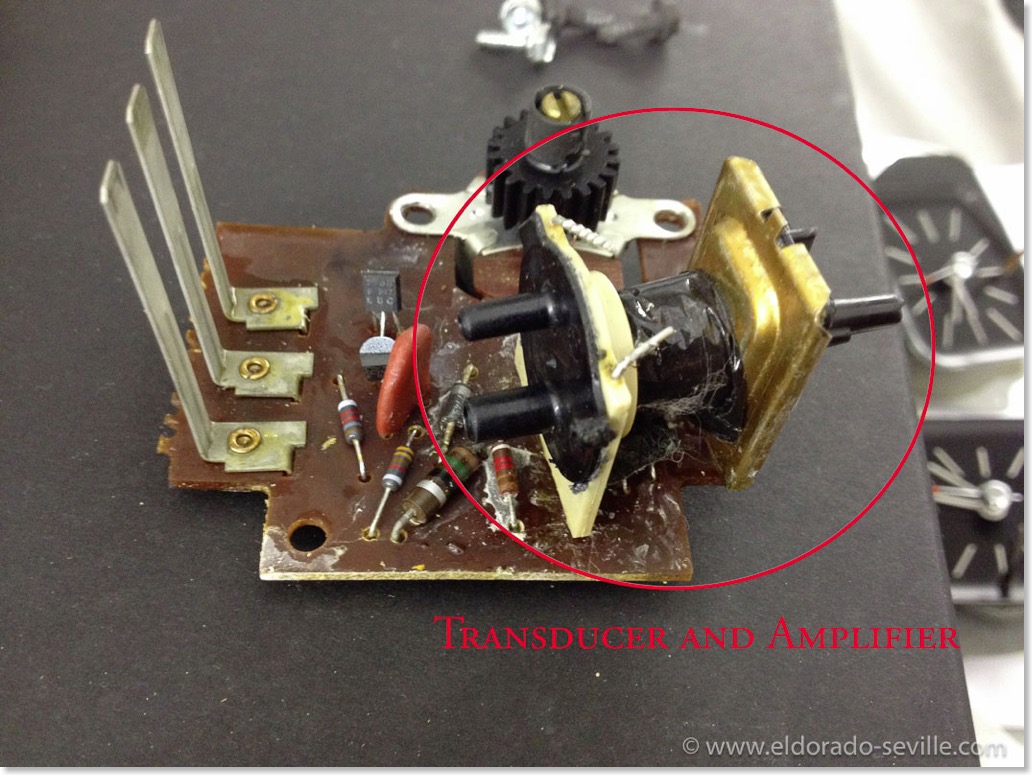
The transducer/amplifier board.
The transducer/amplifier unit was sitting pretty loosely on the circuit board, and one of the very thin and fragile wires going to the coil was broken, as you can see on the picture below:
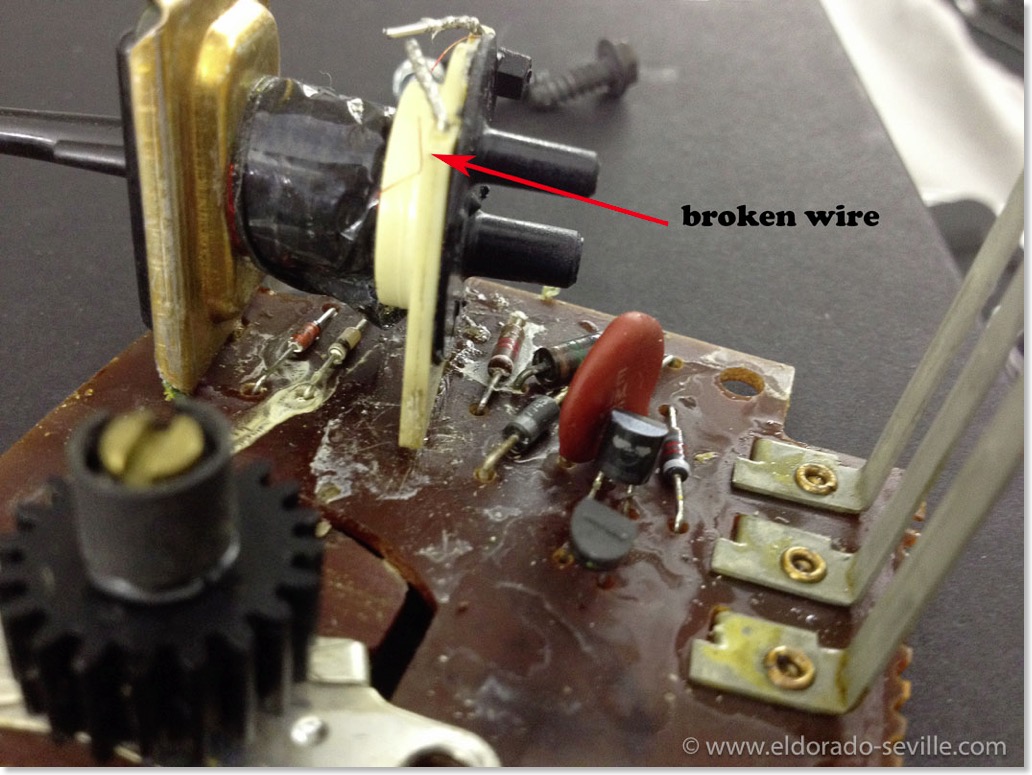
A broken wire at the coil of the transducer.
When I turned the circuit board around I could see that the soldering points on the circuit going to the transducer and the amplifier were broken and that they no longer were making good contact. That was the reason why the system did no longer work.
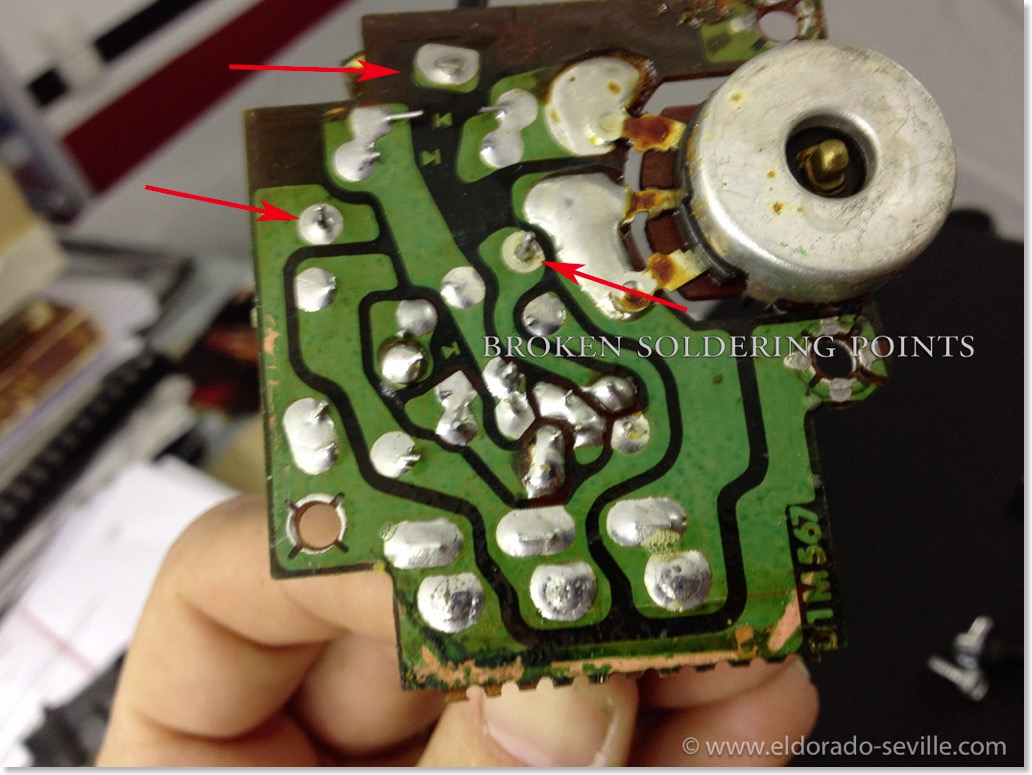
Broken soldering points at the rear of the circuit board.
The pretty simple solution was to re-solder the 3 soldering points and fix the broken wire going to the coil. I then put everything back together and now have a perfectly working ATC again. These old circuit boards can be very troublesome and I think that most of the time when a programmer goes bad on these 70s cars its probably a fixable problem like this. I was very worried that I would need an expensive rebuilt programmer and I am very glad that I could fix it by myself.
I have no idea though why everything worked when I put the car into storage last fall and how it broke while the car was inoperative…
Check my older post of the MKII programmer to also see the electrical diagram for the ATC system.
HAUS OF HOT ROD PHOTOSHOOTING WITH A 1935 LASALLE
He also owns some amazing Cadillacs and now he found a 1935 LaSalle that he literally pulled out of a barn a week ago.
So we had to go there and take a couple of pictures of his newest acquisition.
You can find the resulting 22 images from the shooting in this gallery.
Thanks Sepp for the cool photo shooting.
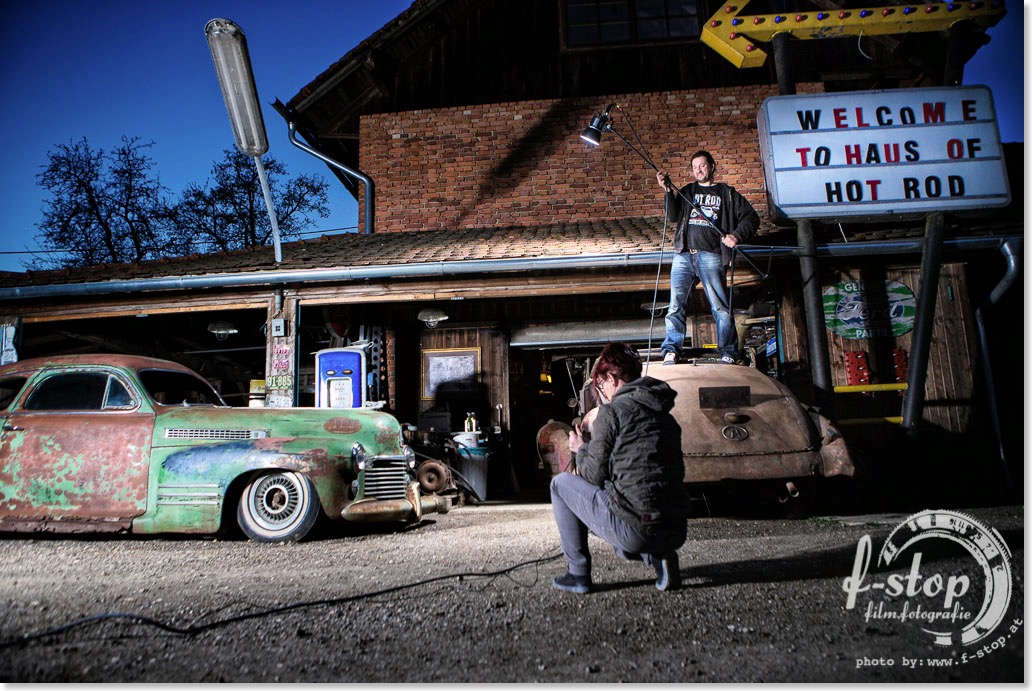
A look behind the scenes of the photo shooting. My wife is the photographer, while Sepp helped with holding the flash light.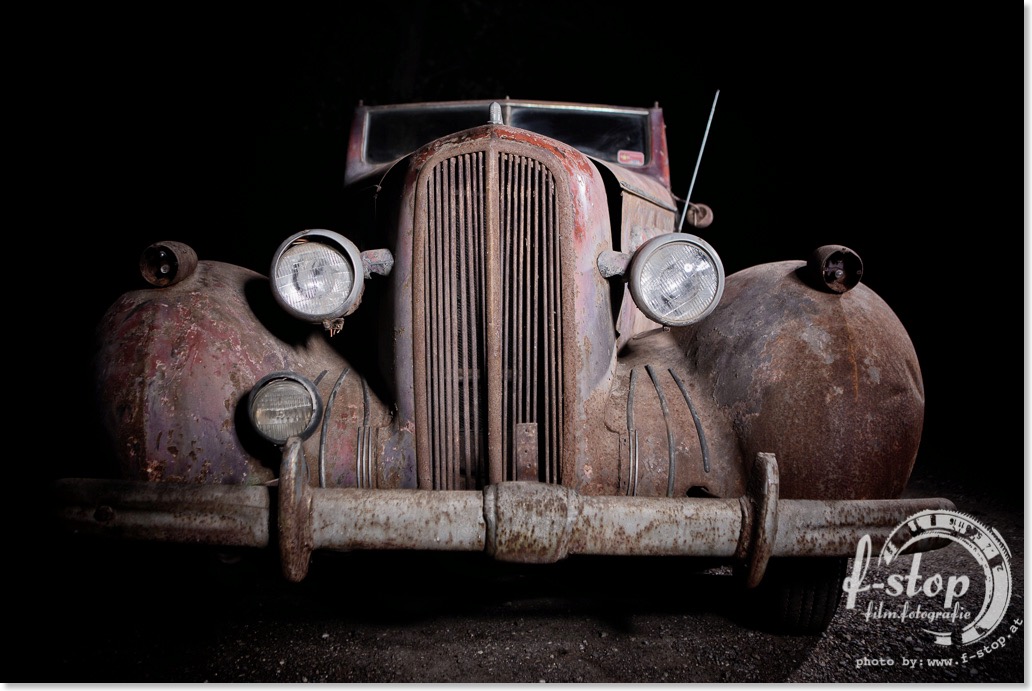
A 1935 LaSalle Convertible which came out of a barn.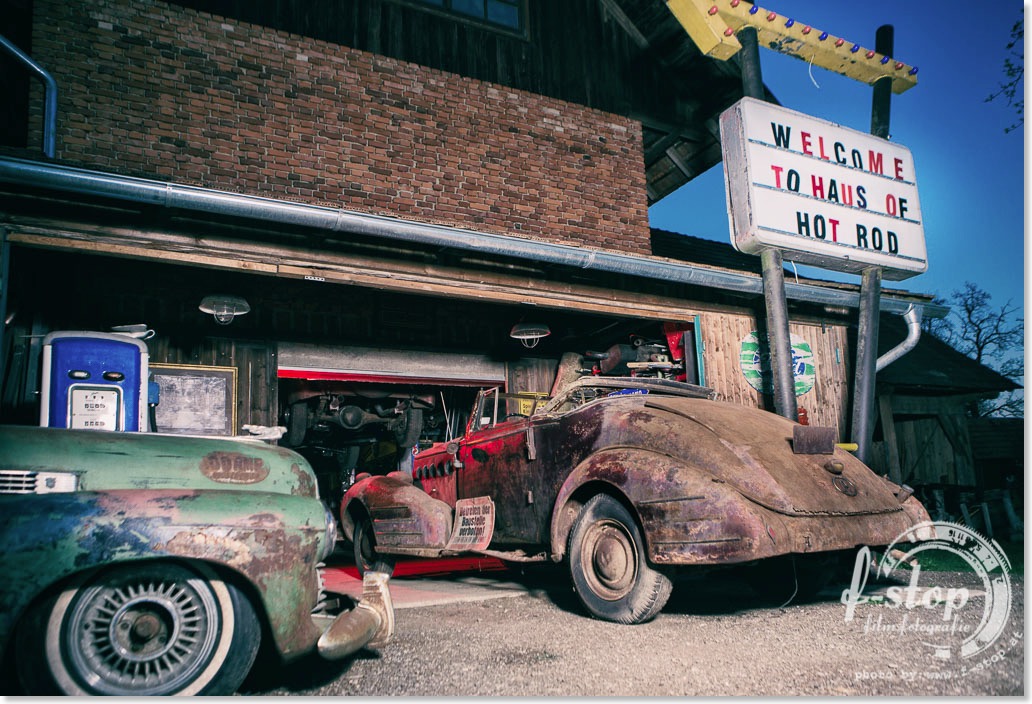
In front of the "Haus of Hot Rod"
1978 CADILLAC ELDORADO BIARRITZ RADIO REPAIR
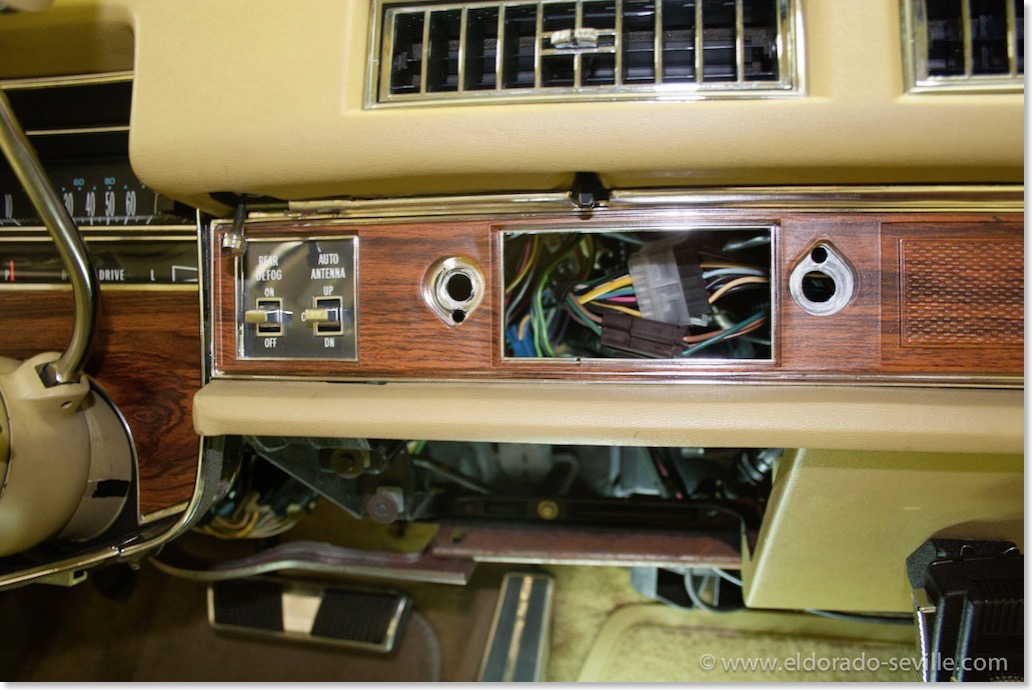
You have to remove the ashtray and part of the lower dash to get the radio out.
Before the spring season will start in May, I want to make sure that all my cars are in top notch condition until then.
The radio on my 78 suddenly died last summer. I was driving the car and the radio and 8-track and CB worked flawlessly. It had great sound and everything worked.
Suddenly, when I wanted to turn the volume down a little bit, the antenna retracted, and the radio went off completely and I could not turn it on again. I also could no longer operate the power antenna.
When I was home I discovered a blown fuse and replaced it, but it immediately blew again when I wanted to turn the radio back on.
I took the radio out now, and measured the power source, and I can clearly see that there is a problem somewhere inside the radio.
It looks like the power source is defective.
My friend Steve who is really good in repairing older radios offered to have a look at it. Unfortunately I cant fix this myself, as I have no clue how this could be repaired, or what could be defective…
Its great to have such good and competent friends who can fix such things.
In a very short time Steve found out what was wrong with the radio. One of the many condensators on the radio got dry over the years and caused a short. Steve replaced the broken condesator and even replaced all the other old ones with new ones to make sure that the radio will last for a long time.
I can´t thank Steve enough for fixing the radio for me. It is very important for me to know that it works again - I hate when things do not work properly on a Cadillac.
When I installed the radio back into the car, it came back to life, but the FM functionality did no longer work, and it was stuck in AM mode. 8 track and CB worked perfectly, but I could not switch to FM mode.
So Steve was so kind to disassemble the radio once again, and found the problem with a disengaged spring which could no longer activate the AM/FM switch.
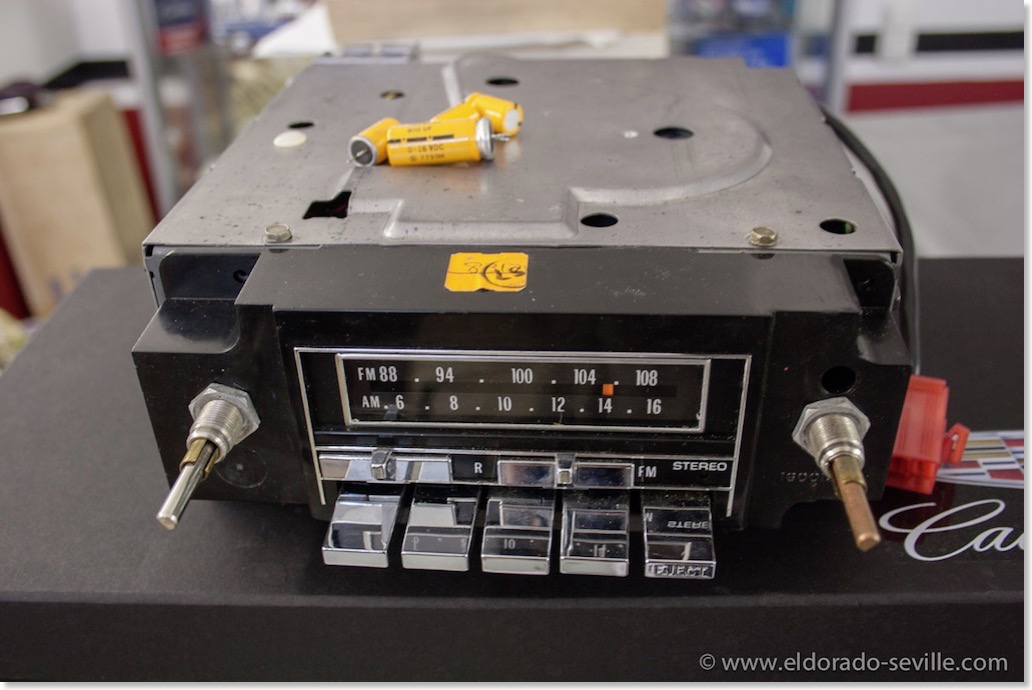
The radio is out of the car - it's the one with 8-track and CB - the most expensive one available in 1978. You can see the replaced condensers on top of the radio.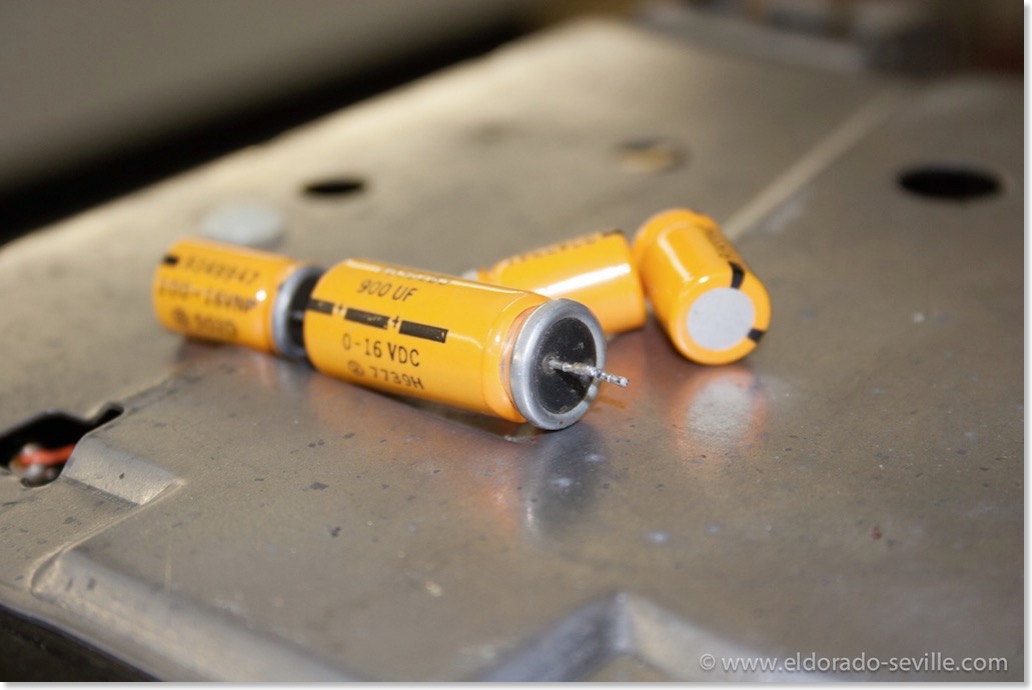
This bigger condenser was the cause for the trouble - it got dry inside and caused a short. The others were exchanged as well as a precautionary measure.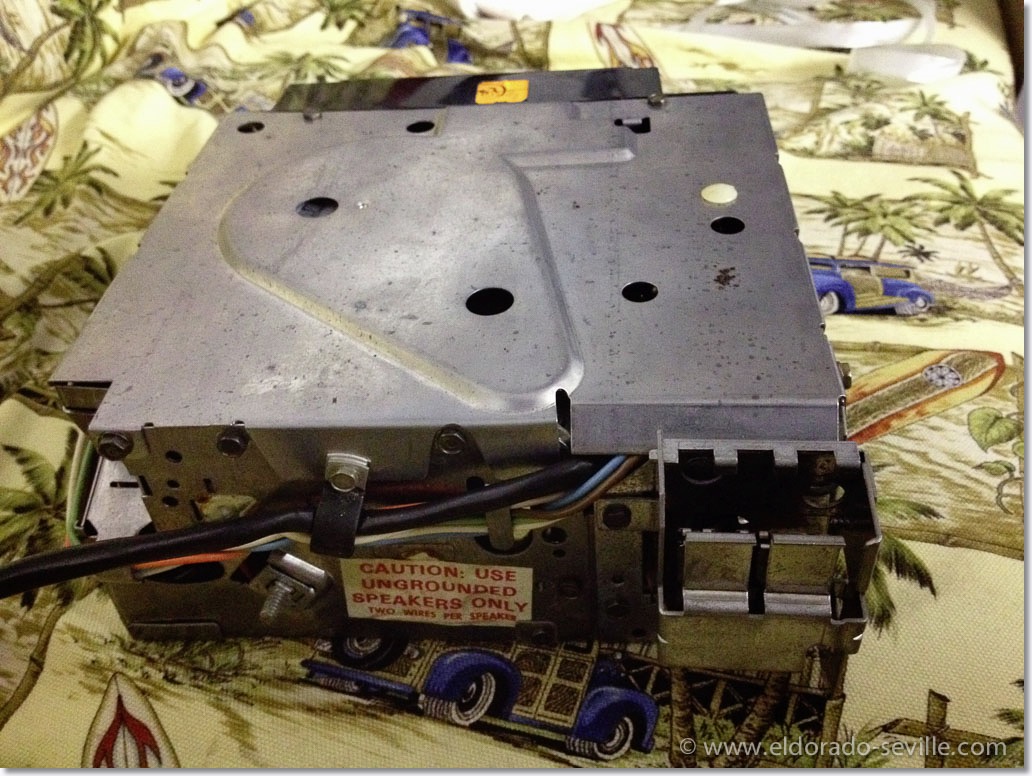
The back side of the radio.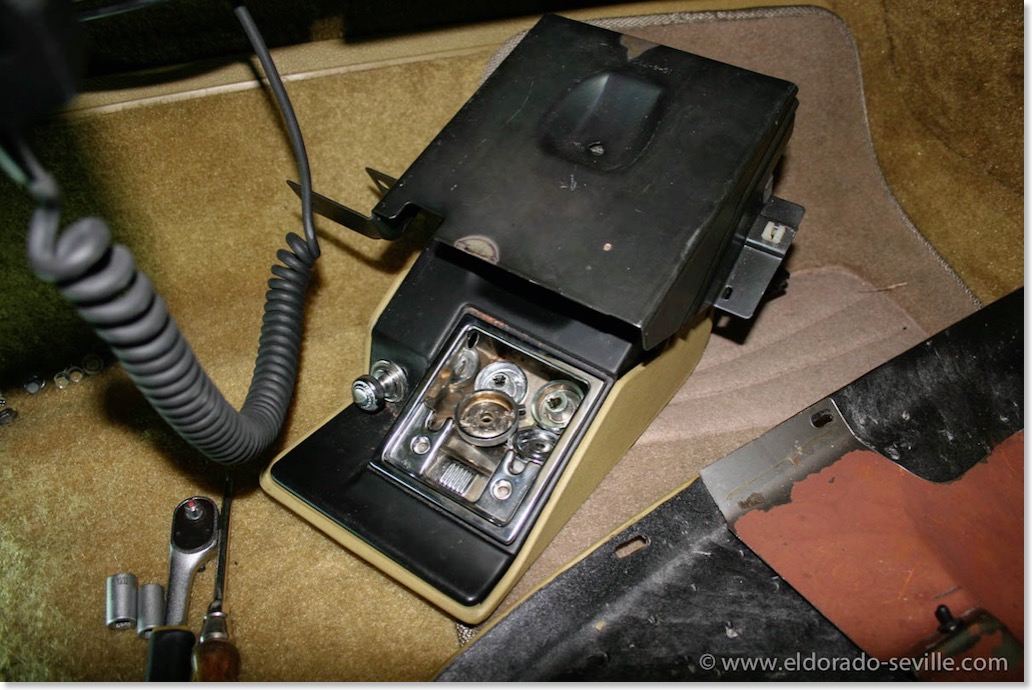
You have to remove the ash tray assembly to get the radio out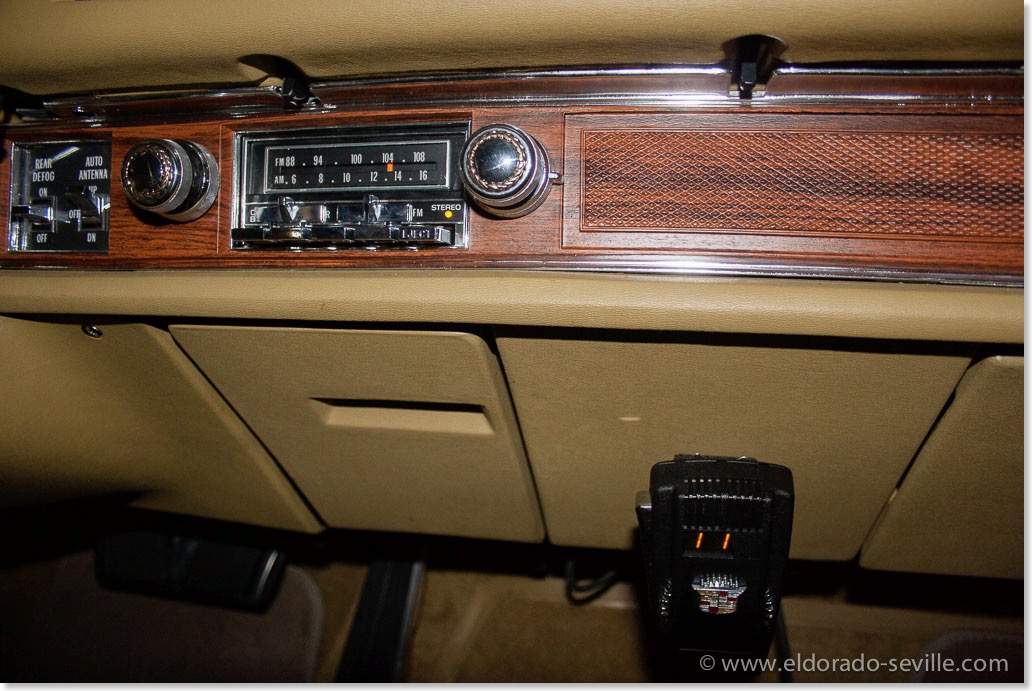
The radio works again and is back in the dash. 8-track and CB work perfectly as well.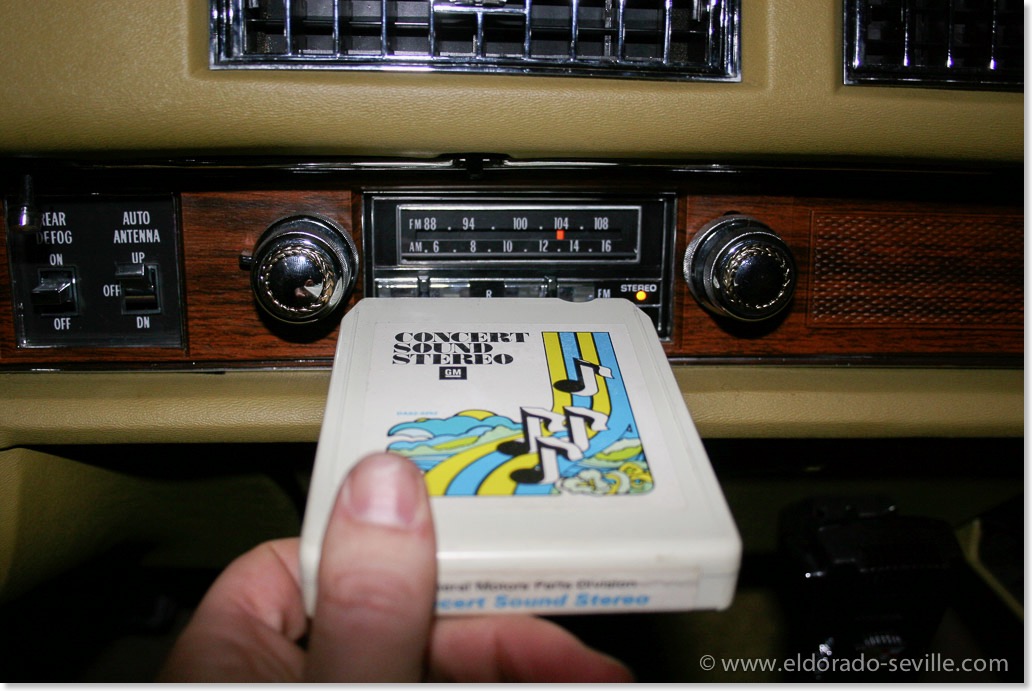
The GM demo tape which came with the car sounds amazingly good. Love the sound.
While I was working on the car I finally repaired the glove box light switch which had a problem since I got the car. I got a new switch from Arizona Vintage Parts and it now works perfectly again.
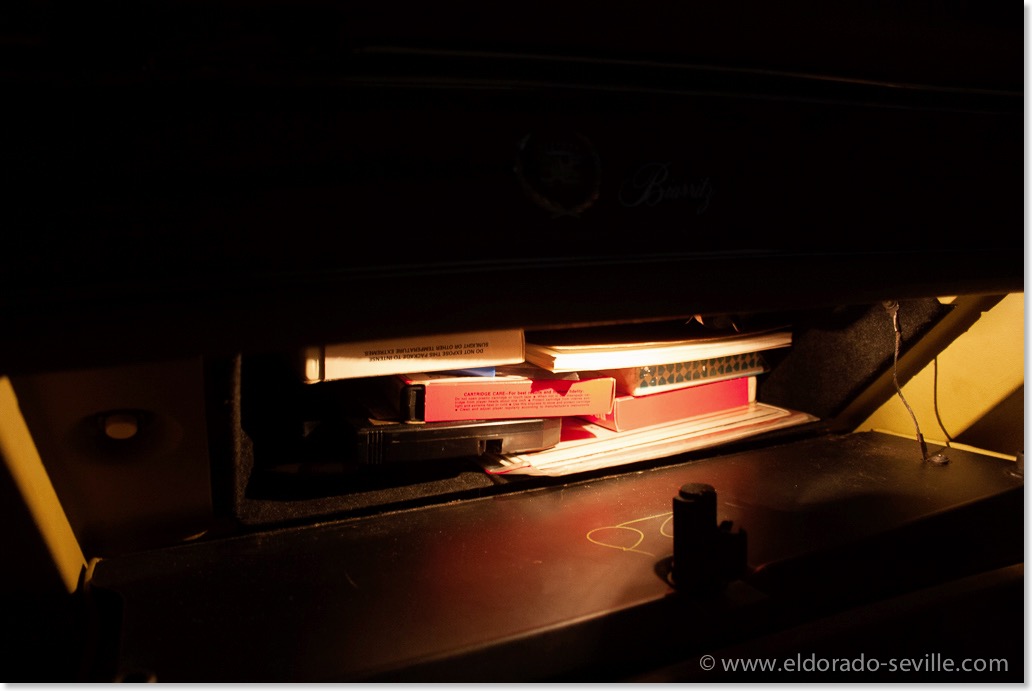
The glove box light is back in working order.
REPLACING THE HOT WATER VALVE
I also replaced the cars original hot water valve, which had a leak at the vacuum diaphragm and could not close any longer.
I found a perfectly working NOS replacement on ebay for it, as the one I got from Rockauto before looked completely different.
WEBSITE COMPLETELY RE-LAUNCHED TO VERSION 6.0
The first update followed in 1998 after the restoration of the 67 was finished.
Over the years the website became more complex and technically sophisticated.
Today I launched V6.0 of my website with a more modern design. The new website is responsive - meaning it will change depending on the resolution of your screen and will look great on mobile devices like phones and tablets as well as in the browser of your computer. I had to reprogram my website as I had some troubles with updates and some pages not working on all devices.
The update also contains lots of new posts about my cars and what I have done over the winter. Some older image galleries were not updated for the new version.
It took weeks to rebuild my website and I hope that you like it. There are probably a few errors or dead links left as I am continuing to work through the site. Please let me know if you find any errors.
Below you can find some screenshots where you can see how my website changed over the years. Unfortunately I do not have a screenshot of my first website.
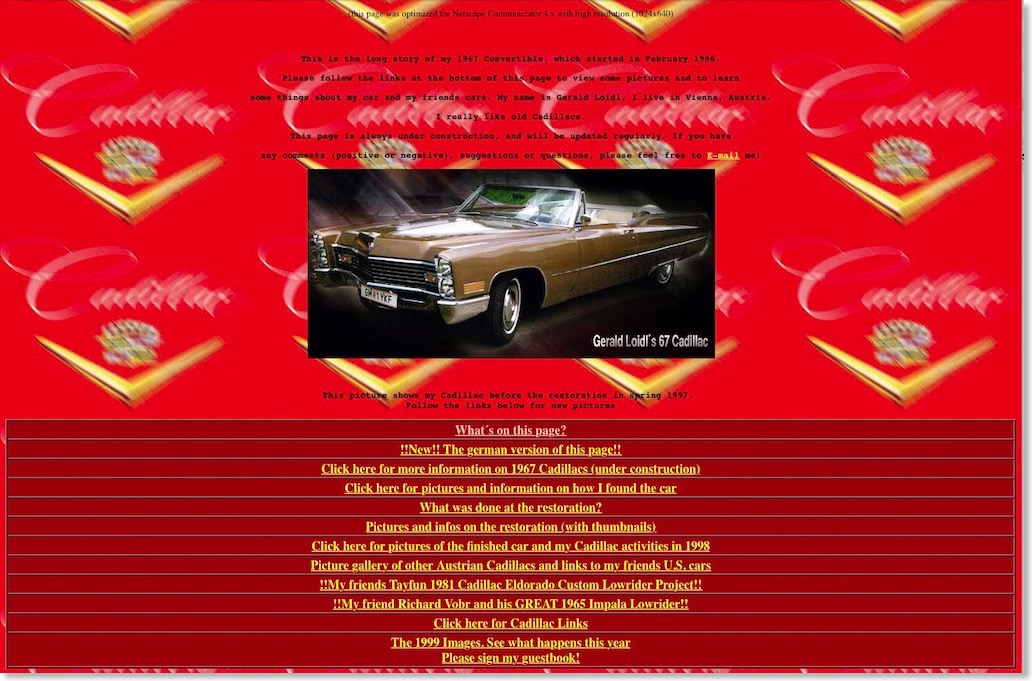
My second website when I only owned my 67 DeVille: V2 from 1998 - 2000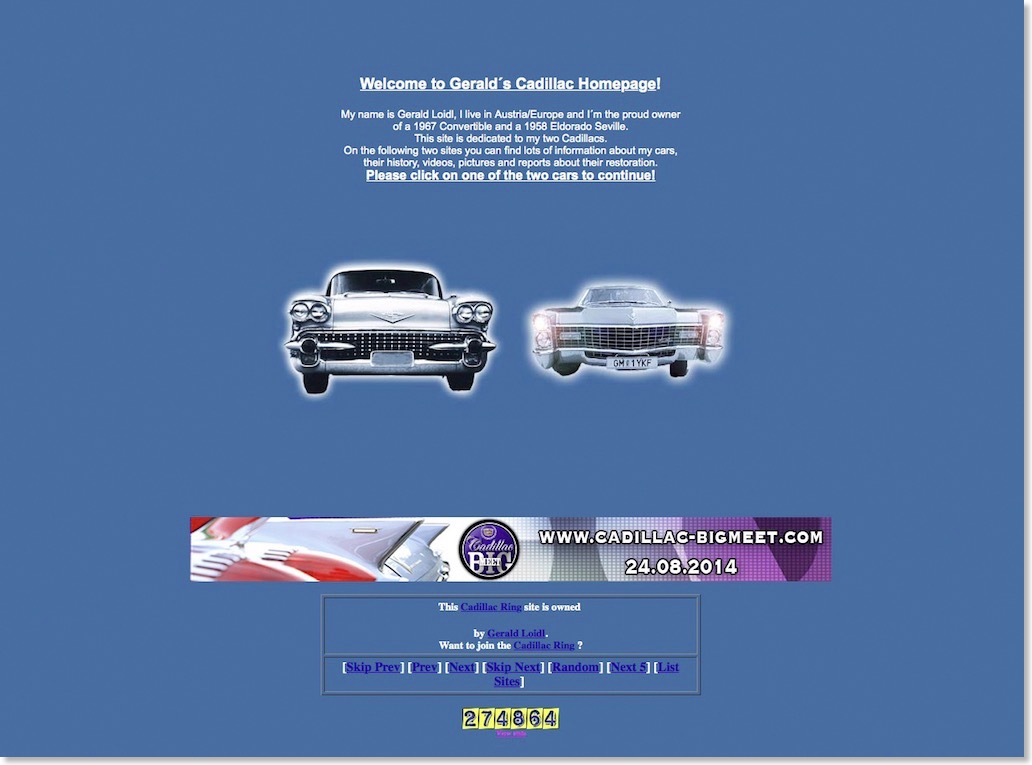
Later I got the 58 Eldorado Seville and made a new website for it: V3 - 2000 - 2007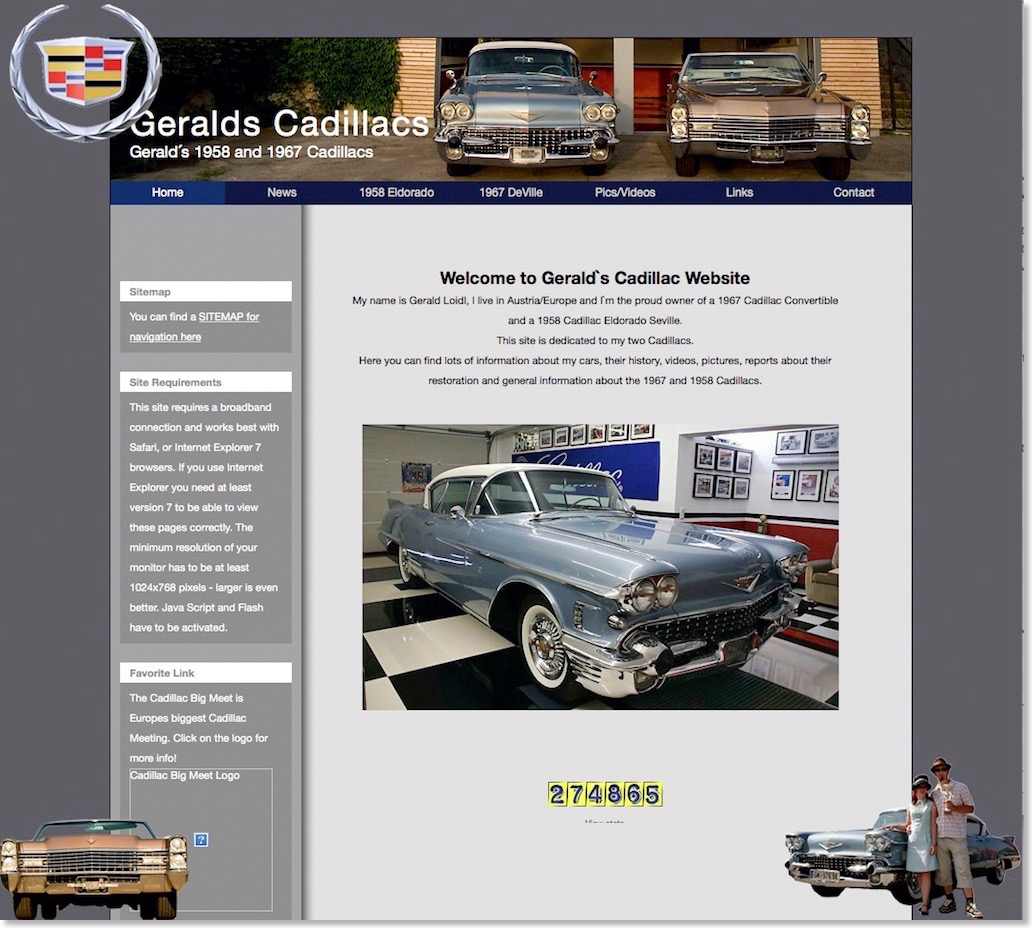
A more modern design followed: V4 2007-2009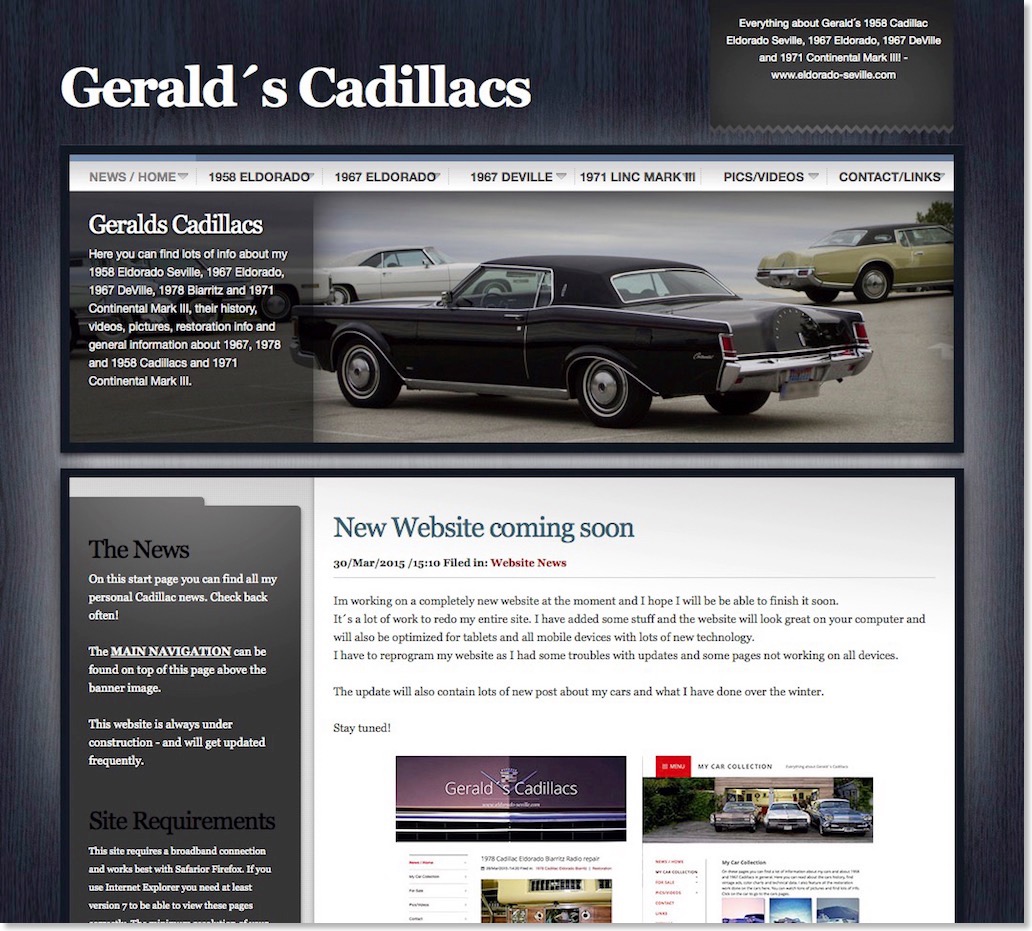
I had to add a few cars and make a new website: V5 - 2009 - 2015
REPAIRING THE SEAT BACK LOCKS OF THE 1974 (AGAIN) AND NEW POWER ANTENNA INSTALLED
I found a way to remove the seat back lock mechanism without disassembling the whole front seat and replaced the mechanism with one which I got from my favorite Cadillac Parts vendor - Arizona Vintage Parts. As always they delivered a perfect part and it only took me half an hour to remove the old part and install the new one.
The function of this lock is that it latches the seat backs in place when the doors are closed. The lock disengages and unlatches when the door is opened, so that rear passengers can simply fold the seat backs away when entering or leaving the car, without having to push a button.You can hear this "Automatic Seat Back Release" working when you open or close each door.
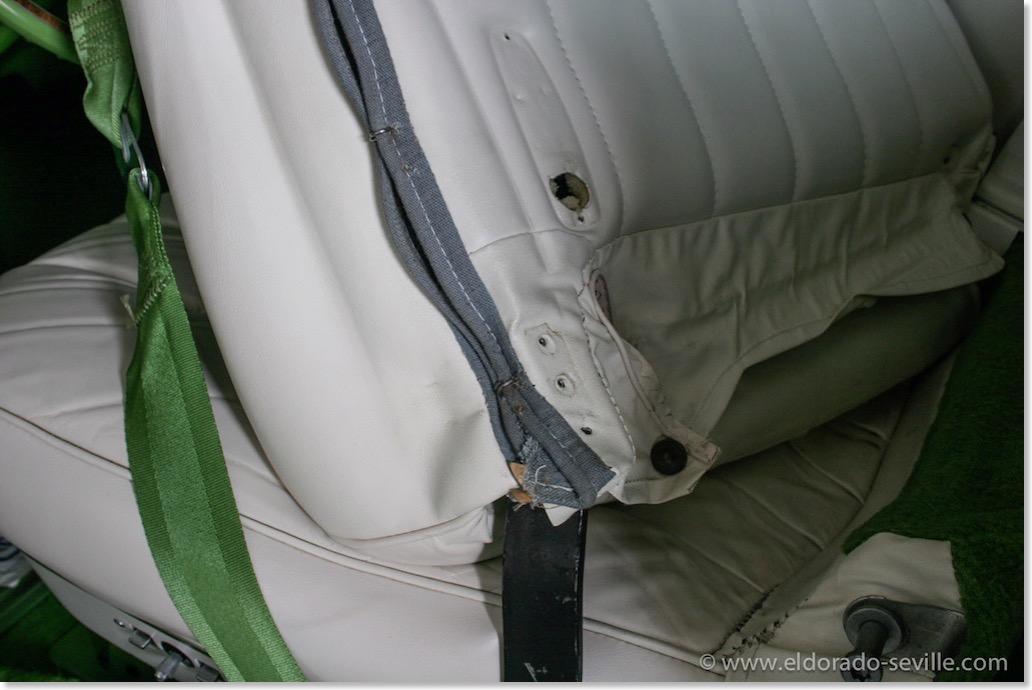
After removing the plastic covers around the seats - it will look like this. The seat back lock mechanism is hiding inside under the seat back.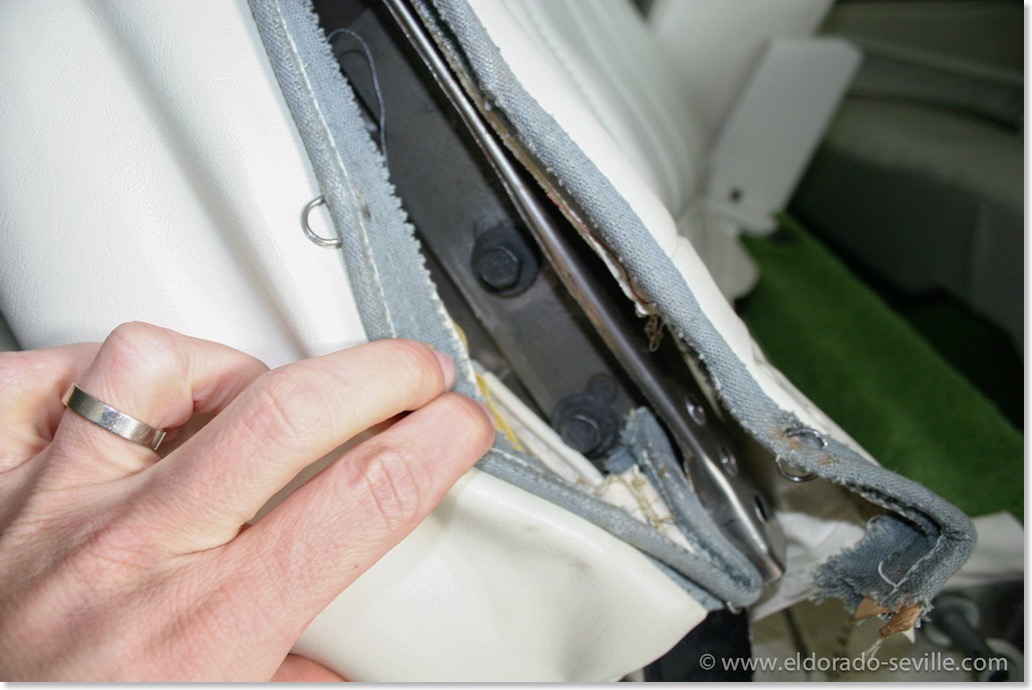
You have to remove the lower 3 hog rings to get access to the two mounting screws.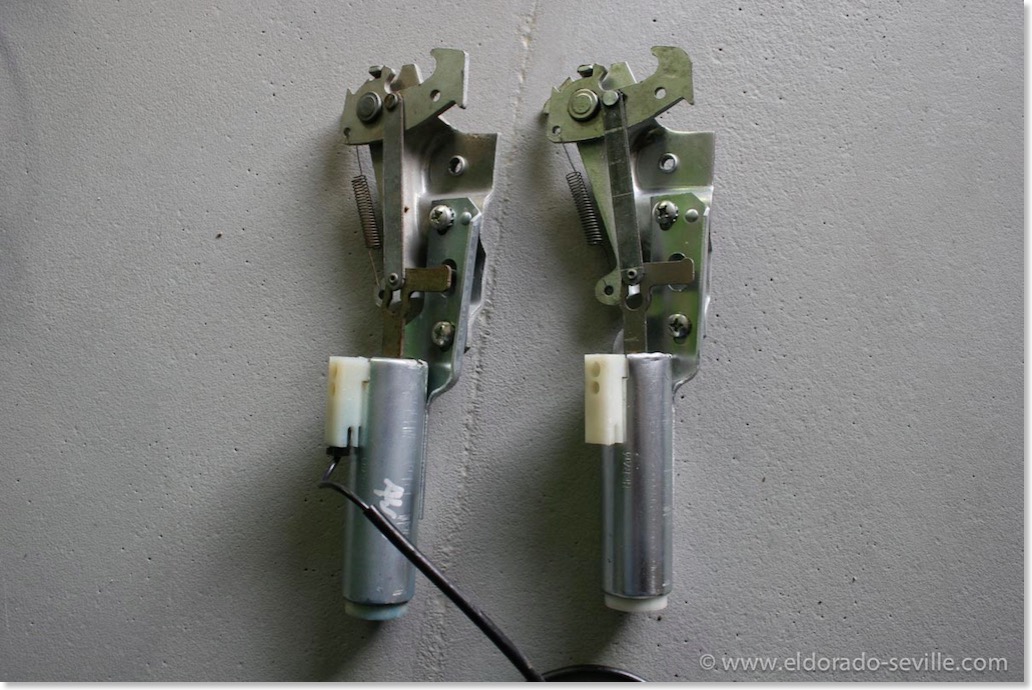
The new mechanism I got from AVP on the left and the old original one which does no longer work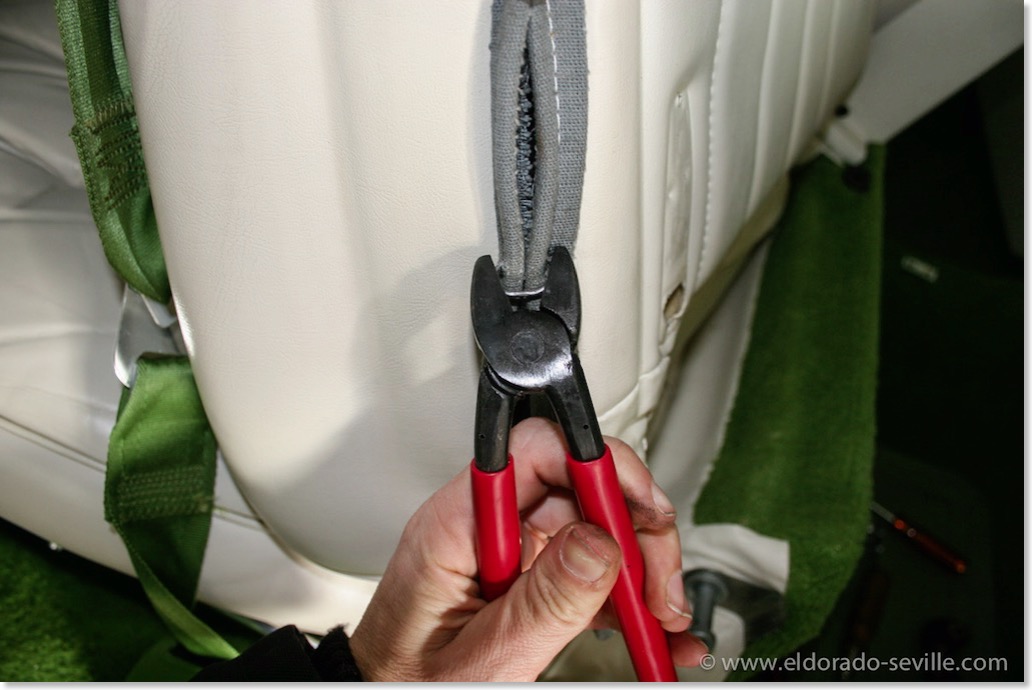
After installing the new part all you need to do is to install the hog rings again and install the seat cover surround moldings. Here I´m using a hog ring plier - but you can use some simple other pliers as well.
DEFECTIVE POWER ANTENNA
I also had to replace the defective power antenna of the 74. The original one had a burnt motor and also the gears and the whole mechanisms were broken. I can´t imagine how this could have happened. When the antenna died it also burnt the fuse. After inspecting the power antenna I decided that it was not rebuildable and ordered a rebuilt one from Arizona Vintage Parts as well.The antenna can be removed very easily on the 74 - so much easier than on my 60s cars. I was able to switch it out within 10 minutes. It works perfectly now.
It´s very important to me that all things on a Cadillac do work like they should.
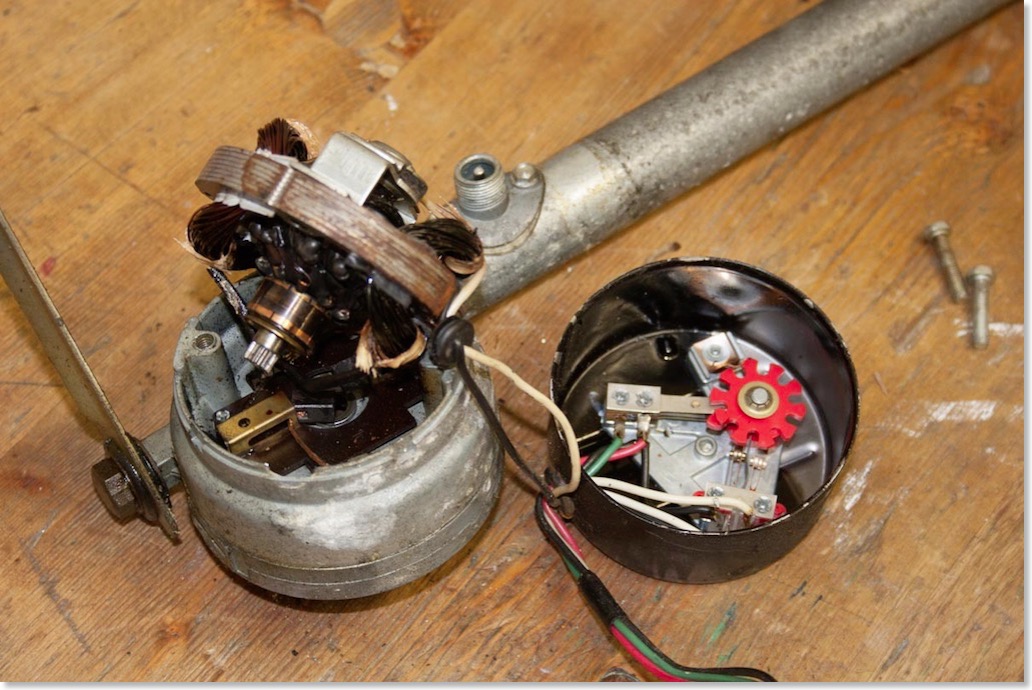
This is how the disassembled original power antenna looked like when taken apart - you can clearly see that the motor was burnt.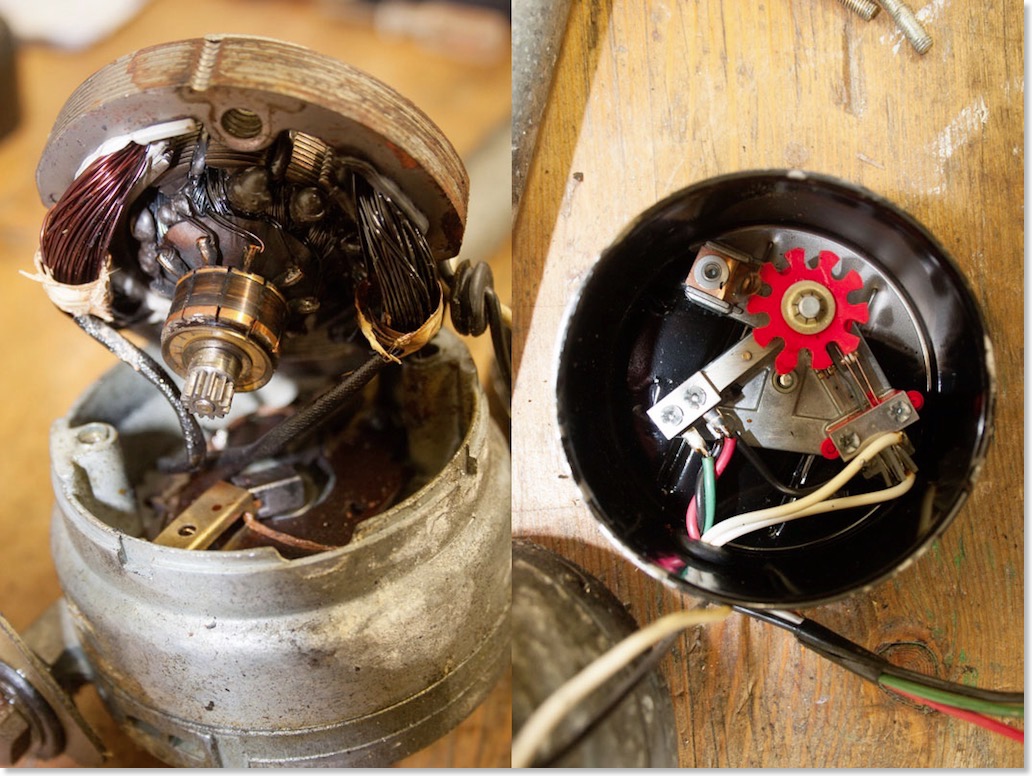
This is how the disassembled original power antenna looked like when taken apart - you can clearly see that the motor was burnt. Also the mechanism itself was damaged.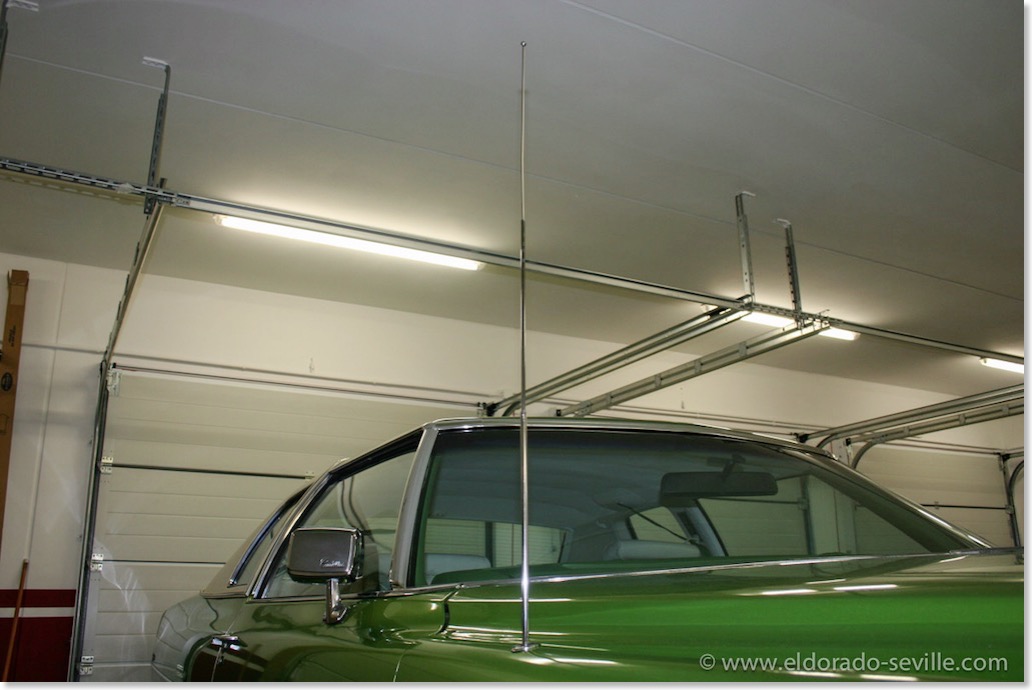
The 74 has a working power antenna again.
1966 Cadillac Coupe deVille (16)
1967 Cadillac DeVille (54)
1967 Cadillac Eldorado (73)
1971 Lincoln Continental Mark III (24)
1974 Cadillac Coupe deVille (46)
1978 Cadillac Eldorado Biarritz (25)
1996 Buick Roadmaster (20)
Cadillac BIG Meet (2)
Car Shows (55)
Cruising (4)
CT6 (1)
For Sale (3)
Garage Stuff (32)
Pacer (1)
Restoration (140)
Various (55)
Video (20)
Website News (31)
- 6 way power seat
- 8-track
- 10 Ohm
- 429
- 1932
- 1957
- 1958
- 1958 Cadillac Eldorado Seville
- 1958 Cadillac Repair Tip
- 1959 Cadillac Eldorado Seville
- 1964
- 1965
- 1966
- 1966 Cadillac Coupe deVille
- 1966 Cadillac Repair Tips
- 1967
- 1967 Cadillac DeVille
- 1967 Cadillac Eldorado Repair Tip
- 1967 Cadillac Repair Tip
- 1967 Eldorado
- 1968
- 1970 Cadillac Eldorado
- 1971
- 1971 Lincoln Continental Mark III
- 1974
- 1974 Cadillac Coupe DeVille
- 1974 Cadillac Repair Tip
- 1976
- 1977
- 1978
- 1978 Cadillac Eldorado Biarritz
- 1978 Cadillac Repair Tip
- 1980 Cadillac Eldorado Biarritz
- 1996
- 2012
- 2014
- 2017
- 2018
- 2019
- 2022
- 2023
- 2025
- 3063206
- 7027235
- 7800483
- 7805675
- 7805676
- 12355706
- 17058531
- 17059968
- 17059969
- 22010515
- 22010661
- A.I.R
- A6
- AC
- AC Compressor
- AC Electrical Diagram
- ACC
- Accelerator Pump
- Accelorator pump
- Accident
- Actuators
- Adriatic Blue Metallic
- Ads
- Aftermovie
- Air Pump
- Aircondition
- AIRPUMP
- ALC
- Alternator
- AM
- AM-Transmitter
- Antenna
- Anti Rattle Clips
- Antique Gold
- Arizona Vintage Parts
- Arrival
- Article
- ASC
- Ash Tray removal
- ATC
- Atlantis Blue Firemist
- Austria
- Austro Classic
- Autolite SP-459
- Automatic Seat Back Release
- Award
- Banner
- Barn Find
- Battery
- Battery Tray
- Beach Race
- Bearing
- Bendix
- Biarritz
- Bigfoot
- Bill Hirsch Engine Enamel
- Bleeder Screws
- Bleeding
- Blower
- Bodywork
- Bolts
- Book
- Borg
- Brake Booster
- Brake Fluid
- Brake Gray
- Brakes
- Broken Bolt
- Brougham
- Bucket seats
- Buick
- Bumper End
- Bushings
- Cadillac
- Cadillac BIG Meet
- Cadillac BIG Meet
- Cadillac birthday cake
- Cadillac Blue
- Cadillac Color Selections Dealer Book
- Cadillac Coupe deVille
- Cadillac Dealer
- CADILLAC GRAND EUROPEAN
- Cadillac Meeting
- Cadillac Mini Meeting
- Camaro RS
- Caorle
- Car Show
- Carburetor
- Card
- Carpet
- Carter AFB
- Cavalry Twill Vinyl
- CB
- CBM
- CCCD
- Choke
- Christmas
- Citizens Band
- Classic Cadillac Club Deutschland
- Clay Towel
- Cleaning
- Clock
- Clockwork
- Clutch
- Clutch Coil
- Collector
- Colonial Yellow
- Color Coded Springs
- Commercial
- Compound
- Compressor
- Condenser
- Continental Mark III
- Control Head
- Conversion
- Convertible top
- Coolant
- Corona
- Cowl
- Cruise Control
- Cruising
- CT6
- CV Boots
- CV JOINTS
- D6230
- Dash Trim
- Decal Removal
- Decals
- Decoration
- Dehumidifier
- Delco Moraine
- Der Standard
- detailing
- Deville
- Diagnosis Chart
- Diagram
- Dial
- Digital Rotary Drum Clock
- Diner
- Disc Brakes
- Distributor
- Diverter Valve
- Door Jamb Switch
- Door Rubber Conduit
- Dornbirn
- Dot3
- Drive Shaft
- Driving tour
- Drum brakes
- Dry Ice Blasting
- Dry Ice Cleaning
- DVD
- Eastwood
- Eldorado
- Electric Choke Thermostat
- Electrical schematic
- Elvis
- Engine Bay
- Ep
- Epoxy floor
- Europe
- Evaporator
- Exide
- Factory Markings
- Fender Skirt
- Floor
- Flushing
- Flyer
- Foam
- For Sale
- Front AXLE
- Front brakes
- Front bumper filler
- Front Floor
- Front wheel bearing
- Fuel Filter
- Fuel Pump
- Fuel Sending Unit
- Fusible Link
- Garage
- Garage Cabinets
- Gasket
- GE
- Gear indicator
- General Time
- Glove box light
- Grand European
- H4
- Haus of Hot Rod
- Headlight Actuator
- Headlight doors
- Headlights
- Heater Core
- Heater Hose
- Heater Valve
- High Idle
- History
- Holley
- Honest John
- Hood
- Hood Emblem
- Hood Ornament
- Hose Clamp
- Hot Choke
- Hot Water Valve
- HotRod
- How to
- Hödlmayr
- Ignition Diagram
- Illuminated Entry
- John D‘Agostino
- John Foust
- Klassikwelt Bodensee
- Kremsmünster
- LaSalle
- Leather seats
- Light Switch
- Limited
- Lincoln
- Lincoln Mark III Repair Tip
- Low Mileage
- Magazine
- Marilyn Monroe
- Mark III
- Master Cylinder
- Master Switch
- Master Vacuum Switch
- Media Blasting
- Meeting
- Meguiras
- MK II
- Mobile
- Model
- Moldings
- Mom
- Mopar Nationals
- Mostkost Kustom
- Movie
- Munich
- Neon
- NOS
- Oberösterreicher des Tages
- oilchange
- ORF
- Overspray
- Pacer
- Paint
- Paint correction
- Paintjob
- Part Number
- Parts
- Patch Panel
- Perfect Circle
- Permabag
- Persian Lime
- Photo shooting
- Photoshooting
- Pictures
- PinUp
- POA Valve
- Power Antenna
- Power Servo
- Power Vent Windows
- Power Window
- Printed Circuit Board
- Programmer
- Pulley
- Quadrajet
- Quarter Panel
- Quartz Conversion
- R134
- Radiator
- Radio
- Rattle
- Rear brakes
- Rebuild
- Recalibrate
- RediRad
- Reed Switch
- Relais
- Relaunch
- Removing Overspray
- Repaint
- Repair
- Restoration
- RIP
- Roadhouse
- Roadmaster
- Rochester
- Rocker Arm Cover
- Rocker Panel Extension Clips
- Rostio
- Rotary Valve
- Rotterdam
- Rupes
- Rust removal
- Rust removal gel
- Sabre Wheels
- Sand Blasting
- Sandblasting
- Screed
- Season Greetings
- Seasons Greetings
- Seat Back Locks
- Seat Padding
- Seat Transmission
- See through ornament
- Self adjusters
- Self Starter
- Sepp's Garage
- Seville
- Sheetmetal
- Shocks
- shop manual
- short
- Sign
- Solenoid
- Spark Plug Wire Routing
- Speakers
- Special Award
- Speed Bleeder Screws
- Splash Guard
- Starter Diagram
- Starter Motor
- Steering Column
- Storage
- suction throttling valve
- sunroof
- suspension
- Swirl Mark removal
- Switzerland
- T3
- Taillight Cover
- Texan´s Choice Award
- Thermostat
- Tilt and Telescope
- Time capsule
- Tomsclub
- Torque Specifications
- Tower Hose Clamp
- Towtruck
- Trailer
- Transducer
- Transmission
- transmission control selector
- transmission control selector indicator light
- transmission shift indicator
- Treadle Vac
- Treffen
- Tri-Band
- Troubleshooting
- Trunk Cardboard Kit
- Trunk lid
- Trunk lining
- Trunk to bumper cover
- Turn Signal Switch
- TV
- Typisierung
- Ultimate Garage
- Underbody
- Undercarriage
- Undercoating
- Undercoating Removal
- Vacuum Booster
- Vacuum diagram
- Vacuum hoses
- Vacuum Master Switch
- Vacuum Schematic
- Vacuum Valve
- Valve Cover
- Various
- Vent Window Switch
- Vibration
- Vibrator
- Vicodec roof
- Video
- Vinegar
- Vinyl Roof
- Visitor
- Washer Fluid Float
- Washer Fluid Low Level Indicator
- Water Pump
- Wax
- Weatherstripping
- Website News
- Westclox
- Wheel Bearings
- Wheel Housing
- Wiesbaden
- Windlace
- Winter
- Wiring
- Wiring Diagram
- Wonderbar
- Workbench
- Zurzach
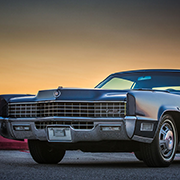 GERALD´S CADILLACS - NEWS
GERALD´S CADILLACS - NEWS